HTC GENE PDA Phone User Manual Gene AKU3 Generic English Manual indb
HTC Corporation PDA Phone Gene AKU3 Generic English Manual indb
HTC >
Users Manual

Pocket
User Manual

2
Please Read Before Proceeding
THE BATTERY IS NOT FULLY CHARGED WHEN YOU TAKE IT OUT OF THE
BOX.
DO NOT REMOVE THE BATTERY PACK WHEN THE DEVICE IS CHARGING.
YOUR WARRANTY IS INVALIDATED IF YOU OPEN OR TAMPER WITH THE
DEVICE’S OUTER CASING.
PRIVACY RESTRICTIONS
Some countries require full disclosure of recorded telephone conversations,
and stipulate that you must inform the person with whom you are speaking
that the conversation is being recorded. Always obey the relevant laws
and regulations of your country when using the recording feature of your
Pocket PC Phone.
INTELLECTUAL PROPERTY RIGHT INFORMATION
Copyright © 2006 High Tech Computer Corp. All Rights Reserved.
, , and ExtUSB are trademarks and/or service marks of
High Tech Computer Corp.
Microsoft, MS-DOS, Windows, Windows NT, Windows Server, Windows
Mobile, ActiveSync, Excel, Internet Explorer, MSN, Hotmail, Outlook,
PowerPoint, Word, and Windows Media are either registered trademarks
or trademarks of Microsoft Corporation in the United States and/or other
countries.
Bluetooth and the Bluetooth logo are trademarks owned by Bluetooth SIG,
Inc.
SD is a trademark of SD Card Association.
Java, J2ME and all other Java-based marks are trademarks or registered
trademarks of Sun Microsystems, Inc. in the United States and other
countries.
Copyright © 2006, Adobe Systems Incorporated.
Copyright © 2006, Macromedia Netherlands, B.V.
3
Macromedia, Flash, Macromedia Flash, Macromedia Flash Lite and Reader
are trademarks and/or registered trademarks of Macromedia Netherlands,
B.V. or Adobe Systems Incorporated.
Copyright © 2006, JATAAYU SOFTWARE (P) LTD. All Rights Reserved.
Copyright © 2006, Dilithium Networks, Inc. All Rights Reserved.
Copyright © 2006, Tao Group Limited. All Rights Reserved.
ArcSoft MMS Composer™ Copyright © 2003-2006, ArcSoft, Inc. and its
licensors. All Rights Reserved. ArcSoft and the ArcSoft logo are registered
trademarks of ArcSoft, Inc. in the United States and/or other countries.
All other company, product and service names mentioned herein are
trademarks, registered trademarks or service marks of their respective
owners.
HTC shall not be liable for technical or editorial errors or omissions
contained herein, nor for incidental or consequential damages resulting
from furnishing this material. The information is provided “as is” without
warranty of any kind and is subject to change without notice. HTC also
reserves the right to revise the content of this document at any time
without prior notice.
No part of this document may be reproduced or transmitted in any form or
by any means, electronic or mechanical, including photocopying, recording
or storing in a retrieval system, or translated into any language in any form
without prior written permission of HTC.
4
Important Health Information and Safety Precautions
When using this product, the safety precautions below must be taken to
avoid possible legal liabilities and damages.
Retain and follow all product safety and operating instructions. Observe all
warnings in the operating instructions on the product.
To reduce the risk of bodily injury, electric shock, fire, and damage to the
equipment, observe the following precautions.
ELECTRICAL SAFETY
This product is intended for use when supplied with power from the
designated battery or power supply unit. Other usage may be dangerous
and will invalidate any approval given to this product.
SAFETY PRECAUTIONS FOR PROPER GROUNDING INSTALLATION
CAUTION: Connecting to an improperly grounded equipment can result in
an electric shock to your device.
This product is equipped with an USB Cable for connecting with desktop or
notebook computer. Be sure your computer is properly grounded (earthed)
before connecting this product to the computer. The power supply cord of
a desktop or notebook computer has an equipment-grounding conductor
and a grounding plug. The plug must be plugged into an appropriate outlet
which is properly installed and grounded in accordance with all local codes
and ordinances.
SAFETY PRECAUTIONS FOR POWER SUPPLY UNIT
• Use the correct external power source
A product should be operated only from the type of power source
indicated on the electrical ratings label. If you are not sure of the type
of power source required, consult your authorized service provider or
local power company. For a product that operates from battery power
or other sources, refer to the operating instructions that are included
with the product.
• Handle battery packs carefully
This product contains a Li-ion battery. There is a risk of fire and burns
if the battery pack is handled improperly. Do not attempt to open or
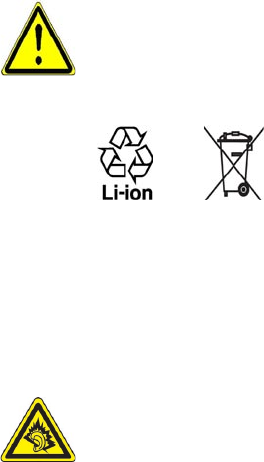
5
service the battery pack. Do not disassemble, crush, puncture, short
external contacts or circuits, dispose of in fire or water, or expose a
battery pack to temperatures higher than 60˚C (140˚F).
WARNING: Danger of explosion if battery is incorrectly
replaced. To reduce risk of fire or burns, do not disassemble,
crush, puncture, short external contacts, expose to
temperature above 60˚C (140˚F), or dispose of in fire or
water. Replace only with specified batteries. Recycle or
dispose of used batteries according to the local regulations
or reference guide supplied with your product.
SAFETY PRECAUTIONS FOR DIRECT SUNLIGHT
Keep this product away from excessive moisture and extreme temperatures.
Do not leave the product or its battery inside a vehicle or in places where
the temperature may exceed 60°C (140°F), such as on a car dashboard,
window sill, or behind a glass that is exposed to direct sunlight or strong
ultraviolet light for extended periods of time. This may damage the product,
overheat the battery, or pose a risk to the vehicle.
PREVENTION OF HEARING LOSS
CAUTION: Permanent hearing loss may occur if earphones or
headphones are used at high volume for prolonged periods
of time.
NOTE: For France, mobile headphones or earphones (manufactured by
Merry, model number EMC220) for this device have been tested to comply
with the Sound Pressure Level requirement laid down in NF EN 50332-
1:2000 standard as required by French Article L. 5232-1.
6
SAFETY IN AIRCRAFTS
Due to the possible interference caused by this product to an aircraft’s
navigation system and its communications network, using this device’s
phone function on board an airplane is against the law in most countries. If
you want to use this device when on board an aircraft, remember to turn off
the phone by switching to Flight Mode.
ENVIRONMENT RESTRICTIONS
Do not use this product in gas stations, fuel depots, chemical plants or
where blasting operations are in progress, or in potentially explosive
atmospheres, such as fuelling areas, fuel storehouses, below deck on
boats, fuel or chemical transfer or storage facilities, and areas where the
air contains chemicals or particles, such as grain, dust, or metal powders.
Please be aware that sparks in such areas could cause an explosion or fire
resulting in bodily injury or even death.
EXPLOSIVE ATMOSPHERES
When in any area with a potentially explosive atmosphere or where
flammable materials exist, the product should be turned off and the user
should obey all signs and instructions. Sparks in such areas could cause an
explosion or fire resulting in bodily injury or even death. Users are advised
not to use the equipment at refueling points, such as service or gas stations,
and are reminded of the need to observe restrictions on the use of radio
equipment in fuel depots, chemical plants, or where blasting operations
are in progress. Areas with a potentially explosive atmosphere are often,
but not always, clearly marked. These include fueling areas, below deck on
boats, fuel or chemical transfer or storage facilities, and areas where the air
contains chemicals or particles, such as grain, dust, or metal powders.
ROAD SAFETY
Vehicle drivers in motion are not permitted to use telephony services with
handheld devices, except in the case of emergency. In some countries,
using hands-free devices as an alternative is allowed.
7
SAFETY PRECAUTIONS FOR RF EXPOSURE
• Avoid using your device near metal structures (for example, the steel
frame of a building).
• Avoid using your device near strong electromagnetic sources, such as
microwave ovens, sound speakers, TV and radio.
• Use only original manufacturer-approved accessories, or accessories
that do not contain any metal.
• Use of non-original manufacturer-approved accessories may violate
your local RF exposure guidelines and should be avoided.
INTERFERENCE WITH MEDICAL EQUIPMENT FUNCTIONS
This product may cause medical equipment to malfunction. The use of this
device is forbidden in most hospitals and medical clinics.
If you use any other personal medical device, consult the manufacturer
of your device to determine if it is adequately shielded from external
RF energy. Your physician may be able to assist you in obtaining this
information.
Turn the phone OFF in health care facilities when any regulations posted in
these areas instruct you to do so. Hospitals or health care facilities may be
using equipment that could be sensitive to external RF energy.
HEARING AIDS
Some digital wireless phones may interfere with some hearing aids. In the
event of such interference, you may want to consult your service provider,
or call the customer service line to discuss alternatives.
NONIONIZING RADIATION
This product should be operated in the suggested normal condition only
to ensure the radiative performance and safety of the interference. As
with other mobile radio transmitting equipment, users are advised that for
satisfactory operation of the equipment and for the safety of personnel, it
is recommended that no part of the human body be allowed to come too
close to the antenna during operation of the equipment.
8
GENERAL PRECAUTIONS
• Heed service markings
Except as explained elsewhere in the Operating or Service
documentation, do not service any product yourself. Service needed
on components inside the device should be done by an authorized
service technician or provider.
• Damage requiring service
Unplug the product from the electrical outlet and refer servicing to
an authorized service technician or provider under the following
conditions:
• Liquid has been spilled or an object has fallen into the product.
• The product has been exposed to rain or water.
• The product has been dropped or damaged.
• There are noticeable signs of overheating.
• The product does not operate normally when you follow the
operating instructions.
• Avoid hot areas
The product should be placed away from heat sources, such as
radiators, heat registers, stoves, or other products (including
amplifiers) that produce heat.
• Avoid wet areas
Never use the product in a wet location.
• Avoid using your device after a dramatic change in temperature
When you move your device between environments with very
different temperature and/or humidity ranges, condensation may
form on or within the device. To avoid damaging the device, allow
sufficient time for the moisture to evaporate before using the device.
NOTE: When taking the device from low-temperature conditions into
a warmer environment or from high-temperature conditions
into a cooler environment, allow the device to acclimate to
room temperature before turning on the power.
9
• Avoid pushing objects into product
Never push objects of any kind into cabinet slots or other openings
in the product. Slots and openings are provided for ventilation. These
openings must not be blocked or covered.
• Mounting Accessories
Do not use the product on an unstable table, cart, stand, tripod,
or bracket. Any mounting of the product should follow the
manufacturer’s instructions, and should use a mounting accessory
recommended by the manufacturer.
• Avoid unstable mounting
Do not place the product with an unstable base.
• Use product with approved equipment
This product should be used only with personal computers and
options identified as suitable for use with your equipment.
• Adjust the volume
Turn down the volume before using headphones or other audio
devices.
• Cleaning
Unplug the product from the wall outlet before cleaning. Do not use
liquid cleaners or aerosol cleaners. Use a damp cloth for cleaning, but
NEVER use water to clean the LCD screen.
10
Contents
Chapter 1 Getting Started 15
1.1 Getting to Know Your Device and Its Accessories .......... 16
1.2 About the SIM Card and Battery ..................................... 21
1.3 Starting Up ........................................................................ 23
1.4 The Today Screen .............................................................. 25
1.5 Using the Programs .......................................................... 28
1.6 Device Settings ................................................................. 31
Chapter 2 Entering and Searching Information 35
2.1 Entering Information ....................................................... 36
2.2 Using the On-screen Keyboard ....................................... 37
2.3 Using Letter Recognizer ................................................... 37
2.4 Using Block Recognizer ................................................... 38
2.5 Using Transcriber .............................................................. 38
2.6 Using Notes to Draw, Write, and Record Voice Notes .... 40
2.7 Searching Information ..................................................... 40
Chapter 3 Using Phone Features 41
3.1 Using the Phone ............................................................... 42
3.2 Making a Call .................................................................... 44
3.3 Receiving a Call ................................................................. 47
11
3.4 Smart Dialing .................................................................... 47
3.5 In-call Options .................................................................. 50
3.6 Additional Dialing Information ....................................... 51
3.7 Setting Up Bluetooth SIM Access for Car Kit Phones ..... 52
Chapter 4 Synchronizing Information and Setting
Up E-mail Security 53
4.1 Setting Up ActiveSync ...................................................... 54
4.2 Synchronizing Information ............................................. 58
4.3 Synchronizing via Bluetooth ........................................... 62
4.4 Synchronizing Music and Video ...................................... 63
4.5 Setting Up E-mail Security ............................................... 64
Chapter 5 Managing Your Pocket PC Phone 67
5.1 Personalizing Your Pocket PC Phone .............................. 68
5.2 Adding and Removing Programs .................................... 76
5.3 Managing Memory ........................................................... 77
5.4 Copying Files ..................................................................... 78
5.5 Protecting Your Pocket PC Phone ................................... 80
5.6 Resetting Your Pocket PC Phone ..................................... 82
Chapter 6 Getting Connected 85
6.1 Connecting to the Internet .............................................. 86
6.2 Internet Explorer Mobile ................................................. 89
12
6.3 Using Comm Manager ...................................................... 92
6.4 Using Bluetooth ................................................................ 93
6.5 Using Internet Sharing ................................................... 102
6.6 Using Spb GPRS Monitor ............................................... 103
6.7 Using Terminal Services Client ...................................... 108
Chapter 7 Exchanging Messages and Using
Outlook 111
7.1 E-mail and Text Messages .............................................. 112
7.2 MMS Messages ............................................................... 122
7.3 Pocket MSN ..................................................................... 127
7.4 Calendar .......................................................................... 128
7.5 Contacts .......................................................................... 130
7.6 Tasks ................................................................................ 135
7.7 Notes ............................................................................... 136
Chapter 8 Experiencing Multimedia 139
8.1 Using Camera .................................................................. 140
8.2 Using Pictures & Videos ................................................. 153
8.3 Using Windows Media Player Mobile ............................ 157
8.4 Using Audio Manager .................................................... 164
Chapter 9 Using Other Applications 171
9.1 Word Mobile ................................................................... 172
9.2 Excel Mobile .................................................................... 173
13
9.3 Viewing Slide Shows with PowerPoint Mobile ............. 174
9.4 Using Adobe Reader LE .................................................. 175
9.5 Using MIDlet Manager ................................................... 177
9.6 Using ZIP ......................................................................... 180
9.7 Using Voice Speed Dial .................................................. 182
Appendix 185
A.1 Regulatory Notices ......................................................... 186
A.2 PC Requirement to Run ActiveSync 4.x ........................ 194
A.3 Specifications ................................................................. 195
Index 197
14
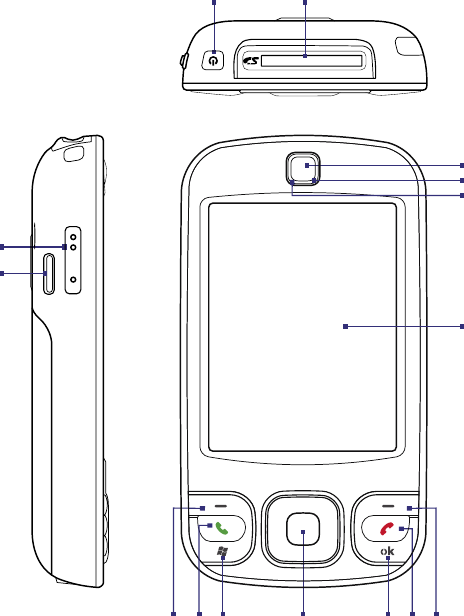
16 Getting Started
1.1 Getting to Know Your Device and Its Accessories
1
10
2
3
4
5
6
7 8 9 11 12 13
14
15
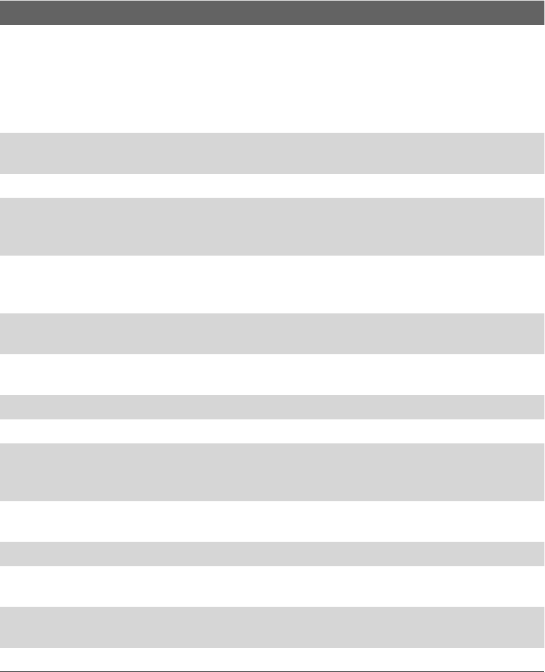
Getting Started 17
No. Item Function
1 POWER Button Press and hold to turn on the device. When the device is
turned on, press to turn off the display temporarily. This
switches your device to Sleep mode, and you can still receive
calls and messages. Press and hold (for about 5 seconds) to
turn off the power completely. All functions including the
phone will be unavailable for use.
2 SD™ Card Slot Insert your SD™ card for storing data, or insert the SD™ input/
output card, such as a network card.
3 Earpiece Listen to a phone call from here.
4 Notification LED 1 This LED shows a blinking Blue light for Bluetooth system
notification of powered-up and ready to transmit Bluetooth
signal.
5 Notification LED 2 This bi-color LED shows Green and Amber lights for GSM/
GPRS/EDGE standby, message, and network status as well as
for notification and battery charging status.
6 Touch Screen Tap the screen with the stylus to write, draw, or make a
selection.
7 Left SOFT KEY Press to execute the command shown in the label above the
button.
8 TALK Button Press to answer an incoming call or dial a number.
9 START Button Press to open the Start menu.
10 NAVIGATION Control
/ENTER Button
Press this multi-directional control up, down, left, or right to
move through menus and program instructions; carry out the
selection by pressing the center button.
11 OK Button Press to confirm your data entries, or to exit the program in
use.
12 END Button Press to end a call or to return to the Today screen.
13 Right SOFT KEY Press to execute the command shown in the label above the
button.
14 Volume Up/Down
Button
Press the upper/lower button to increase/decrease the
speaker volume or the earpiece volume during a call.
15 Speaker Listen to the audio media from here.
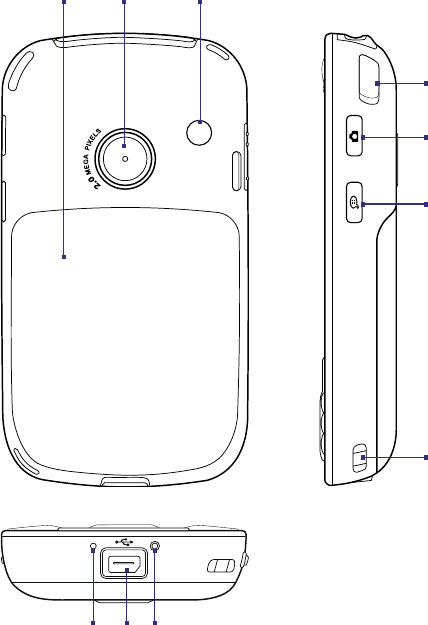
18 Getting Started
24
23
25
21
20
19
18
17
22
16
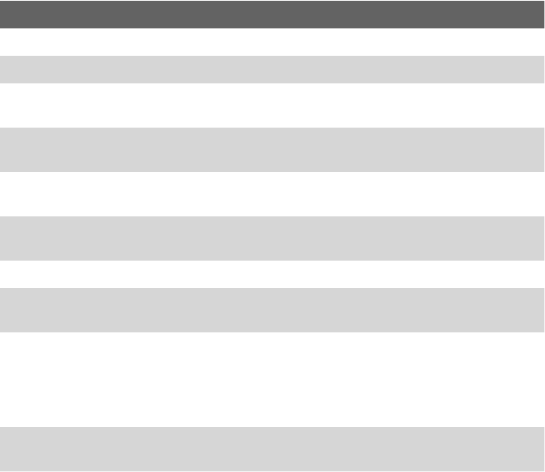
Getting Started 19
No. Item Function
16 Back Cover Slide out to access the battery compartment and SIM card.
17 Camera Use the camera to take still photos and record video clips.
18 Car Antenna
Connector
Connect your device to the car antenna while in a car to have
better reception quality.
19 Stylus Use the stylus to write, draw, or select items on the touch
screen.
20 CAMERA Button Press to launch the Camera; press again to take a photo or
video clip, depending on the specified capture mode.
21 VOICE COMMAND
Button
Press to start Voice Speed Dial; press and hold to record a
voice note.
22 Strap Holder It lets you attach a strap for carrying your device.
23 Microphone Speak into the microphone when receiving or making a
phone call or voice recording.
24 Sync Connector/
Earphone Jack
Use this connector to synchronize data by connecting the
provided USB Sync cable or to recharge the battery via the
provided AC adapter. You can also connect the provided USB
stereo headset for hands-free conversation or for listening to
audio media.
25 RESET Button With the stylus, press the RESET button to soft-reset your
device.
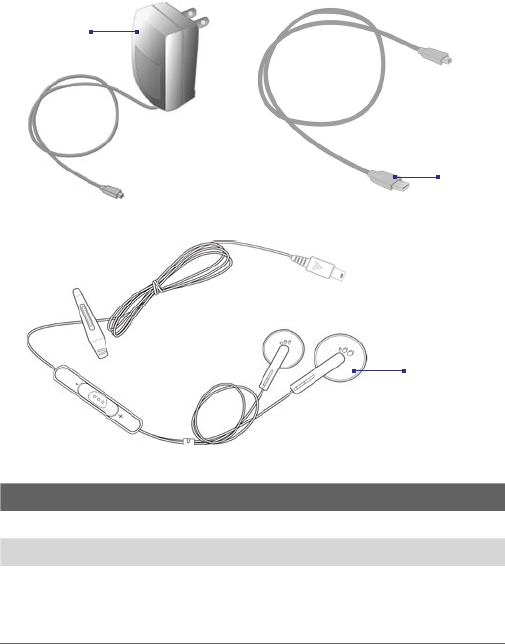
20 Getting Started
Accessories
2
1
3
No. Accessory Function
1 AC adapter Charges the battery.
2 USB Sync cable Connects your device to a PC and synchronize data.
3 Stereo headset Provides a volume control slider and a Send/End
button. Press the Send/End button to pick up a call or
put a call on hold; press and hold the button to end
the call.
Getting Started 21
1.2 About the SIM Card and Battery
Always turn off your device before installing/replacing the battery and
SIM card. Follow the instructions in the Quick Start Guide to install a SIM
(Subscriber Identity Module) card provided by your local network service
provider and to install the battery.
The SIM card contains your phone number, service details, and phonebook/
message memory. Your device supports a 3V SIM card. Some legacy SIM
cards will not function with your device. You should consult with your
service provider for a replacement SIM card. There may be fees for this
service.
Your device contains a rechargeable Li-ion battery. This device is designed
to use only manufacturer-specified original batteries and accessories.
Battery performance depends on many factors, including your wireless
service provider’s network configuration, signal strength, the temperature
of the environment in which you operate your device, the features and/or
settings you select and use, items attached to connecting ports, and your
voice, data, and other program usage patterns.
Battery life estimates (approximations):
• Standby time: Up to 150 - 200 hours.
• Talk time: Up to 3.5 - 5 hours.
• Media playback time: Up to 8 hours for WMV; up to 12 hours for WMA.
Warning! To reduce risk of fire or burns:
• Do not attempt to open, disassemble, or service the battery pack.
• Do not crush, puncture, short external contacts, or dispose of in fire
or water.
• Do not expose to temperatures above 60oC (140oF).
• Replace only with the battery pack designated for this product.
• Recycle or dispose of used battery as stipulated by local regulation.
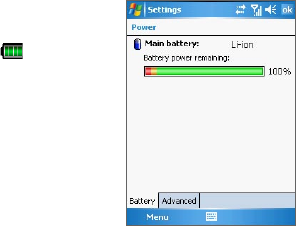
22 Getting Started
To check the battery power
Do one of the following:
• Tap the battery level icon ( ) on the
Today screen.
• Alternatively, tap Start > Settings >
Systems tab > Power.
Battery power information
Charge the battery
New batteries are shipped partially charged. Before you start using your
device, it is recommended that you install and charge the battery. Some
batteries perform best after several full charge/discharge cycles. You can
charge the battery in two ways:
•
Charging the device’s battery by using the power adapter.
• Connecting your device to a PC via the provided USB Sync cable.
Warning! • Do not remove the battery from the device while you are charging it
using the AC or car adapter.
• As a safety precaution, the battery stops charging when it overheats.
Low battery
When the low-battery warning appears, do the following:
• Immediately save your current data.
• Synchronize with your PC or connect the power adapter to charge the
battery.
• Turn off your device.
Getting Started 23
1.3 Starting Up
Turn your device on and off
To turn on your device, press and hold the POWER button. When you turn
on your device for the first time, a Quick Start Wizard will guide you through
the calibration process and the setup of regional settings, date and time,
password, Outlook e-mail, and POP3/IMAP4 e-mail accounts. For more
information about touch screen calibration, see “Calibrate the device”.
For information about setting up Outlook e-mail and POP3/IMAP4 e-mail
accounts, see Chapter 7.
To turn off your device, press and hold the POWER button for a few seconds.
A message will then be displayed, prompting you whether or not to turn off
the device completely.
Switch your device to Sleep mode
Quickly pressing the POWER button turns off the display temporarily and
switches your device to Sleep mode. Sleep mode suspends your device to a
low power state while the display is off in order to save battery power.
Your device also automatically goes into Sleep mode when you leave the
device idle after a certain amount of time.
To specify the timeout period before your device goes into Sleep mode
1. Tap Start > Settings > System tab > Power > Advanced tab.
2. Under On battery power, make sure the Turn off device if not used
for check box is selected.
3. Select the battery timeout period, then tap OK.
You will still be able to receive messages and calls while your device is in
Sleep mode. Pressing the POWER button again or new incoming calls/
messages will wake up your device.
24 Getting Started
Calibrate the device
Calibrating the device screen involves tapping the center of a cross with the
stylus as the cross moves around the screen. This process ensures that when
you tap the screen with your stylus, the tapped item is activated.
If your device does not accurately respond to screen taps, follow these steps
to re-calibrate it:
1. Tap Start > Settings > System tab > Screen.
2. On the General tab, tap Align Screen, then follow the on-screen
instructions to complete the calibration.
Manage screen settings
The device’s display has two orientation modes: Portrait and Landscape.
Portrait mode allows you to get a better view or a better operation of
certain programs, while Landscape mode may be optimal for viewing
lengthy files.
• To change the orientation, tap Start > Settings > System tab >
Screen, and select the orientation you want.
• To smooth the edges of screen fonts for many programs, on the
ClearType tab, select the Enable ClearType check box.
• To increase the readability or to see more content on the screen, on
the Text Size tab, adjust the text size by moving the slider.
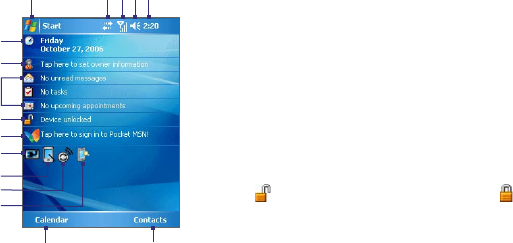
Getting Started 25
1.4 The Today Screen
The Today screen displays important information, such as upcoming
appointments and status indicators. You can tap a section on the screen to
open the associated program.
• To access the Today screen, tap Start > Today.
• To customize the Today screen display, including the background
image, tap Start > Settings > Personal tab > Today.
1
6
15
7
8
9
2 3 4 5
16
11
10
12
13
14
1Tap to open the Start menu.
2Tap to view connectivity status.
3Indicates the radio signal strength. Tap to
configure the phone settings.
4Tap to adjust device/ringer volume.
5Displays the current time. Tap to check the
current date and upcoming appointments. Tap
and hold to change the clock mode to Analog
or Digital.
6Displays the current date. Tap to set up date,
time, alarm, and more.
7Tap to set owner information.
8Your day at a glance with reminders. Tap to
open the related program: messages, tasks, and
appointments.
9Tap to lock the device. The icon changes to .
Tap Unlock on the Today screen to unlock again.
10 Tap to sign in at Pocket MSN.
11 Indicates the battery status. Tap to open the
Power Settings screen.
12 Tap to toggle the screen between portrait and
landscape orientation.
13 Tap to open Comm Manager.
14 Tap to open the Backlight Settings screen.
15 Tap to open Calendar.
16 Tap to open Contacts.
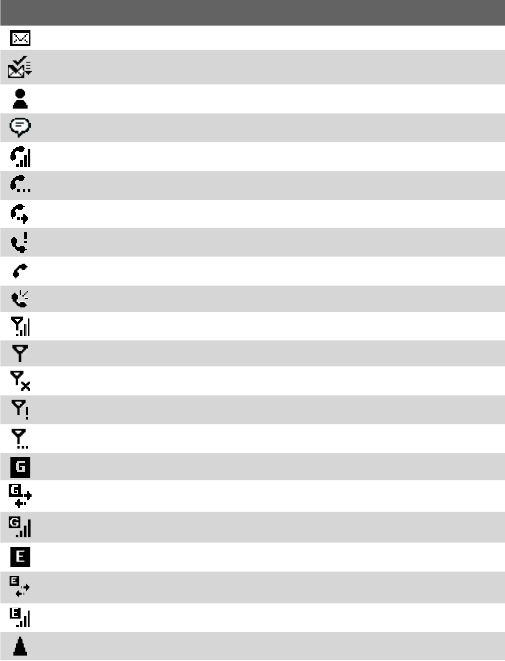
26 Getting Started
Indicators
The following are some of the status icons that you may see on the device.
Icon Description
New e-mail or text messages; SMS notification of voice mail.
New multimedia (MMS) message.
New MSN message.
There are more notifications. Tap the icon to view all.
Voice call in progress.
Call on hold.
Calls are forwarded.
Missed call.
Dialing while no SIM card is inserted.
Speakerphone on.
Maximum signal strength.
No signal.
Phone is turned off.
No phone service.
Searching for phone service.
GPRS available.
GPRS connecting.
GPRS in use.
EDGE available.
EDGE connecting.
EDGE in use.
Roaming.
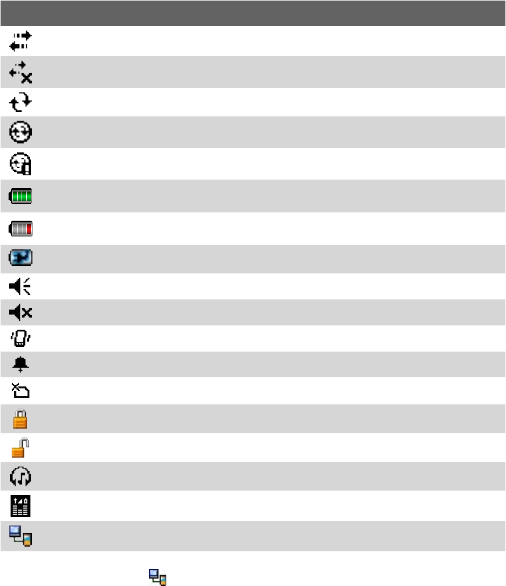
Getting Started 27
Icon Description
Connection is active.
Connection is not active.
Synchronization in progress.
ActiveSync notification.
Synchronization error.
Battery is fully charged.
Battery power is very low.
Battery charging.
Sound on.
Sound off.
Vibration mode.
Alarm.
No SIM card inserted.
Device is locked.
Device is unlocked.
Bluetooth headset detected.
GPRS Monitor currently active.
Serial USB connection active.
Note The USB to PC ( ) icon appears on the Today Screen when your device
is connected to your computer and you enable a serial USB connection
between them. For more information about USB to PC, see “Device Settings”
later in this chapter.
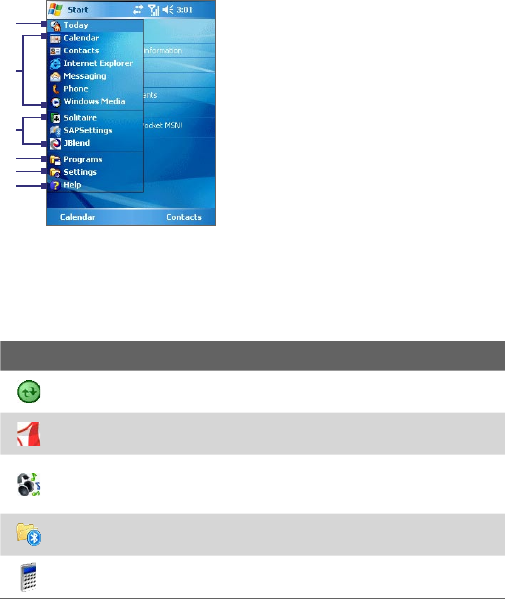
28 Getting Started
The Start menu
The Start menu, located at the top left corner of the Today screen, displays a
list of programs. You can start a program by scrolling through the programs
list and then pressing ENTER, or by tapping a program with the stylus.
1Tap to switch to the Today screen.
2Tap to start a program. The items
displayed in the Start menu can
be customized by tapping Start >
Settings > Personal tab > Menus.
3Tap to start a recently-used program.
4Tap to view and select more programs
that are installed on your device.
5Tap to change device settings.
6Tap to see a Help topic for the current
screen.
1
2
5
4
6
3
1.5 Using the Programs
The following are some of the programs that are already installed on your
device.
Icon Description
ActiveSync Synchronizes information between your device and a PC or
the Exchange Server.
Adobe Reader LE Enables you to view PDF (Portable Document Format)
files on your device.
Audio Manager Allows you to easily browse for music files by
organizing music files into categories, such as artists, album, etc. It has an
integrated Music Player that lets you play back music files.
Bluetooth Explorer Searches for other Bluetooth devices that have file
sharing enabled and allows you to access their Bluetooth shared folder.
Calculator Lets you perform basic arithmetic and calculations, such as
addition, subtraction, multiplication, and division.
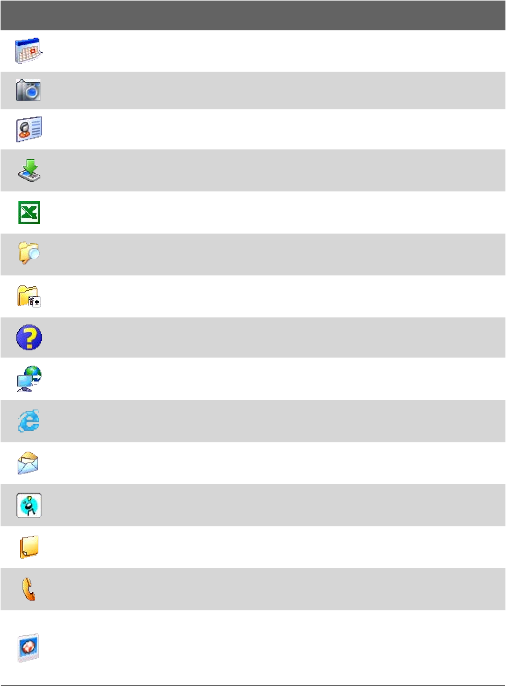
Getting Started 29
Icon Description
Calendar Allows you to keep track of your appointments and create
meeting requests.
Camera Snaps photos or shoots video clips accompanying audio.
Contacts Allows you to keep track of your friends and colleagues.
Download Agent Provides information about the download status and
the downloaded content from the Internet.
Excel Mobile Creates new workbooks or lets you view and edit Excel
workbooks.
File Explorer Enables you to organize and manage files on your device.
Games Lets you play two pre-installed games: Bubble Breaker and
Solitaire.
Help Enables you to see Help topics for a program on your device.
Internet Sharing Allows you to connect your notebook computer to the
Internet using your device's data connection.
Internet Explorer Allows you to browse Web and WAP sites as well as
download new programs and files from the Internet.
Messaging Allows you to send and receive e-mail, MMS, and text
messages.
MIDlet Manager Enables you to download and install Java applications,
such as games and tools, on your device.
Notes Allows you to create handwritten or typed notes, drawings, and
recordings.
Phone Lets you make and receive calls, switch between calls, and set up
conference calling.
Pictures & Videos Lets you view, organize, and sort picture and video
files on your device or a storage card. Captured photos are stored in the
My Pictures folder, and video clips are saved in the My Videos folder of
your device.
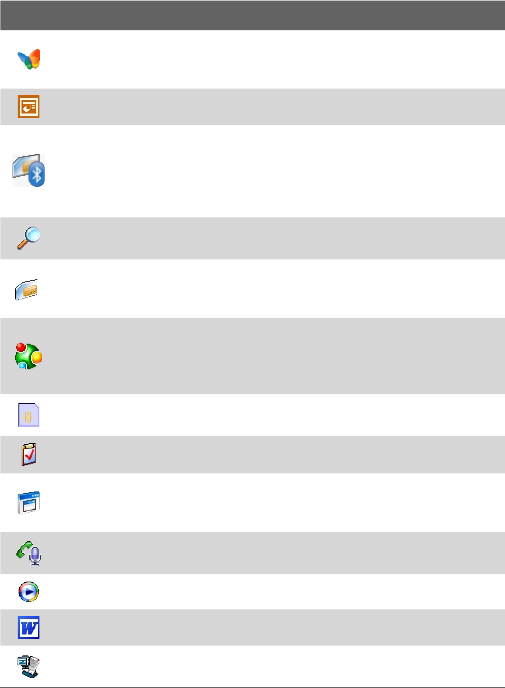
30 Getting Started
Icon Description
Pocket MSN Lets you send and receive instant messages with your MSN
Messenger contacts, as well as access your hotmail account, if you have
one.
PowerPoint Mobile Lets you view PowerPoint slides and presentations.
SAPSettings Enables Bluetooth Remote SIM access on your device. This
allows you to use a car kit phone that supports the SIM Access Profile
(SAP) to access the SIM card on your device via Bluetooth and make
or receive phone calls. You can also download SIM contacts from your
device onto the car kit phone.
Search Enables you to search contacts, data, and other information on
your device.
SIM Manager Allows you to manage the contacts that are stored on
your SIM card. You can also use this program to copy SIM contents to
Contacts on your device.
Spb GPRS Monitor Can be installed to your device from the Application
CD. It measures the amount of data transfers that you have made via the
UMTS, GPRS, or GSM network connection, and calculates network usage
costs.
STK (SIM Tool Kit) Service Allows you to access information and other
services offered by your wireless service provider.
Tasks Allows you to keep track of your tasks.
Terminal Services Client Allows you to log on a PC running Terminal
Services or Remote Desktop, and use all of the programs available on
that PC from your mobile device.
Voice Speed Dial Allows you to record voice tags so that you can dial a
phone number or launch programs simply by speaking a word.
Windows Media Player Lets you play back media files.
Word Mobile Lets you create, view, and edit Word documents.
ZIP Enables you to save memory and free up storage space on your
device by compressing files in the conventional ZIP format.
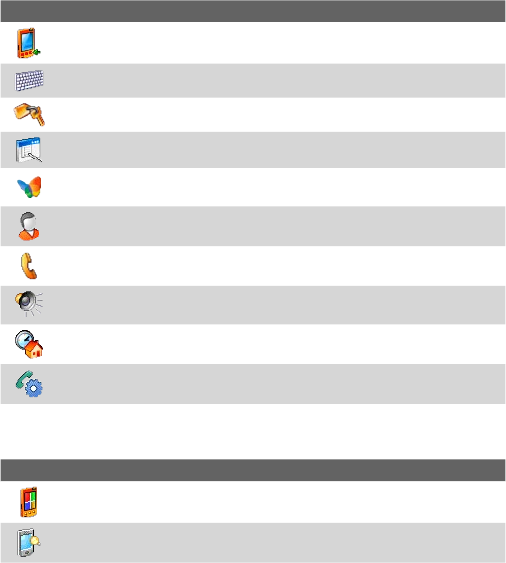
Getting Started 31
1.6 Device Settings
You can adjust the device settings to suit the way you work. To see all
available settings, tap Start > Settings, then tap the Personal, System, and
Connections tabs located at the bottom of the screen.
Personal tab
Icon Description
Buttons Assigns a program to a hardware button.
Input Sets options for each of the input methods.
Lock Sets a password for your device.
Menus Sets what programs will appear in the Start menu.
MSN Options Allows you to customize settings for the applications
included in Pocket MSN, such as MSN Hotmail and MSN Messenger.
Owner Information Allows you to enter your personal information on
your device.
Phone Allows you to customize phone settings, such as ring tone, set a
PIN number for your SIM card, and more.
Sounds & Notifications Enables sounds for events, notifications, and
more, and allows you to set the type of notification for different events.
Today Allows you to customize the appearance and the information to
be displayed on the Today screen.
Voice Speed Dial Allows you to create voice tags for voice dialing
contacts and SIM contacts as well as for launching programs.
System tab
Icon Description
About Allows you to specify a name for your device. Also shows the
Windows Mobile version and copyright information.
Backlight Sets the backlight timeout and brightness.
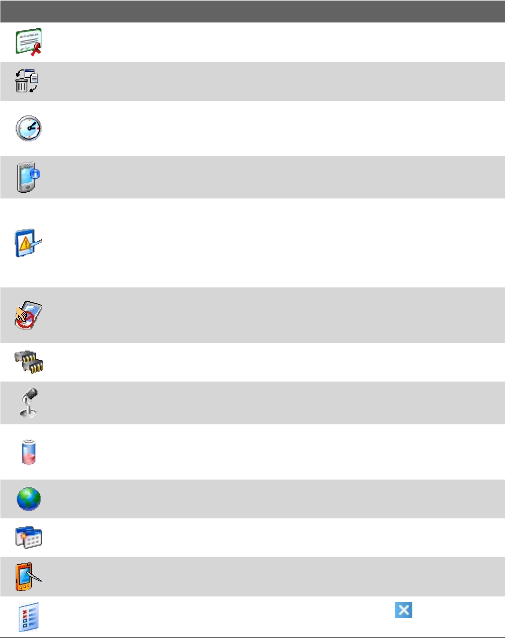
32 Getting Started
Icon Description
Certificates Shows information about certificates that are installed on
your device.
Clear Storage Removes all your data and files from the memory and
resets your device to factory default settings.
Clock & Alarms Switches the device clock to the date and time of your
locale or to a visiting time zone when you're traveling. Alarms can also be
set at specified days and times of a week.
Device Information Shows information about the firmware version,
hardware, identity, and the duration of calls made on your device.
Error Reporting Enables or disables the device's error reporting
function. When this function is enabled and a program error occurs,
technical data about the state of the program and your computer will be
logged in a text file and delivered to Microsoft's technical support if you
choose to send it.
Key Lock Locks the buttons on your device except for the POWER
button when the device is in Sleep mode. This ensures you will not
switch the device on by accident and consume unnecessary power.
Memory Shows the device memory allocation status and storage card
information. Also allows you to stop currently running programs.
Microphone AGC Adjusts the volume of your voice automatically when
you are recording.
Power Shows the current battery level. Also allows you to set the
timeout for turning off the display (switching device to Sleep mode) to
conserve battery power.
Regional Settings Sets the regional configuration to use, including the
format for displaying numbers, currency, date, and time on your device.
Remove Programs Lets you remove programs that you installed on
your device.
Screen Allows you to change the screen orientation, re-calibrate the
screen, and change the screen text size.
Task Manager Allows you to configure the Exit button ( ) to end
programs and free up the memory that’s occupied by them.
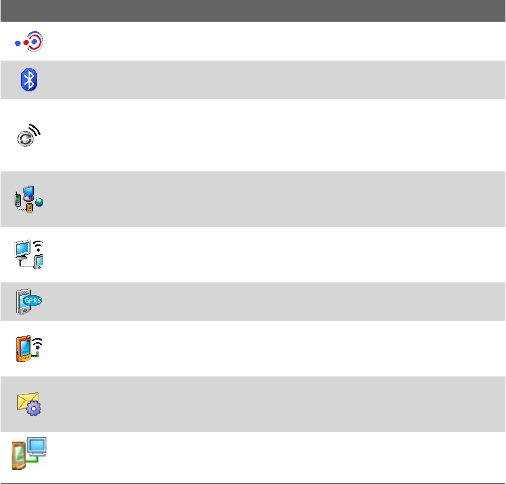
Getting Started 33
Connections tab
Icon Description
Beam Enables your device to receive incoming infrared and Bluetooth
beams.
Bluetooth Turns Bluetooth on, sets your device to visible mode, and
allows you to scan for other Bluetooth devices.
Comm Manager
Allows you to manage the device’s connection
(including Bluetooth, Beam, and ActiveSync), disconnect data services
(such as GPRS), turn the phone on or off, switch to ringer/vibration mode,
switch to flight mode, and enable or disable the Direct Push function
.
Connections Sets up one or more types of modem connections for your
device, such as phone dial-up, GPRS, Bluetooth, and more, so that your
device can connect to the Internet or a private local network.
CSD Line Type Sets the line type to use when making a circuit switch
data (CSD) connection. Normally, you do not need to change the setting
unless you encounter a problem on establishing a connection.
GPRS Setting Sets the GPRS authentication method. Consult your
wireless service provider first before changing this setting.
Network Card Allows your device to scan for available wireless
networks. Also allows you to set up a network card (if you have one
inserted on your device).
SMS Service Enables sending of SMS text messages via a data
connection, such as GPRS or a circuit-switched connection. This can be
used only if your wireless service provider supports this service.
USB to PC Sets the USB connection between your device and PC, and
helps with problems connecting ActiveSync.
34 Getting Started
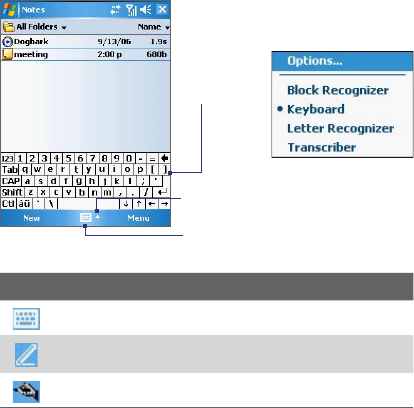
36 Entering and Searching Information
2.1 Entering Information
When you start a program or select a field that requires text or numbers, the
Input Panel icon becomes available on the menu bar.
Tap the Input Selector arrow (that appears next to the Input Panel icon)
to open a menu where you can select a text input method and customize
input options. After selecting a text input method, the corresponding Input
Panel is then displayed and you can use it to enter text. To toggle between
showing and hiding the Input Panel, simply tap the Input Panel icon.
Input Panel
(Keyboard)
Input Selector
arrow
Input Panel icon
Icon Input method
On-screen keyboard
Letter Recognizer or Block Recognizer
Transcriber
Note Some text input methods may not be available in certain language versions
of the device.
Entering and Searching Information 37
2.2 Using the On-screen Keyboard
The on-screen Keyboard is available when text entry is possible. You can
enter text by tapping keys on the keyboard that are displayed on the screen.
To enter text using the on-screen Keyboard
1. In a program, tap the Input Selector arrow, and tap Keyboard.
2. Enter text by tapping keys on the on-screen Keyboard.
To enlarge the on-screen Keyboard
1. Tap the Input Selector arrow, then tap Options.
2. In the Input method list, select Keyboard.
3. Tap Large keys.
2.3 Using Letter Recognizer
With Letter Recognizer, you can write individual letters, numbers, and
punctuation, which are then converted into typed text.
To use Letter Recognizer
1. From a program, tap the Input Selector arrow, and tap Letter
Recognizer.
2. Write characters, numbers, and symbols in the designated writing
area.
• Enter capital letters by writing in the ABC (left) area of the box.
• Enter lower case letters by writing in the abc (middle) area of the
box.
• Enter numbers by writing in the 123 (right) area of the box.
• Enter punctuation and symbols by tapping in either area of the
box and then writing the desired character.
Note Letter Recognizer is available when text entry is possible.
Tip For help with writing characters, tap the question mark near the writing area.
38 Entering and Searching Information
2.4 Using Block Recognizer
With Block Recognizer, you use a single stroke to write letters, numbers,
symbols, and punctuation, which are then converted into typed text.
To use Block Recognizer
1. From a program, tap the Input Selector arrow, and tap Block
Recognizer.
2. Write characters, numbers, and symbols in the designated writing
area.
• Enter letters by writing in the abc (left) area of the box.
• Enter numbers by writing in the 123 (right) area of the box.
• Enter symbols and punctuation by tapping in either area of the
box and then writing the desired character.
Note Block Recognizer is available when text entry is possible.
Tip For help with writing characters with Block Recognizer, tap the question
mark near the writing area.
2.5 Using Transcriber
Transcriber is a handwriting recognition program that allows you to write
in cursive, print, or a combination of both. Transcriber works transparently
in the background of programs, recognizing words with its integrated
dictionary. When Transcriber is turned on, it interprets stylus movement
anywhere on the screen as handwriting input. For more information about
using Transcriber, see Help on your device.
To start Transcriber
1. Start a program that accepts user input, such as Word Mobile.
2. Tap the Input Selector arrow, and tap Transcriber. The Transcriber
introductory screen appears.

Entering and Searching Information 39
To write using Transcriber
1. In a program, position the cursor where you want text to appear.
2. Use the stylus to write anywhere on the screen. The handwriting will
be converted to text shortly after you lift the stylus from the screen.
To enter punctuation and symbols
Transcriber comes with an on-screen keyboard that provides an easy way to
add punctuation or a special symbol to existing text.
• From a program, tap on the Transcriber toolbar.
The keyboard remains visible until you tap the button again.
Tips • To reposition the keyboard, tap and hold the title bar, then drag to the
desired location.
• When no text is selected, you can also open the keyboard by doing the
gesture. For more information about using Transcriber gestures, see Help
on your device.
To edit text
1. In a program, draw a line across the text you want to edit.
2. After you lift the stylus from the screen, the line will disappear and the
selected text will be highlighted.
3. Do either of the following:
• Rewrite the text.
• Use gestures to capitalize letters, insert a space, and so on. For
information about using Transcriber gestures, see Help on your
device.

40 Entering and Searching Information
2.6 Using Notes to Draw, Write, and Record Voice Notes
Using Notes, you can draw directly on the screen, or write on the screen
and save notes in your own handwriting. You can also create a stand-alone
recording (voice note) or you can add a recording to a note.
For more information on what you can do with Notes, please see “Notes” in
Chapter 7.
2.7 Searching Information
You can search for files and other items stored in My Documents folder or
on an installed storage card of your device. You can search by file name
or by words located in the item. For example, you can search in e-mail
messages, notes, appointments, contacts, and tasks, as well as in online
Help.
To search for a file or an item
1. Tap Start > Programs > Search.
2. In the Search for field, you can:
• Enter the file name, word, or other information you want to search
for.
• Tap the down arrow icon ( ), and from the list, select one item
that you have looked for before.
3. In the Type field, you can tap the down arrow icon ( ) and select a
data type from the list to help narrow your search.
4. Tap Search. The system then starts searching the matched files in the
My Documents folder and subfolders.
5. In the Results list, tap the item you want to open.
Note The storage card symbol is displayed next to the names of files saved on
a storage card.
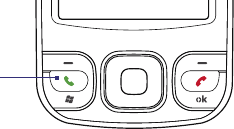
42 Using Phone Features
3.1 Using the Phone
Like a standard mobile phone, you can use your device to make, receive,
and keep track of calls and send SMS/MMS messages. You can also dial
directly from Contacts, and easily copy phonebook entries from your SIM
card to Contacts on your device.
The Phone screen
From the Phone screen, you can access Call History, Speed Dial, and Phone
settings. To open the Phone screen, do one of the following:
• Tap Start > Phone.
• Press the TALK button.
TALK button
Enter your PIN
Most SIM cards are preset with a PIN (Personal Identification Number) that is
provided by your wireless service provider.
1. Enter the preset PIN assigned by your wireless service provider.
2. Tap Enter.
Note If your PIN is entered incorrectly three times, the SIM card will be blocked. If
this happens, you can unblock it with the PUK (PIN Unblocking Key) obtained
from your wireless service provider.
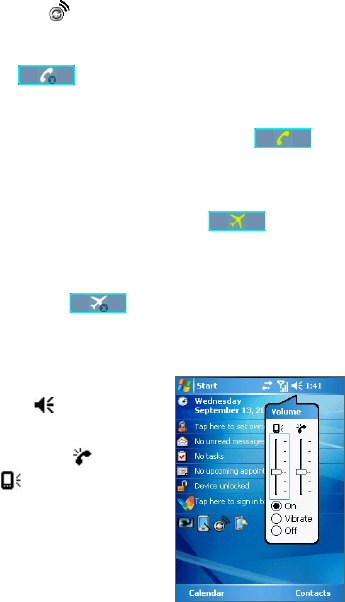
Using Phone Features 43
Turn the phone function on and off
In many countries, you are required by law to turn off your phone while on
board an aircraft.
To turn off the phone function
Tap the Comm Manager icon ( ) on the Today screen, then do one of the
following:
• On the Comm Manager screen, tap the Phone button to turn off the
phone function. The icon indicates the phone function is
turned off.
To resume call function, turn on the phone function by tapping the
Phone button again on the Comm Manager screen. The icon
indicates the phone function is turned on.
• On the Comm Manager screen, tap the Flight Mode button to
turn on flight mode. This disables all wireless radios on your device,
including the phone function and Bluetooth. The icon
indicates that flight mode is turned on.
To resume call function, tap the Flight Mode button again on the
Comm Manager screen. This restores the previous states of the phone
function and Bluetooth. The icon indicates the flight mode is
turned off.
Adjust the device volume
1. Tap the Speaker icon ( ).
2. Under Volume, do the following:
• Adjust the phone volume ( ) or
device volume ( ) by moving the
slider to the desired volume level.
• Tap On, Vibrate, or Off to change both
the system and ringer volume settings.
Volume adjustment
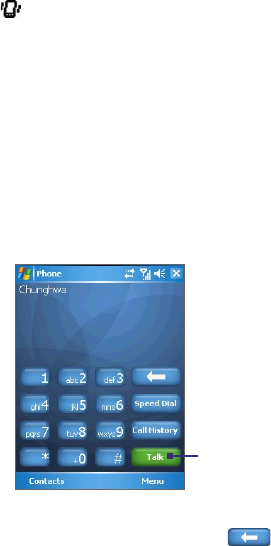
44 Using Phone Features
Notes •
To adjust the conversation phone volume, you must do it during a call.
Adjusting the volume at another time will affect the ring, notification, and
MP3 sound levels.
•
When you activate Vibrate mode, sound will automatically be muted and
your device will vibrate when an incoming call is received. The Vibrate
icon ( ) will appear in the title bar to indicate that Vibrate mode is
activated.
3.2 Making a Call
With your device, you can make a call from Phone, Contacts, Speed Dial,
Call History, and SIM Manager.
Make a call from Phone
1. Tap Start > Phone or press the TALK button.
2. On the Phone screen, tap the desired phone number, then tap Talk.
Talk button
Tip If you tap a wrong number, tap the Back arrow ( ) to erase each
subsequent digit of a number. To erase the entire number, tap and hold the
Back arrow.

Using Phone Features 45
Make a call from Contacts
Tap Contacts on the Today screen or tap Start > Contacts, then do one of
the following:
• Press NAVIGATION up or down to select a contact, and press TALK
twice (once to send the number to the Phone keypad, and once to
dial the number).
• Tap the desired contact in the contacts list, and tap the phone
number that you want to call.
• Tap and hold the desired contact, and on the shortcut menu, tap Call
Work, Call Home, or Call Mobile.
To choose one of the numbers of a contact to dial
By default, the mobile phone number (m) of a contact is dialed when you
make a call from Contacts. However, you can specify that a different phone
number is dialed instead.
1. Tap Contacts on the Today screen or tap Start > Contacts.
2. Press NAVIGATION up or down to select the contact.
3. Press NAVIGATION left or right. The letters representing the number
will change as you scroll through them.
Make a call from Call History
1. On the Phone screen, tap Call History.
2. You can either scroll through all calls in Call History, or tap Menu >
Filter and select from a category of call types.
3. Scroll to the desired contact or phone number, and tap Call.
Make a call from Speed Dial
Use Speed Dial to call frequently-used numbers with a single tap. For
example, if you assign a contact to the location 2 in Speed Dial, you can
simply tap and hold on the Phone screen to dial the contact’s number.
Before you can create a Speed Dial entry, the number must already exist in
Contacts.
46 Using Phone Features
To create a Speed Dial entry
1. On the Phone screen, tap Speed Dial.
2. Tap Menu > New.
3. Tap a contact. Select the phone number that you want to add to
Speed Dial.
4. In the Location box, select an available location for the new Speed
Dial entry.
Note Location 1 is generally reserved for your voice mail, and Speed Dial will
designate the next available location by default. If you want to place a phone
number in a position that is already occupied, the new number will replace
the number that is already there.
Tips •
To create a Speed Dial entry from Contacts, tap and hold the contact
name, tap Add to Speed Dial, then select the phone number for which to
create a Speed Dial and an available location for the new Speed Dial entry.
•
To delete a Speed Dial entry, in the Speed Dial list, tap and hold the
desired entry, and tap Delete.
Make a call from SIM Manager
SIM Manager allows you to view the contents of your SIM card, transfer SIM
phonebook entries to Contacts on your device, and make a call from your
SIM card.
To call a SIM contact
1. Tap Start > Programs > SIM Manager. Wait for your SIM card
contents to load.
2. Tap and hold the name or phone number of the person you want to
call, and tap Call.
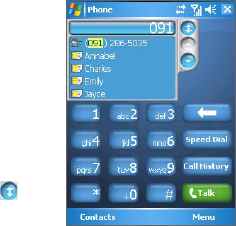
Using Phone Features 47
3.3 Receiving a Call
When you receive a phone call, a message will appear, giving you the
option to either answer or ignore the incoming call.
To answer or reject an incoming call
• To answer the call, tap Answer, or press TALK on the device.
• To reject the call, tap Ignore, or press END on the device.
To end a call
Once an incoming or outgoing call is in progress, you can tap End or press
END on the device to hang up.
3.4 Smart Dialing
Smart Dialing is a program that makes it easy for you to dial a phone
number. When you start entering numbers or characters, Smart Dialing
will automatically search and sort the contact entries on the SIM card, in
Contacts, and the phone numbers in Call History (including incoming,
outgoing, and missed calls). You can then select the desired number or
contact from the filtered list to dial.
Start Smart Dialing
Open the Phone screen, then tap the keys
on the Phone keypad that correspond to
the phone number or contact you want
to call.
When you start entering a number or
letter, the Smart Dialing panel will appear
automatically on the Phone screen. You
can change the panel size according to
your needs by tapping the arrow icon .
Smart Dialing panel

48 Using Phone Features
Tips on using Smart Dialing
Smart Dialing starts looking for numbers or contacts that match the
sequence you have entered. Below are some tips on how to use Smart
Dialing to quickly find a desired phone number or contact.
To find a phone number
• Simply enter the first one or two digits to find a phone number in Call
History.
• Enter the first three digits or more if you want to find a phone number
from the saved contacts on your device and SIM card.
To find a contact name
You can just enter the first letter of a contact’s first name or surname. Smart
Dialing will search for the letter starting from the first character of a contact
name as well as from the character that appears after a space, dash, or
underscore in a contact name. For example, if you tap number “2” which is
associated with [a, b, c] on the Phone keypad, contact names, such as the
following will be considered matches: “Ben Miller”, “George Adams”, “John-
Carter”, “Carter, Ellen”, “Dixon, Allan”, “Thomas_Clark”, “JaneCampbell”.
If the matching list is long and you want to narrow down the search further,
enter another letter. Using the same example above, if you continue to
tap “3” which is associated with [d, e, f ], the matching list will be narrowed
down to the following names: “Ben Miller”, “George Adams”, “Carter, Ellen”,
“Dixon, Allan”.
Make a call or send a text message using Smart Dialing
1. Begin entering the first few numbers or characters.
2. In the Smart Dialing panel, browse the list by tapping the arrows
( / ) or pressing NAVIGATION up or down to select the desired
contact or phone number. When a contact is selected, it expands to
also show the corresponding phone number.
3. The highlighted item will move one line when you press NAVIGATION
up or down; the highlighted item will scroll one page when you tap
the arrows.
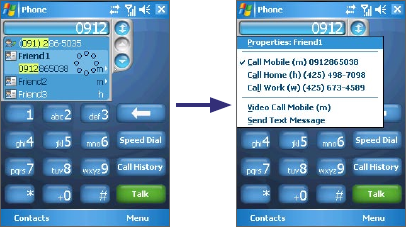
Using Phone Features 49
4. Do one of the following:
• When the correct contact is selected, tap Talk or press the TALK
button to make a voice call.
• To send a text message to the selected contact, tap and hold the
contact, and tap Send Text Message.
• To call a different phone number associated with the selected
contact, tap and hold the selected contact, and tap the phone
number you want to call.
Tap and hold the contact to pop up the shortcut menu.
Tip
To view or edit information associated with the selected contact, tap the
contact’s name on the shortcut menu (applies only to entries stored in
Contacts on your device).
Set up Smart Dialing
1. On the Phone screen, tap Menu > Smart Dialing Options.
2. On the Options tab, select the Enable Smart Dialing check box.
• Select the Automatically expand selected contact check box to
enable a contact’s name and phone number to be displayed when
the contact is selected in the matching list.
• Select the Enable drag-scroll check box to scroll in the matched
list by dragging.

50 Using Phone Features
• Select the Enable double-click for dialing check box to make a
voice call by double-tapping the item in the matched list.
• In Scroll unit, you can set the amount of scrolling when tapping
the arrows ( / ).
3.5 In-call Options
To put a call on hold
Your device notifies you when you have another incoming call, and gives
you the choice of rejecting or accepting the call. If you are already on a call
and accept the new call, you can choose to switch between the two callers,
or set up a conference call between all three parties.
1. Tap Answer to take the second call, and put the first one on hold.
2. To end the second call and return to the first call, tap End or press
END on the device.
To switch between two calls
• Tap Swap.
To set up a conference call
1. Either put a call on hold, and dial a second number; or, accept a
second incoming call when you already have one in progress.
2. Tap Conference.
Note Not all service providers support conference calling. Contact your service
provider for details.
To turn on and off the Speakerphone
The built-in Speakerphone on your device allows you to talk hands-free or
lets other people listen to the conversation.
• During a call, tap Speaker On, or press and hold TALK until the
speakerphone turns on. The speakerphone icon ( ) appears in the
title bar.
• To turn off the speakerphone, tap Speaker Off, or press and hold
TALK again until the speakerphone turns off.

Using Phone Features 51
Warning! To avoid damage to your hearing, do not hold your device against your ear
when the Speakerphone is turned on.
To mute a call
You can turn off the microphone during a call, so that you can hear the
caller but the caller cannot hear you.
• During a call, tap Mute.
• When the microphone is turned off, the mute icon ( ) appears on
the screen. Tap Unmute to turn on the microphone again.
3.6 Additional Dialing Information
Make an emergency call
• Enter the international emergency number for your locale, and tap
Talk.
Tip Additional emergency numbers may be included in your SIM card. Contact
your service provider for details.
Make an international call
1. Tap and hold on the Phone keypad until the + sign appears. The
+ replaces the international prefix of the country that you are calling.
2. Enter the full phone number you want to dial, and tap Talk. The full
phone number includes country code, area code (without the leading
zero, if any) and phone number.
52 Using Phone Features
3.7 Setting Up Bluetooth SIM Access for Car Kit Phones
Car kit phones that support the SIM Access Profile (SAP) can connect to your
device and access its SIM card via Bluetooth. Once a SAP connection has
been established, you can download SIM contacts from your device to the
car kit phone. You can also use the car kit phone to answer and make calls
using your device’s SIM card.
Notes •
To enable downloading contacts onto the car kit, ensure that all contacts
on the device are stored in the SIM card and not in the device memory.
Configure the car kit to download contacts only from the SIM card.
•
Contact your wireless service provider to find out which car kit phone
models are compatible with your device.
1. On your device, make sure that Bluetooth is turned on and set to
visible mode. For information about turning on Bluetooth and
enabling visible mode, see “Bluetooth modes” in Chapter 6.
2. Tap Start > Programs > SAPSettings.
3. On the BT Remote SIM Access screen, select the Remote SIM Access
check box then tap Done.
4. Connect the car kit phone to your device via Bluetooth. To learn how
to connect, consult your car kit phone’s manual.
5. If this is the first time you are pairing the car kit phone with your
device, enter the car kit’s passcode on your device.
6. A pop-up message should appear on your device saying that a
connection has been established between your device and car kit
phone. Tap OK.
7. On the BT Remote SIM Access screen, tap Done.
Note You will not be able to make/receive calls, send/receive messages or perform
related activities on your device when the SIM Access Profile connection is
active. You’ll be able to do all these from the car kit phone during this time.
After the connection is disconnected, you will be able to use your device as
before.
54 Synchronizing Information and Setting Up E-mail Security
4.1 Setting Up ActiveSync
Microsoft ActiveSync synchronizes information on your device with
information on your PC, such as Outlook content. ActiveSync can also
synchronize over a wireless or cellular network with Microsoft Exchange
Server, if your company or service provider is running Microsoft Exchange
Server with Exchange ActiveSync.
Specifically, you can use ActiveSync to:
• Synchronize information, such as Outlook E-mail, Contacts, Calendar,
or Tasks information, as well as media files, such as pictures, video,
and music between your device and your PC.
• Synchronize Outlook E-mail, Contacts, Calendar appointments, and
Tasks on your device directly with Exchange Server so that you can
stay up-to-date even when your PC is turned off.
• Copy files between your device and your PC without synchronizing.
• Select which types of information are synchronized and specify how
much information is synchronized. For example, you can choose how
many weeks of past Calendar appointments to synchronize.
• Add and remove programs on your device. For details, see Chapter 5,
“Adding and Removing Programs.”
To install and set up ActiveSync on the computer
1. Install ActiveSync on your PC, as described in the Getting Started Disc.
2. After ActiveSync is installed, the Synchronization Setup Wizard
automatically starts when you connect your device to the PC. The
wizard will guide you to create a synchronization relationship
between your computer and device. Click Next.
3. Do not select the Synchronize directly with a server running
Microsoft Exchange Server check box if you want to synchronize
your device with a computer. Just click Next, then skip to step 8.
4. If you want to synchronize your device with Exchange Server,
select the Synchronize directly with a server running Microsoft
Exchange Server check box, then click Next.
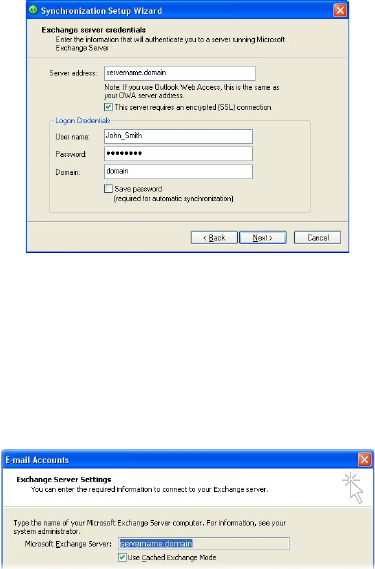
Synchronizing Information and Setting Up E-mail Security 55
5. On the Exchange server credentials screen, enter the Exchange server
address, your user name and password, and the domain name.
If you do not know the Exchange server address and the domain
name, check with your network administrator, or do the following to
find them in your computer:
a. In Outlook, click Tools > E-mail Accounts.
b. Select View or change existing e-mail accounts.
c. Double-click Microsoft Exchange Server.
d. On the Exchange Server Settings screen, you will see the Exchange
Server name.
e. To check the domain name, click Start > Settings > Control
Panel, then double-click System.
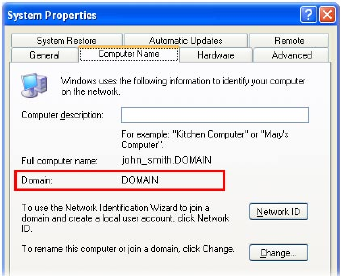
56 Synchronizing Information and Setting Up E-mail Security
f. In the System Properties dialog box, click the Computer Name
tab. You will then see the domain name.
6. On your device, you also need to enter the Exchange server settings.
For information about this, see “Synchronize Outlook information with
Exchange Server.”
7. On the Synchronization Setup Wizard, click Next.
8. Select the information types to synchronize between your device and
computer.
If you want to synchronize your device with both your computer and
Exchange Server, do the following:
a. For the Contacts, Calendar, E-mail, and Tasks items, choose
whether to synchronize them with the computer or with the
Exchange Server. These items cannot be synchronized to both.
b. Select the check boxes of the other information types if you want
to synchronize them with your computer.
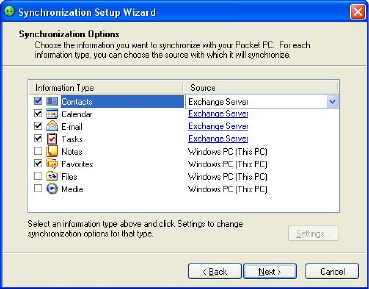
Synchronizing Information and Setting Up E-mail Security 57
Information types on the PC and Exchange Server
9. Click Next.
10. Click Finish.
When you finish the wizard, ActiveSync synchronizes your device
automatically. Once synchronization completes, you can disconnect your
device from your PC.

58 Synchronizing Information and Setting Up E-mail Security
4.2 Synchronizing Information
When you connect your device to the PC using a USB cable or a Bluetooth
connection, ActiveSync will immediately synchronize. While your device
is connected, ActiveSync synchronizes every time you make a change on
either the PC or your device.
To manually start and stop synchronization
1. Connect your device to the PC:
• To synchronize Outlook information and other local information
on the PC, including media files, connect your device to the PC
using Bluetooth or a USB cable.
• If you are synchronizing directly with Exchange Server, you can
use this connection to the PC to "pass through" to the network, or
you can synchronize without connecting to the PC over a cellular
network.
2. In ActiveSync, tap Sync. To end synchronization before it completes,
tap Stop.
Note ActiveSync 4.x utilizes a network type of connection with Windows Mobile
powered devices, since this allows faster data transfer than a serial USB
connection. When the PC is connected to the Internet or a local network, in
some cases, the PC may disconnect the ActiveSync connection with your
device in favor of the Internet or network connection. If this happens, tap
Start > Settings > Connections tab > USB to PC, then clear the Enable
advanced network functionality check box. This makes ActiveSync utilize a
serial USB connection with your device.
The USB to PC ( ) icon appears on the Today Screen when your device
is connected to your computer and you enable a serial USB connection
between them.
Synchronize Outlook information with the computer
If you have set up a synchronization relationship between your device and
the PC, synchronization keeps Outlook information up-to-date on both your
device and PC.

Synchronizing Information and Setting Up E-mail Security 59
You can also set up your device to synchronize with more than one PC
or with a combination of one or more PCs and Exchange Server. When
synchronizing with multiple computers, the items that you synchronize
will appear on all of the computers with which they are synchronized. For
example, if you have set up synchronization with two PCs (PC1 and PC2),
which have different items, and you synchronize Contacts and Calendar on
your device with both computers, the result is as follows:
Location New state
PC1 All Outlook contacts and calendar appointments that were on PC2
are now also on PC1.
PC2 All Outlook contacts and calendar appointments that were on PC1
are now also on PC2.
Pocket PC
Phone
All Outlook contacts and calendar appointments from both PC1
and PC2 are on your device.
Note Outlook e-mail can be synchronized with only one computer.
To change which information is synchronized
ActiveSync synchronizes a limited amount of information by default to save
storage space on your device. You can change the amount of information
that is synchronized by performing the following steps.
Note Before changing synchronization settings on your device, disconnect it from
your PC.
1. In ActiveSync on your device, tap Menu > Options.
2. Do one or both of the following:
• Select the check box for any items you want to synchronize. If you
cannot select a check box, you might have to clear the check box
for the same information type elsewhere in the list.
• Clear the check box for any items you want to stop synchronizing.
• To stop synchronizing with one PC completely, tap the PC and tap
Delete.
Note To change available synchronization settings, select the type of information
and tap Settings.
60 Synchronizing Information and Setting Up E-mail Security
Synchronize Outlook information with Exchange Server
You can set up synchronization with Exchange Server on your device, if
it is available to you through your company or wireless service provider.
However, you should first gather information, such as Exchange Server
name, domain name, your user name, and password, and then carry on
with the steps. (For information about how to check the Exchange server
name and domain on your PC, see “To install and set up ActiveSync on the
computer.”)
Note Before changing synchronization settings on your device, disconnect it from
your PC.
To synchronize directly with Exchange Server
1. Do one of the following:
• Tap Start > Messaging, then tap Menu > Tools > New Account.
On the E-mail Setup screen, select Outlook E-mail in the Your
e-mail provider list, then tap Next.
• In ActiveSync on your device, tap
Menu > Configure Server. If
you have not yet set up synchronization with Exchange Server, this
appears as Add Server Source.
2. In Server address, enter the name of the server running Exchange
Server, and tap Next.
3. Enter your user name, password, and domain, and tap Next.
To change the rules for resolving synchronization conflicts, tap
Advanced.
4. Select the check boxes for the types of information items that you
want to synchronize with Exchange Server.
5. To change available synchronization settings, select the type of
information, and tap Settings.
6. Tap Finish.
Schedule synchronization with Exchange Server
You can schedule information to be synchronized automatically between
your device and the Exchange Server, or schedule synchronization at
regular time intervals. Choose between these two methods, depending on
your e-mail volume and which method you think is more cost-effective.
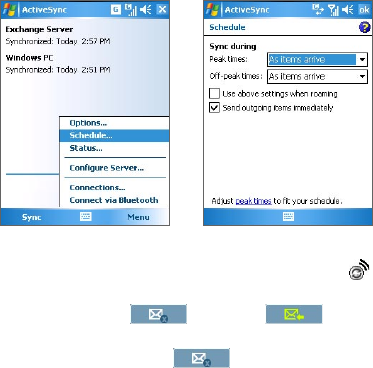
Synchronizing Information and Setting Up E-mail Security 61
To receive e-mails and synchronize other information instantly
Direct Push technology (push e-mail feature) enables you to receive new
e-mails on your device as soon as they arrive in your Inbox on the Exchange
Server. With this feature, items, such as contacts, calendar and tasks are
also immediately updated onto your device when these items have been
changed or new entries have been added on the Exchange Server. To make
Direct Push work, you need to have a GPRS connection on your device.
The Direct Push feature works for your device only if it is connected to
a private network (corporate network) that is using Microsoft Exchange
Server Service Pack 2 (SP2) with Exchange ActiveSync. You need to perform
a full synchronization between your device and the Exchange Server first
before Direct Push can be enabled.
• Using ActiveSync to enable Direct Push
1. In ActiveSync on your device, tap Menu > Schedule.
2. Select As items arrive in the Peak times and Off-peak times boxes.
• Using Comm Manager to enable Direct Push
1. On the Today screen, tap the Comm Manager icon ( ).
2. On the Comm Manager screen, tap the Microsoft Direct Push
button. The button will turn to , which indicates that
you will receive e-mails as they arrive.
When the button is in the state, you need to manually
retrieve your e-mails.
62 Synchronizing Information and Setting Up E-mail Security
To schedule synchronization at regular time intervals
You can set how often to synchronize during Peak times (which usually
refer to your working hours) when e-mail volume is high, as well as Off-
peak times when e-mail volume is low.
1. In ActiveSync on your device, tap Menu > Schedule.
2. Select a shorter time interval in the Peak times box for you to be able
to receive e-mails more frequently.
3. Select a longer interval in the Off-peak times box.
Tip To set the days and hours that make up your peak and off-peak times, tap
Adjust peak times to fit your schedule.
4.3 Synchronizing via Bluetooth
You can connect and synchronize your device with the PC using Bluetooth.
To synchronize with a computer via Bluetooth
1. Follow the instructions in ActiveSync Help on the computer for
configuring Bluetooth on your computer to support ActiveSync.
2. On your device, tap Start > Programs > ActiveSync.
3. Tap Menu > Connect via Bluetooth. Make sure the Bluetooth
function of both your device and the computer are turned on, and
they are within close range.
4. If this is the first time you have connected to this computer via
Bluetooth, you must first complete the Bluetooth wizard on your
device and set up a Bluetooth partnership between your device
and the computer. For more information about creating a Bluetooth
partnership, see “Bluetooth partnerships” in Chapter 6.
Notes • To preserve battery power, turn off Bluetooth when not in use.
• To connect and synchronize your device with a computer via Bluetooth,
your computer must have a Bluetooth adapter or dongle.
Synchronizing Information and Setting Up E-mail Security 63
4.4 Synchronizing Music and Video
If you want to carry your music or other digital media along with you while
you travel, ActiveSync works with Windows Media Player to synchronize
music and video with your device.
Other than selecting the media information type in ActiveSync to be
synchronized, all media synchronization settings must be set in Windows
Media Player. Before media can be synchronized, you must do the following:
• Install Windows Media Player Version 10 on the PC. (Windows Media
Player 10 works only in Windows XP or later versions).
• Connect your device to the PC with a USB cable. If your device is
currently connected using Bluetooth, you must end that connection
before media can be synchronized.
• Insert a storage card into your device (32MB or larger is
recommended).
• Set up a sync partnership between the storage card and Windows
Media Player.
Change Media synchronization settings
Once you select the Media information type in ActiveSync to be
synchronized, any of your favorite music and video files in Windows
Media Player playlists can be synchronized. All you have to do is set up
synchronization in Windows Media Player for those media files.
To set up a sync relationship with a storage card
1. On the computer, open Windows Media Player.
2. Click the Sync tab.
3. Select the storage card.
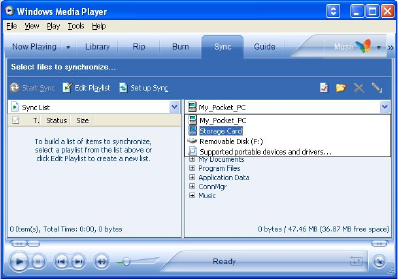
64 Synchronizing Information and Setting Up E-mail Security
4. Click Set up Sync.
5. Choose whether to synchronize automatically or manually.
For more information about Windows Media Player on your device, see
“Using Windows Media Player” in Chapter 8.
4.5 Setting Up E-mail Security
Windows Mobile on your device protects your Outlook e-mails through
Secure/Multipurpose Internet Mail Extension (S/MIME), which allows you to
digitally sign your messages as well as encrypt them.
Using authorization keys and certificates, S/MIME allows you to digitally
sign your e-mail messages to prove your identity to the recipients.
Authorization keys are also used when encrypting messages to improve
privacy and prevent undue tampering or hacking of your messages. You
can encrypt a message with or without a certificate. However, to read an
encrypted message, you need a valid certificate to decrypt it.
Note S/MIME encryption and digital signatures for Windows Mobile-based devices
are available only with Exchange Server 2003 Service Pack 2 or a later version
that supports S/MIME. If you are not using one of these products, or have not
yet synchronized, these options are unavailable.
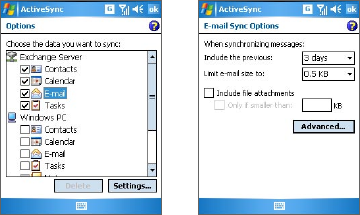
Synchronizing Information and Setting Up E-mail Security 65
Digitally sign and encrypt all messages
ActiveSync allows you to set up S/MIME e-mail encryption and signing.
You must obtain a valid certificate to sign and encrypt e-mail messages
successfully.
1. Tap Start > Programs > ActiveSync.
2. Tap Menu > Options.
3. Select the E-mail information type, and tap Settings. On the E-mail
Sync Options screen, tap Advanced.
4. Do one or both of the following:
• To sign all your outgoing e-mail messages so that recipients can
be certain that the messages were sent by you and have not been
altered in any way, select the Sign all outgoing e-mail messages
check box.
• To encrypt all your outgoing e-mail messages so that the
contents of your messages are protected from being viewed by
anyone other than the intended recipients, select the Encrypt all
outgoing e-mail messages check box.
5. Tap Choose Certificate to select a certificate for signing or
encrypting outgoing e-mail messages.
You can select certificates to sign or encrypt e-mail messages
individually if you do not choose to sign or encrypt all outgoing
e-mail. For information about signing and encrypting individual
messages, see “Individually sign and encrypt a message” in Chapter 7.
66 Synchronizing Information and Setting Up E-mail Security
68 Managing Your Pocket PC Phone
5.1 Personalizing Your Pocket PC Phone
Customize the Today screen
The Today screen shows your upcoming appointments, active tasks, and
information about incoming messages. You can customize the Today screen
on your device.
To customize the Today screen
1. Tap Start > Settings > Personal tab > Today.
2. On the Appearance tab, select the desired theme for the background
of the Today screen.
3. On the Items tab, select the items you want to appear on the Today
screen.
Tip To change the order of items displayed on the Today screen, tap the item,
and tap Move Up or Move Down.
To add a custom background image
You can use one of your own pictures as the background image on the
Today screen. Be aware that pictures can affect the readability of text on the
Today screen.
1. Tap Start > Settings > Personal tab > Today.
2. Select the Use this picture as the background check box, and tap
Browse to view a list of your picture files.
3. Tap the file name of the picture you want to use.
4. Tap OK.
To set options for displaying appointments on the Today screen
If you have a large number of appointments, you may want to specify the
kind of appointments that are displayed on the Today screen.
1. Tap Start > Settings > Personal tab > Today.
2. Tap the Items tab.
3. Select Calendar and tap Options.
Managing Your Pocket PC Phone 69
4. Do any of the following:
• Select Next appointment to show only the next appointment
in your schedule, or Upcoming appointments to show multiple
appointments.
• Clear the Display all day events check box if you do not want to
display all-day events.
To set options for displaying tasks on the Today screen
If you have a large number of tasks, you may want to specify the kind of
tasks that are displayed on the Today screen.
1. Tap Start > Settings > Personal tab > Today.
2. Tap the Items tab.
3. Select Tasks and tap Options.
4. Do any of the following:
• Under Display number of, select the type of tasks you want to
appear on the Today screen.
• In the Category list, select whether to display only tasks assigned
to a specific category or to display all tasks.
Customize the Start menu
You can choose which items appear in the Start menu.
1. Tap Start > Settings > Personal tab > Menus.
2. Select the check boxes of the items you want to appear in the Start
menu. You can select up to seven items.
Tip You can also create folders and shortcuts to appear on the Start menu. In
ActiveSync on your PC, click Explore. In the Mobile Device window, double-
click My Windows Mobile-Based Device > Windows > Start Menu, then
create the folders and shortcuts that you want. You will see the added items
after you synchronize.
70 Managing Your Pocket PC Phone
Why is the device name important?
The device name is used to identify the device in the following situations:
• Synchronizing with a PC
• Connecting to a network
• Restoring information from a backup
Note If you synchronize multiple devices with the same PC, each device must have
a unique name.
To change the device name
1. Tap Start > Settings > System tab > About.
2. Tap the Device ID tab.
3. Enter a name.
Note The device name must begin with a letter, consist of letters from A to
Z, numbers from 0 to 9, and cannot contain spaces. Use the underscore
character to separate words.
Set Date / Time / Regional Options
You can set up the correct date, time, and regional settings according to
your use.
To set the time and date
1. Tap Start > Settings > System tab > Clock & Alarms > Time tab.
2. Select the correct time zone and change the date or time.
Note During synchronization, the time on your device is updated with the time on
your PC.
To set the time and date for a different location
If you visit or communicate with someone in a particular time zone often,
you can select it as your visiting time zone.
1. Tap Start > Settings > System tab > Clock & Alarms > Time tab.
2. Tap Visiting.
3. Select the correct time zone and change the time or date.

Managing Your Pocket PC Phone 71
To set an alarm
1. Tap Start > Settings > System tab > Clock & Alarms > Alarms tab.
2. Tap <Description> and enter a name for the alarm.
3. Tap the day of the week for the alarm. You can select multiple days by
tapping each desired day.
4. Tap the time to open a clock and set the time for the alarm.
5. Tap the alarm icon ( ) to specify the type of alarm you want. You
can choose a flashing light, a single sound, a repeating sound, or
vibration.
6. If you choose to play a sound, tap the list next to the Play sound
check box and tap the sound you want.
To change regional settings
The style in which numbers, currency, dates, and times are displayed is
specified in regional settings.
1. Tap Start > Settings > System tab > Regional Settings.
2. On the Region tab, select your region from the list.
Note This does not change the Operating System language of your device.
3. The region you select determines which options will be available on
the other tabs.
4. To customize settings further, tap the appropriate tabs and select the
desired options.
Personal and system settings
To reassign programs or shortcuts to program buttons
Your device may come with programs already assigned to hardware
buttons. You can customize these buttons to open the programs you
use most, or to perform certain shortcuts, such as changing the screen
orientation, opening the Today screen, or opening Input Panel.
1. Tap Start > Settings > Personal tab > Buttons.
2. A list of buttons and their current assignments are displayed on the
Program Buttons tab.

72 Managing Your Pocket PC Phone
3. Tap the button you want to reassign. To help you identify the buttons,
there are numbers and icons representing the original function of the
button.
4. In the Assign a program box, tap the program or shortcut you want
to assign.
5. Tap OK.
To increase or decrease the size of text on the screen
1. Tap Start > Settings > System tab > Screen > Text Size tab.
2. Move the slider to increase or decrease the text size.
To choose how to be notified about events or actions
1. Tap Start > Settings > Personal tab > Sounds & Notifications.
2. On the Sounds tab, choose how you want to be notified by selecting
the appropriate check boxes.
3. On the Notifications tab, in Event, tap an event name and choose
how you want to be notified by selecting the appropriate check
boxes. You can choose from several options, such as a special sound, a
message, or a flashing light.
Tip Turning off sounds and the flashing light helps conserve battery power.
To find the operating system version number
• Tap Start > Settings > System tab > About.
The version of the operating system on your device is shown near the top of
the About screen.
To get detailed device information
• Tap Start > Settings > System tab > About.
The Version tab displays important device information, including the type
of processor and the amount of memory that is installed.
To make the battery last longer
• Tap the battery icon ( ) on the Today screen. On the Advanced
tab of the Power settings screen, you can specify when your device
turns off the display to conserve battery power. For optimum
conservation, specify 3 minutes or less.
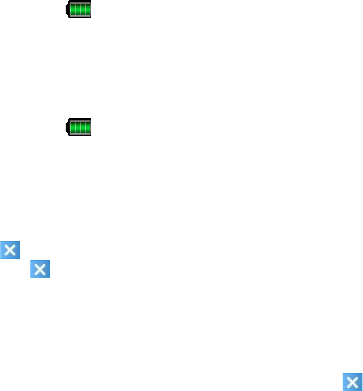
Managing Your Pocket PC Phone 73
• Use the AC adapter to plug your device into external power whenever
possible, especially when using the SD™ card or when using a modem
or other peripherals.
• Adjust the backlight settings.
To adjust the brightness of the backlight
1. Tap the battery icon ( ) on the Today screen.
2. On the Power settings screen, tap Menu > Backlight.
3. On the Brightness tab, move the slider right to increase the
brightness, or left to decrease the brightness.
To set the backlight to dim after a time delay
1. Tap the battery icon ( ) on the Today screen.
2. On the Power settings screen, tap Menu > Backlight.
3. Tap the Battery power tab, or the External power tab.
4. Select the Turn off backlight if device is not used for check box, and
specify the time delay.
To configure the button using Task Manager
You can configure the button to shut down running programs and free
up the memory space that’s occupied by them.
1. Tap Start > Settings > System tab > Task Manager.
2. Select the Enable the “X” button to end running programs check
box.
3. Choose the action for shutting down programs (by tapping the
button, tapping and holding the button, or both).
4. Tap OK.
Note When the Enable the “X” button to end running programs check box is
not selected, tapping the “X” button will only close a program screen. The
program is not ended and continues to run in the background.
74 Managing Your Pocket PC Phone
Phone settings
You can customize phone settings, such as the ring type and ring tone to
be used for incoming calls, and the keypad tone to be used when entering
phone numbers. Open the Phone program to customize these settings.
To change the ring tone
1. On the Phone screen, tap Menu > Options > Phone tab.
2. In the Ring tone list, tap the sound you want to use.
Tip To use custom *.wav, *.mid, *.mp3, or *.wma files as ring tones, use
ActiveSync on your PC to copy the files to the /Windows/Rings folder on your
device. Next, select the sound from the Ring tone list. For more information
about copying files to your device, see ActiveSync Help on your PC.
To change the ring type
You can change the way that you are notified of incoming calls. For
example, you can choose to be notified by a ring, a vibration, or a
combination of both.
1. On the Phone screen, tap Menu > Options > Phone tab.
2. In the Ring type list, tap the desired option.
To change the keypad tone
You can change the tone you hear when entering a phone number on the
keypad. If set to Long tones, the tone is heard continuously for as long as
the number on the keypad is pressed. Use this setting if you are having
trouble accomplishing tasks that rely on tones from your phone, such as
accessing messages from an answering machine. If set to Short tones, the
tone is heard only for one or two seconds. If set to Off, no tone will be heard.
1. From the Phone keypad, tap Menu > Options > Phone tab.
2. In the Keypad list, tap the option you want.
Phone services
Phone services, such as Call Waiting, enable you to choose how to handle all
incoming calls on your device.
To choose the services
1. Tap Start > Settings > Personal tab > Phone > Services tab.
2. Select the service you want to use, then tap Get Settings.
Managing Your Pocket PC Phone 75
Networks
You can view available mobile phone networks, determine the order
in which your device accesses another network if the current one is
unavailable, and specify whether you want to change networks manually
or automatically. For more information about network settings, see Help on
your device.
To change phone network settings
1. Tap Start > Settings > Personal tab > Phone > Network tab.
2. By default, your device displays the current network as offered
by your service provider. You can customize to set your preferred
network.
To set preferred networks
1. Tap Start > Settings > Personal tab > Phone > Network tab. By
default, the Network selection field is set to Automatic. However,
you can set it to Manual to choose your own network at any point of
time.
2. Tap Set Networks.
3. Select the networks on the Phone: Preferred networks screen and
sort them according to your preference.
4. Tap OK.
76 Managing Your Pocket PC Phone
5.2 Adding and Removing Programs
Before you purchase additional programs for your device, you should note
the model name of your device, the version of Windows Mobile software
running on it, and the type of processor. This information will help you
select a program that is compatible with your device. For more information,
see “To get detailed device information” and “To find the operating system
version number” in this chapter.
Programs available for purchase usually include a Setup program
(commonly named "setup.exe") that you must first run on your PC. You can
then use ActiveSync to add programs to your device, or add a program
directly from the Internet.
To add programs
1. Download the program to your PC (or insert the CD or disk that
contains the program into your PC). You may see a single *.exe file,
a *.zip file, a Setup.exe file, or several versions of files for different
device types and processors. Be sure to select a program designed for
your device and processor type.
2. Read any installation instructions or documentation that comes with
the program. Many programs provide special installation instructions.
3. Connect your device to the PC.
4. Double-click the *.exe file.
• If the executable file is an installation wizard, follow the
instructions on the screen. The wizard will automatically install the
program to your device.
• If an installation wizard does not start, you will see an error
message stating that the program is valid but that it is designed
for a different type of computer. You will need to copy this
program directly to your device. If you cannot find any installation
instructions for the program, use ActiveSync to copy the program
file to the Program Files folder on your device.
Managing Your Pocket PC Phone 77
To remove programs
You can only remove programs that you installed. Programs that come with
your device cannot be removed.
1. Tap Start > Settings > System tab > Remove Programs.
2. In the Programs in storage memory list, select the program you
want to remove, and tap Remove.
3. Tap Yes. If another confirmation message appears, tap Yes again.
5.3 Managing Memory
You may need to stop a program if it becomes unstable or the program
memory is low.
To see how much memory is available
• Tap Start > Settings > System tab > Memory.
• On the Main tab, the amount of memory allocated to file and data
storage versus program storage is displayed, as well as the amount of
memory in use versus the available memory.
To see available storage card memory
You can see how much memory is available on a storage card that is
inserted in your device.
1. Tap Start > Settings > System tab > Memory.
2. Tap the Storage Card tab.
To free up program memory
Try the following to free memory on your device:
• Close programs you are not currently using.
• Move e-mail attachments to a storage card.
• Move files to a storage card. Tap Start > Programs > File Explorer.
Tap and hold the file, and tap Cut. Browse to the storage card folder
and tap Menu > Edit > Paste.
• Delete unnecessary files. Tap Start > Programs > File Explorer. Tap
and hold the file, and tap Delete.

78 Managing Your Pocket PC Phone
• Delete large files. To find your largest files, tap Start > Programs >
Search. In the Type list, tap Larger than 64 KB, and tap Search.
•
In Internet Explorer Mobile, delete temporary Internet files and clear
history information. For more information, see “Internet Explorer
Mobile” in Chapter 6.
• Remove programs you no longer use.
• Reset your device.
To close a program
Tapping the button in a program may just close the program screen.
In this case, the program continues to run in the background. You can end
running programs manually by following these steps:
1. Tap Start > Settings > System tab > Memory > Running Programs
tab.
2. In the Running Programs List, tap the program you want to close,
and tap Stop.
Tips •
In most programs, you can also use the on-screen keyboard shortcut
Ctl+q to shut down the program.
• You can configure the button to directly shut down running programs.
For more information, see “To configure the button using Task
Manager".
5.4 Copying Files
You can copy files to your PC using ActiveSync, or copy files to a storage
card you insert into your device. Your device has an expansion slot for
inserting the SD™ card.
Using ActiveSync, you can copy or move information from the PC to your
device and vice versa. Copying a file results in separate versions of a file on
your device and PC. Because the files are not synchronized, changes made
to one file will not affect the other.
Note If you want to automatically update information on both your device and PC,
synchronize the information instead. For more information about copying
and synchronizing files, see ActiveSync Help on your PC.

Managing Your Pocket PC Phone 79
To copy files to a storage card
1. Make sure the storage card is properly inserted into your device.
2. Tap Start > Programs > File Explorer and navigate to the
appropriate folder.
3. Tap and hold the file you want to copy, and tap Copy.
4. Tap the folder list (labeled My Documents by default) and tap
Storage Card.
5. Tap Menu > Edit > Paste.
To copy a file between your device and the PC
1. Connect your device to the PC.
2. In ActiveSync, click Explore, which opens the Mobile Device folder of
your device.
3. To copy a file from your device to your PC:
a. In the Mobile Device folder, go to the file that you want to copy.
b. Right-click the file, then click Copy.
c. Locate the destination folder on your PC. Right-click the folder,
then click Paste.
4. To copy a file from your PC to your device:
a. On your PC, navigate to the folder that contains the file you want
to copy.
b. Right-click the file, then click Copy.
c. Right-click the destination folder under Mobile Device, then click
Paste.
To automatically save files on a storage card
In the Word Mobile, Excel Mobile, and Notes programs, you may find it
helpful to save all new documents, notes, and workbooks directly on a
storage card.
1. From the program file list, tap Menu > Options.
2. With a storage card inserted in your device, in the Save to box, select
the appropriate storage card to automatically save new files on the
storage card.
3. Tap OK.
Note In the file or note list, a storage card symbol ( ) is displayed next to the
names of files saved on a storage card.
80 Managing Your Pocket PC Phone
5.5 Protecting Your Pocket PC Phone
There are two kinds of protection that you can set for your device:
• You can protect your SIM card from unauthorized use by assigning
a PIN (personal identification number). Your first PIN will be given to
you by your wireless service provider; you can change the PIN later.
• Additionally, you can prevent unauthorized access to any part of the
device by using password protection. You can help keep your data
more secure by requiring a password every time the device is turned
on. You create your own password when you begin using your device.
To protect your SIM card with a PIN
1. On the Phone screen, tap Menu > Options > Phone tab.
2. Select the Require PIN when phone is used check box.
3. To change the PIN at any time, tap Change PIN.
Tip Emergency calls can be placed at any time, without requiring a PIN.
To protect your device with a password
1. Tap Start > Settings > Personal tab > Lock.
2. Select the Prompt if device unused for check box, and in the box to
the right, select how long your device must be idle before a password
is required. In the Password type box, select the type of password
you would like to use. Enter the password and, if necessary, confirm
the password.
If your device is configured to connect to a network, use an
alphanumeric password for increased security for your device.
3. On the Hint tab, enter a phrase that will help you remember your
password, but does not allow others to guess your password.
The hint will be displayed after the wrong password is entered four
times.
4. Tap OK. The next time the device is turned on, you will be prompted
to enter your password.
Managing Your Pocket PC Phone 81
Notes •
Each time a wrong password is entered, the device response time gets
longer until the device appears to be not responding.
• If you forget your password, you must follow the instructions in this user
manual to clear the memory before you can access your device.
To change your password
1. Tap Start > Settings > Personal tab > Lock. You will be prompted to
enter your current password.
2. In the Password box, enter your new password.
3. On the Hint tab, enter a phrase that will help you remember your new
password, but does not allow others to guess your password.
The hint will be displayed after the wrong password is entered four
times.
4. Tap OK.
To display owner information on the ‘my info’ screen
Having your contact information displayed on the ‘my info’ screen on
startup allows for easy identification of the device in case it is lost.
1. Tap Start > Settings > Personal tab > Owner Information.
2. On the Options tab, select the Identification information check box.
3. If you want additional text displayed, tap the Notes tab and enter the
text (for instance: Reward if found).
4. On the Options tab, select the Notes check box.
5. Tap OK.
Tip To display owner information on the Today screen, tap Start > Settings >
Personal tab > Today. On the Items tab, select the Owner Info check box.
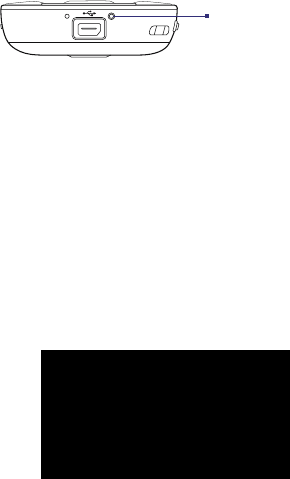
82 Managing Your Pocket PC Phone
5.6 Resetting Your Pocket PC Phone
Occasionally, you may need to reset your device. A normal (or soft) reset
of your device clears all active program memory and shuts down all
active programs. This can be useful when your device is running slower
than normal, or a program is not performing properly. A soft reset is
also necessary after the installation of some programs. If a soft reset is
performed when programs are running, unsaved work will be lost.
To perform a soft reset
• Use the stylus to press the RESET button found on the bottom side of
your device. Your device restarts and displays the Today screen.
RESET button
You can also perform a hard reset (also known as a full reset). A hard
reset should be performed only if a normal reset does not solve a system
problem. After a hard reset, the device is restored to its default settings - the
way it was when you first purchased it and turned it on. Any programs you
installed, data you entered, and settings you customized on your device will
be lost. Only Windows Mobile software and other pre-installed programs
will remain.
To perform a hard reset
1. Press and hold the left SOFT KEY and the right SOFT KEY, and at the
same time, use the stylus to press the RESET button at the middle left
side of your device.
2. Release the stylus, but continue pressing the two SOFT KEYs until you
see the following message on the screen:
This operation will delete
all your personal data,
and reset all settings
to manufacturer default.
Press Send to restore
manufacturer default, or
press other keys to cancel.

Managing Your Pocket PC Phone 83
3. Release the two SOFT KEYs, and then press the TALK (Send) button on
your device.
TALK (Send) button
Warning! Your device will be set back to factory default settings. Please ensure any
additional installed programs and/or user data have been backed up before
a hard reset is performed.
84 Managing Your Pocket PC Phone
86 Getting Connected
6.1 Connecting to the Internet
Your device’s powerful networking capabilities allow you to access
the Internet or your corporate network at work through wireless and
conventional connections. Specifically, you can configure your phone to
establish a connection via Dial-up, GPRS, Bluetooth, Virtual Private Network
(VPN) or Proxy.
With an active connection on your phone, you can browse the Web,
download e-mails or chat using MSN Messenger. Check with your service
provider to see if a connection has already been set up for you and if over-
the-air configuration is supported.
In times when you are not within the coverage of a wireless network, you
can either use GPRS or phone dial-up to connect your device to the Internet
or your corporate network. Your device has two groups of connection
settings: My ISP (Internet Service Provider) and My Work Network. The My
ISP settings are used to connect to the Internet, while My Work Network
settings can be used to connect to any private, corporate network.
To set up a GPRS connection to the Internet
GPRS is a non-voice value-added service that allows information to be sent
and received across a mobile telephone network. You can use GPRS to
connect to the Internet or to send and receive MMS on your device. You will
be billed per KB (Kilobyte) by your wireless service provider when you are
sending or receiving information via GPRS.
If GPRS settings are not preset on your device, obtain the Access point
name from your wireless service provider. Also, check with your wireless
service provider if a user name and password are required.
1. Tap Start > Settings > Connections tab > Connections.
2. Under My ISP, tap Add a new modem connection.
3. On the Make New Connection screen, enter a name for the
connection.
4. In the Select a modem list, select Cellular Line (GPRS), then tap
Next.
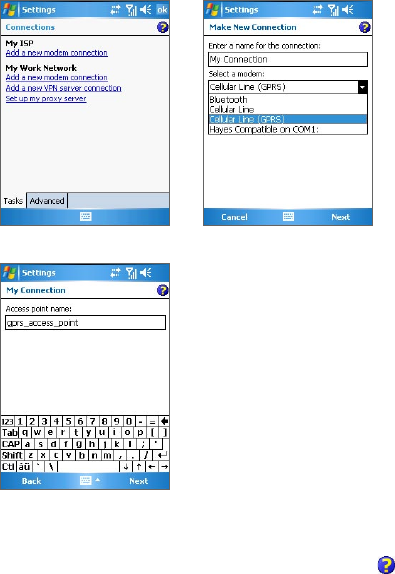
Getting Connected 87
5. Enter the Access point name, then tap Next.
6. Enter the user name and password, only if required.
7. Tap Finish.
Notes •
To view help information for any screen, tap the help icon ( ).
•
To modify your connection settings, tap Manage existing connections
on the Connections screen, and complete the connection wizard.
88 Getting Connected
To set up a dial-up connection to your ISP
When you use your device to dial up to your ISP and connect to the
Internet, you will be billed by the number of minutes that you use.
To establish a dial-up connection on your device, you need the same
settings that you normally use when you dial up from your computer. This
includes the ISP server phone number, your user name and password.
1. Tap Start > Settings > Connections tab > Connections.
2. Under My ISP, tap Add a new modem connection.
3. On the Make New Connection screen, enter a name for the
connection.
4. In the Select a modem list, select Cellular Line, then tap Next.
5. Enter the ISP server phone number, then tap Next.
6. Enter your user name, password, and any other information required
by your ISP.
7. Tap Finish.
To set up a connection to a private network
1. Obtain the following information from your network administrator:
• Server phone number
• User name
• Password
• Domain (and other required settings, such as IP address)
2. Tap Start > Settings > Connections tab > Connections.
3. In My Work Network, follow the instructions for each type of
connection.
4. Complete the connection wizard, then tap Finish.
To start a connection
After setting up a connection, such as GPRS or ISP dial-up on your device,
you can now connect your device to the Internet. The connection is started
automatically when you begin using a program that requires an Internet
connection. For example, when you start Internet Explorer Mobile to
browse the Internet, your device connects automatically.

Getting Connected 89
If you have set up multiple types of connections on your device, you can
manually start a connection.
1. Tap Start > Settings > Connections tab > Connections.
2. Tap Manage existing connections.
3. Tap and hold the name of the desired connection, then tap Connect.
To disconnect the GPRS connection
Do one of the following:
• Tap the Comm Manager icon ( ) on the Today screen, then tap the
Data Connection button ( ).
• Press and hold END on your device for at least three seconds.
6.2 Internet Explorer Mobile
Internet Explorer is a full-featured Internet browser, optimized for use on
your device.
To start Internet Explorer
• Tap Start > Internet Explorer.
To set a Home page
1. In the address bar on top of the Internet Explorer screen, enter the
desired Web page address. Tap to open the Web page.
2. Tap Menu > Tools > Options > General tab.
3. Do one of the following:
• To use the displayed page as the Home page, tap Use Current.
• To use the default Home page, tap Use Default.
Tip To go to your Home page, tap Menu > Home.
To transfer favorites from your PC
You can transfer the favorites you have stored on your PC to your device by
synchronizing the Internet Explorer favorites on your PC with your device.
1. In ActiveSync on your PC, on the Tools menu, click Options, and
select Favorites.
90 Getting Connected
2. In Internet Explorer on your PC, click Favorites > Add to Favorites
and save or move favorite links to the Mobile Favorites subfolder in
the Favorites list.
3. Connect your device to your PC. If synchronization does not start
automatically, click Sync.
To add a favorite
1. In Internet Explorer Mobile, go to the page you want to add.
2. Tap and hold the page, and tap Add to Favorites.
3. Confirm or change the name, and select a folder for storing the
favorite.
4. Tap Add.
To delete a favorite or folder
1. In Internet Explorer Mobile, tap Menu > Favorites > Add/Delete tab.
2. Select the item you want to delete, and tap Delete.
To change the size of text on Web pages
• In Internet Explorer Mobile, tap Menu > Zoom, and tap the size you
want.
To change how Web pages fill the screen
1. In Internet Explorer Mobile, tap Menu > View.
2. Tap one of the following:
• One Column. Arranges the content into one column that is as
wide as the screen. This means that you will rarely have to scroll
horizontally.
• Default. Maintains a layout similar to what you see on a desktop
computer, but it makes items smaller and arranges the content so
that you can see most of it without having to scroll horizontally.
• Desktop. Keeps the same layout and size as on a desktop
computer, which will require both horizontal and vertical scrolling.
To clear the History list
1. In Internet Explorer Mobile, tap Menu > Tools > Options > Memory
tab.
2. Tap Clear History.
Getting Connected 91
To save a picture from a Web page
1. In Internet Explorer Mobile, tap and hold the picture, and tap Save
Image.
2. Do one of the following:
• To save the picture in My Pictures on your device, tap Yes.
• To save the picture in another location, such as a storage card, tap
Save As.
To delete temporary Internet files
Your device temporarily stores Web pages that you frequently visit or have
visited recently to speed up the display of these Web pages when you
access them. You may want to delete these files to free storage space.
1. In Internet Explorer Mobile, tap Menu > Tools > Options > Memory
tab.
2. Tap Delete Files. All pages stored on your device, including offline
favorites content, will be deleted.
To set up Internet security settings
Cookies are small files containing information about your identity and
preferences so that a page can tailor information to your needs. The page
sends the file, and it is stored on your device.
1. In Internet Explorer Mobile, tap Menu > Tools > Options > Security
tab.
2. To prevent Internet Explorer Mobile from accepting any cookies, clear
the Allow cookies check box.
3. Select the check boxes for the other security options you want, and
tap OK.
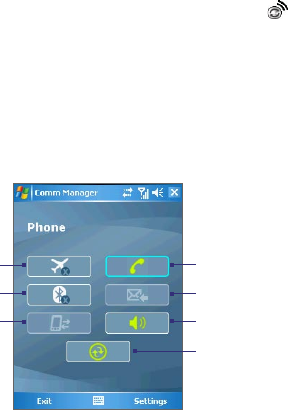
92 Getting Connected
6.3 Using Comm Manager
Comm Manager acts like a central switcher that lets you enable or disable
phone features as well as manage your data connections easily.
To open Comm Manager
• Tap the Comm Manager icon ( ) on the Today screen; or
• Press the Comm Manager button on the right side of the device.
Simply tap the corresponding button to enable or disable a feature.
1
2
3
4
5
6
7
1Tap to toggle between turning on or off Flight
mode.
2Tap to toggle between turning on or off
Bluetooth. Tap Settings > Bluetooth to
configure Bluetooth on your device. See
"Using Bluetooth" for details.
3Tap to disconnect active data services (e.g.
GPRS). You cannot reconnect data services in
Comm Manager.
4Tap to toggle between enabling or disabling
the phone. Tap Settings > Phone to set
the ring tone and other phone settings. For
more information about customizing phone
settings, see Chapter 5.
5Tap to toggle between automatically
receiving (as items arrive) or manually
retrieving Outlook e-mails. For more
information, see "Schedule synchronization
with Exchange Server" in Chapter 4.
6Tap to toggle between turning on the
phone's ringer or setting the phone to
vibration/mute mode.
7Tap to open ActiveSync so you can
synchronize the device and computer. For
more information about the configuration
settings for ActiveSync, see Chapter 4.
Getting Connected 93
6.4 Using Bluetooth
Bluetooth is a short-range wireless communications technology. Devices
with Bluetooth capabilities can exchange information within a distance
of about 10 meters without requiring a physical connection. You can even
beam information to a device in a different room, as long as it is within the
Bluetooth signal coverage range.
Bluetooth can be used in the following ways:
• Beam information, such as files, appointments, tasks, and contact
cards, between devices that have Bluetooth capabilities.
• Synchronize information between your device and computer via
Bluetooth.
• Use a Bluetooth-enabled headset (or other Bluetooth-enabled hands-
free device, such as a car kit) with your device for hands-free phone
conversations.
• Use a Bluetooth service. Once you connect to another device or
computer using Bluetooth, you can locate and use any of the services
available on that device.
• Create a connection between your device and another Bluetooth-
enabled phone to use that phone as a modem.
Note Normally, you will need another phone as a modem only if your Pocket PC
device has no integrated phone capability.
Bluetooth modes
Bluetooth on your device operates in three different modes:
• On. Bluetooth is turned on. Your device can detect other Bluetooth-
enabled devices, but not vice versa.
• Off. Bluetooth is turned off. In this mode, you can neither send
nor receive information using Bluetooth. You might want to turn
Bluetooth off at times in order to conserve battery power, or in
situations where using a wireless device is prohibited, such as on
board an aircraft and in hospitals.
• Visible. Bluetooth is turned on, and all other Bluetooth-enabled
devices can detect your device.
94 Getting Connected
Note By default, Bluetooth is turned off. If you turn it on, then turn off your device,
Bluetooth also turns off. When you turn on your device again, Bluetooth
automatically turns on.
To turn Bluetooth on and make your device visible
1. On your device, tap Start > Settings > Connections tab > Bluetooth.
2. Select the Turn on Bluetooth and Make this device visible to other
devices check boxes.
3. Tap OK.
Bluetooth partnerships
A Bluetooth partnership is a relationship that you create between your
device and another Bluetooth-enabled device in order to exchange
information in a secure manner. Creating a partnership between two
devices involves entering the same Bluetooth passcode on both devices.
Creating a partnership between two devices is a one-time process. Once
a partnership is created, the devices can recognize the partnership and
exchange information without entering a passcode again. Make sure that
on the two devices, Bluetooth is turned on and in visible mode.
To create a Bluetooth partnership
1. On your device, tap Start > Settings > Connections tab >
Bluetooth.
2. On the Devices tab, tap Add new device. Your device searches for
other Bluetooth devices and displays them in the box.
3. Tap the desired device name in the box.
4. Tap Next.
5. Specify a passcode to establish a secure connection. The passcode
can be 1 up to 16 characters.
6. Tap Next.
7. Wait for the paired device to accept the partnership. The receiving
party needs to enter the same passcode that you specified.
8. The name of the paired device is then displayed. You may edit and
enter a new name for that device.
9. Select the check boxes of services that you want to use from the
paired device.
10. Tap Finish.
Getting Connected 95
To accept a Bluetooth partnership
1. Ensure that Bluetooth is turned on and in visible mode.
2. Tap Yes when prompted to establish a partnership with the other
device.
3. Enter a passcode (the same passcode that is entered on the device
requesting the partnership) to establish a secure connection. The
passcode must be between 1 and 16 characters.
4. Tap Next.
5. Tap Finish. You can now exchange information with the paired
device.
To rename a Bluetooth partnership
1. Tap Start > Settings > Connections tab > Bluetooth.
2. Tap and hold the partnership on the Devices tab.
3. On the shortcut menu, tap Edit.
4. Enter a new name for the partnership.
5. Tap Save.
To delete a Bluetooth partnership
1. Tap Start > Settings > Connections tab > Bluetooth.
2. Tap and hold the partnership on the Devices tab.
3. Tap Delete.
Connect a Bluetooth hands-free or stereo headset
For hands-free phone conversations, you can use a Bluetooth hands-free
headset, such as a car kit with your device.
Just like when connecting to any Bluetooth device, you also need to enter
a passcode when connecting to a Bluetooth hands-free or stereo headset.
The passcode is fixed and cannot be changed on a Bluetooth headset.
Before you connect it to your device, check for the proper passcode in the
manufacturer’s documentation.
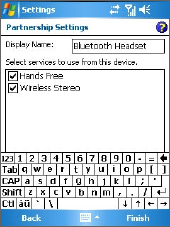
96 Getting Connected
To connect a Bluetooth hands-free or stereo headset
1. Make sure that both your device and the Bluetooth headset are
turned on and within close range, and that the headset is visible.
Refer to the manufacturer’s documentation to find out how to set the
headset in visible mode.
2. Tap Start > Settings > Connections tab.
3. Tap Bluetooth > Devices tab > Add new device. Your device
searches for other Bluetooth-enabled devices and displays them in
the list.
4. Tap the name of the Bluetooth headset,
then tap Next.
5. Enter the passcode of the Bluetooth
headset, then tap Next.
6. Make sure the Hands Free check box is
selected.
If you have a Bluetooth stereo headset,
also make sure the Wireless Stereo
check box is selected.
7. Tap Finish.
Note If the Bluetooth stereo headset becomes disconnected, turn the headset on
and repeat steps 1 to 3 above. Tap and hold the name of the Bluetooth stereo
headset and tap Set as Wireless Stereo.
Beam information using Bluetooth
You can beam information, such as contacts, calendar items, and tasks, as
well as files from your device to your computer or to another Bluetooth-
enabled device.
Note If your computer does not have built-in Bluetooth capability, you need to
connect and use a Bluetooth adapter or dongle on your computer.
To beam information from your device to a computer
1. Turn on Bluetooth on your device, and make your device visible. For
information about this, see “To turn Bluetooth on and make your
device visible”.
Getting Connected 97
2. You also need to set Bluetooth on your computer to visible mode. Do
one of the following:
• If your computer has Windows XP SP2 and your computer’s built-
in or external Bluetooth adapter is supported by Windows XP
SP2, open Bluetooth Devices from the Control Panel. Click the
Options tab, then select the Turn discovery on and the Allow
Bluetooth devices to connect to this computer options.
• If the Bluetooth adapter on your computer was installed using
a third-party provided driver, open the Bluetooth software
that came with the Bluetooth adapter. This software varies
by manufacturer, but in most cases, you will find a Bluetooth
Configuration utility which you can open from the Control Panel.
After Bluetooth Configuration opens, click the Accessibility
tab, then select Let other Bluetooth devices to discover this
computer. Refer to the Bluetooth adapter’s documentation for
more information.
3. Create a Bluetooth partnership between the two devices.
For information about creating a partnership, see “Bluetooth
partnerships”.
After a partnership has been created successfully, your computer is
ready to receive Bluetooth beams.
4. On your device, tap and hold an item to beam. The item can be an
appointment in your calendar, a task, a contact card, or a file.
5. To beam a contact, tap Menu > Send Contact > Beam. To beam other
types of information, tap Menu > Beam [type of item].
6. Tap the device name to which you want to send the beam.
7. If you beamed an Outlook item and it is not automatically added to
Outlook, select File > Import and Export in Outlook to import it.
To beam information to a Bluetooth-enabled device, such as another Pocket
PC, follow steps 3 to 6 in the above procedure.
Note If the computer or device you want to beam to does not appear in your
device's Bluetooth list, make sure that its Bluetooth is turned on and set to
visible mode.

98 Getting Connected
To receive a Bluetooth beam
Your device will not detect and notify you of incoming Bluetooth beams
unless you set it up to do this.
1. Tap Start > Settings > Connections tab > Beam.
2. Select the Receive all incoming beams check box.
3. Make sure your device is turned on, visible, and within close range of
the device that is beaming the information.
4. When prompted to receive an incoming beam, tap Yes to receive the
beamed information.
Bluetooth Explorer and Bluetooth file sharing
Bluetooth Explorer searches for other Bluetooth devices that have file
sharing enabled and lets you access their Bluetooth shared folder. You
can copy files from and to their shared folder, and create subfolders in it.
When you enable Bluetooth file sharing on your device, other Bluetooth-
enabled devices will also be able to access your Bluetooth shared folder.
To enable Bluetooth Explorer and Bluetooth file sharing on your device
1. Tap Start > Settings > Connections tab > Bluetooth > FTP tab.
2. Select the Enable Bluetooth Explorer check box. This makes the
\Bluetooth device folder visible in the File Explorer.
3. Select the Enable File Sharing check box.
You can use the default Bluetooth shared folder, or tap Browse to use
another folder as your shared folder.
To use Bluetooth Explorer
1. Bluetooth Explorer is integrated with the File Explorer program. You
can open it by tapping Start > Programs > Bluetooth Explorer or
by tapping Down arrow ( ) on the upper left of File Explorer then
tapping Bluetooth.
2. Bluetooth Explorer then scans for other Bluetooth devices that have
file sharing enabled. From the list, tap to select a Bluetooth device you
want to connect to. You may need to enter a passcode in order for you
to connect to the selected device.
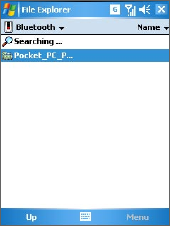
Getting Connected 99
3. If there are files contained in the
Bluetooth shared folder on the other
device, you will be able to see them on
the Bluetooth Explorer screen.
Select one or more files, then tap Menu >
Edit and choose to cut or copy the files.
4. Tap Up twice.
5. Navigate to the folder where you want to
paste the files on your device, then tap
Menu > Edit > Paste.
Use the device as a Bluetooth modem
You can connect your device to a notebook or desktop computer through
Bluetooth and use the device as a modem for the computer.
Note If your computer does not have built-in Bluetooth capability, you need to
connect and use a Bluetooth adapter or dongle on your computer.
For the computer to use the Internet connection of your device, activate
Internet Sharing on your device, then set up a Bluetooth Personal Area
Network (PAN) between the computer and your device.
1. On your device, turn on Bluetooth and set it to visible mode.
2. Initiate a Bluetooth partnership from your device by following the
steps in “To create a Bluetooth partnership.“
Alternatively, you can initiate a Bluetooth partnership from the
computer by following these steps (based on Windows XP SP2):
a. In the Control Panel or System Tray, double-click the Bluetooth
Devices icon.
b. In the Bluetooth Devices window, click Add.
c. The Add Bluetooth Device Wizard opens. Select the My device is
set up and ready to be found check box, then click Next.
d. The wizard then detects your device and displays its name in the
dialog box. Select the device name, then click Next.
100 Getting Connected
e. Select Let me choose my own passkey, then enter a passcode
(1 up to 16 digits) that will serve as an identification number for
establishing a secure connection between your device and the
computer. Click Next.
f. A confirmation message then appears on your device. Tap Yes to
accept the connection, enter the same passcode, then tap Next.
g. On the computer, click Finish to exit the wizard.
h. On your device’s Partnership Settings screen, you can change the
display name for the computer, then tap Finish.
3. Now, open the Internet Sharing program on your device. Tap Start >
Programs > Internet Sharing.
4. Select Bluetooth PAN as the PC Connection.
5. From the Network Connection list, select the name of the
connection that your device uses to connect to the Internet.
6. Tap Connect.
7. On your computer, set up a Bluetooth Personal Area Network (PAN)
with your device:
a. Tap Start > Control Panel > Network Connections.
b. Under Personal Area Network, click the Bluetooth Network
Connection icon.
c. Under Network Tasks, click View Bluetooth network devices.
d. In the Bluetooth Personal Area Network Devices dialog box, select
your device, then click Connect.
8. On the Internet Sharing screen on your device, check if a connected
status is displayed, which indicates that your computer has been
successfully connected to the Internet using your device as a
Bluetooth modem.
Getting Connected 101
Use another Bluetooth phone as a modem
You can use another phone that has Bluetooth as a modem for your device
to browse the Internet or to transfer other information.
To do this, create a Bluetooth modem connection on your device and then
send information to the phone by using Bluetooth. The phone relays the
information over the mobile phone network and then sends back to your
device any information that you had requested over the connection.
Once you create a modem connection to the Bluetooth phone, you can
reuse it whenever you want to use the phone as a modem. Make sure that
Bluetooth is turned on and visible mode is enabled on both your device and
the phone, and that the two are within close range.
Note Normally, you will need another phone as a modem only if your Pocket PC
device has no integrated phone capability.
To use a Bluetooth phone as a modem for your device
1. On your device, tap Start > Settings > Connections tab >
Connections.
2. Tap Add a new modem connection.
3. Enter a name for the connection.
4. In the Select a modem list, tap Bluetooth.
5. Tap Next.
6. If the phone appears in the My Connections list, skip to step 11.
7. If the phone does not appear in the My Connections list, tap Add
new device, and follow the remaining steps.
8. Select the phone from the list and tap Next.
9. Enter a passcode and tap Next.
10. Enter the same passcode on the phone and tap Finish.
11. In the My Connections list on your device, select the phone and tap
Next.
12. Enter the phone number to dial for this connection and tap Next.
13. Enter the required logon information for this connection and tap
Finish.
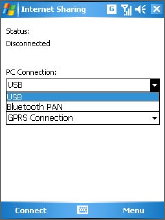
102 Getting Connected
6.5 Using Internet Sharing
Internet Sharing connects your PC or notebook computer to the Internet
by using your device’s data connection (GPRS or EDGE, for instance). You
can choose to connect via USB or Bluetooth.
Follow the procedure in this section to set up your device as a USB modem.
To learn how to set up your device as a Bluetooth modem, see “Use the
device as a Bluetooth modem” in this chapter.
Notes • Make sure your device has a SIM card installed, and you have set up a
GPRS or phone dial-up modem connection on your device. If your device
has not been set up with a data connection yet, tap Menu > Connection
Settings on the Internet Sharing screen. For more information about
setting up a GPRS connection, see "To set up a GPRS connection to
the Internet". For more information about setting up a phone dial-up
connection, see "To set up a dial-up connection to your ISP".
•
If you want to use a USB cable connection, you must first install Microsoft
ActiveSync version 4.2 or later on the computer.
•
Before using Internet Sharing, disable ActiveSync on your computer.
To set up your device as a USB modem
1. On your device, tap Start > Programs >
Internet Sharing.
2. In the PC Connection list, select USB.
3. In the Network Connection list, select
the name of the connection that your
device uses to connect to the Internet.
4. Plug in the USB cable between your
device and the computer.
5. Tap Connect.
To end the Internet connection
• On the Internet Sharing screen, tap
Disconnect.

Getting Connected 103
6.6 Using Spb GPRS Monitor
Spb GPRS Monitor measures the amount of data transfers that you have
made via GPRS or a phone dial-up connection, and calculates network
usage costs. Using this program, you can monitor how much data you
have sent and received on your device, and check the network usage costs
by taking into account your service plan details: inclusive data amount,
data block size, etc. You can also view connection cost and traffic charts,
generate reports of network connection usage, and export reports to CSV
files for use with Microsoft® Excel and Access.
Install GPRS Monitor
The GPRS Monitor program is included on the CD. To install it onto your
device, run the program’s installer on your computer. Follow the on-screen
instructions on your computer and your device to complete the installation.
The Today Plug-in
After you have installed GPRS Monitor on your device, you will find its
program icon in Start > Programs. In addition, GPRS Monitor is also added
to the Today screen as a plug-in. This plug-in shows connection statistics, a
brightness panel, battery panel, and shortcut icons.
1
2 3 4 5 6
1Tap to open the GPRS Monitor screen where
you can set up monitoring, view cost and
traffic charts, and generate reports.
2Tap inside the control bar to adjust the
backlight level.
3This is the battery power monitor. Tap it to
access the Power Settings screen.
4Tap to toggle between connecting or
disconnecting your default data connection.
5Tap to open Internet Explorer Mobile.
6Tap to open Messaging.

104 Getting Connected
To show or hide items on the Today Plug-in
1. Tap Start > Settings > Personal tab > Today.
2. On the Items tab, tap GPRS Monitor then tap Options.
3. On the Display tab, specify the refresh interval for updating
statistics, time period for monitoring data transfers, and the types of
information to be shown on the plug-in.
4. On the Additional Items tab, choose whether to show or hide the
brightness panel, battery panel, and shortcut icons on the plug-in.
5. Tap OK.
The GPRS Monitor icon and pop-up window
Another way of displaying status information visually is by enabling the
GPRS Monitor icon to be shown on the title bar. This icon shows the GPRS/
dial-up connection speed, data traffic, and battery status.
To show the GPRS Monitor icon on the title bar
1. Tap Start > Programs > Spb GPRS Monitor.
2. Tap Tools > Options > Icon tab.
3. Select the Show taskbar icon check box.
4. By default, the GPRS Monitor icon shows three bars that represent the
following status information:
Tap Customize to change the status information shown on the icon.
Icon Bar 2: Traffic
(Full bar corresponds to
100%. Each bar is 20%.)
Icon Bar 3: Battery
(Each bar corresponds to
20% of the total charge.)
Icon Bar 1: Speed
(Full bar corresponds
to 19KB/sec.)
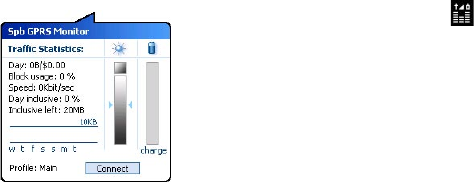
Getting Connected 105
To customize the GPRS Monitor pop-up window
When you tap the GPRS Monitor icon
on the title bar, a pop-up window opens
and shows you detailed statistics about data
transfers, such as the data size just transferred
and its cost, the data amount left that you are
allowed to transfer, and more.
On the GPRS Monitor screen, tap Tools >
Options > Popup tab to choose what types
of statistics to show on the pop-up window.
Set up monitoring and notification
To select the connection to be monitored
1. On the GPRS Monitor screen, tap Tools > Options > Connection tab.
2. Select the Enable connection monitoring check box.
3. In the Connection list, select the connection you want to monitor.
Tip GPRS Monitor can be configured to monitor data transfers via your local
service provider as well as international service providers when you send or
receive data through roaming. You can set up multiple profiles, with each
profile configured with the service plan details of a certain service provider.
For more information about profiles, see "Set up multiple profiles".
To enter your service plan details
Service plan details, or tariff, determine the price that you pay for your
data transfers. The tariff may either be flat rate or time-based, depending
on whether you are using GPRS or a phone dial-up connection for data
transfers.
Contact your service provider to find out about your tariff, and enter the
information in the Tariff tab or the Tariff Details tab on the Options screen.
Note The calculation of network usage costs is based on the information that you
entered, and is an estimate only. The actual amount billed by your service
provider may differ.
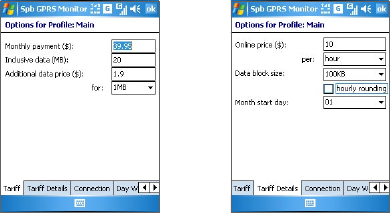
106 Getting Connected
Options: Tariff Details tabOptions: Tariff tab
To set up traffic limit notifications
You can set up traffic limit notifications if you want to be notified when a
traffic limit is reached.
1. On the GPRS Monitor screen, tap Tools > Options.
2. Enable the notifications on the Day Warn and Month Warn tabs. You
can specify up to three daily and three monthly limits.
Once traffic reaches one of these limits, you will receive a notification.
Set up multiple profiles
When you make data transfers on your device, you may be charged with
different tariffs in certain situations, or your device may need to connect
through a different type of connection to send or receive data. Typical cases
are GPRS roaming and different pricing for connections, such as WAP. In
such situations, you can set up multiple profiles in GPRS Monitor to measure
the traffic and cost for each type of connection.
To set up and configure multiple profiles
1. On the GPRS Monitor screen, tap Tools > Profiles.
2. Select a profile that you want to customize.
3. Select the connection to be associated to this profile and enable
monitoring of this connection. To do so, follow the steps in “To select
the connection to be monitored”.
Getting Connected 107
4. Enter the tariffs that you are charged for this connection. For more
information about tariffs, see “To enter service plan details”.
5. Repeat steps 1 to 4 to configure more profiles.
6. When you have finished profile setup, tap OK.
To switch between profiles
1. On the GPRS Monitor screen, tap Tools > Profiles.
2. Select your desired profile, or select Auto change profile to enable
the GPRS Monitor to automatically change to an active profile based
on the connection you are using.
3. Tap OK.
View charts and reports
On the GPRS Monitor, you can view network connection cost charts and
traffic charts, as well as generate detailed reports of network connection
usage during a given period of time. These reports can be exported to CSV
files that you can open using Excel, Access, or other similar spreadsheet and
database software.
To view charts and generate reports
On the GPRS Monitor screen:
• Tap the Chart tab to view the network connection cost charts and
traffic charts.
• Tap the Report tab to generate reports on network traffic and tariff.
For more information about using Spb GPRS Monitor, see Help on your
device.
108 Getting Connected
6.7 Using Terminal Services Client
The Terminal Services Client allows you to log on to a PC running Terminal
Services or Remote Desktop, and use all the resources available on that PC.
For example, instead of running Word Mobile on your device, you can run
the PC version of Word and access the .doc files available on that PC.
To connect to a Terminal Server
1. On your device, tap Start > Programs > Terminal Services Client.
2. Enter the server name.
3. You can also select a server name in Recent servers if you have
recently connected to a server.
4. Select the Limit size of server desktop to fit on this screen check
box if you want to use programs that have been specifically sized for
use with your device.
5. Tap Connect.
To navigate within Terminal Services Client
When connected to a remote server, you may notice that the screen is
displaying more than one horizontal and vertical scroll bar. Use these
scroll bars to either scroll the contents on the PC, or to scroll the PC display
through the Terminal Services Client window.
To make sure you are scrolling the PC display through Terminal Services
Client, use the five directional buttons at the bottom of the Terminal
Services Client window. To better fit information on the screen, select the
Limit size of server desktop to fit on this screen check box. For best
results, the programs on your desktop PC should be maximized.
To disconnect without ending a session
1. From the Terminal Services Client screen on your device, tap Start >
Shutdown.
2. Tap Disconnect.
Getting Connected 109
Notes • Do not use the Start menu on your device.
•
If a network administrator has configured Terminal Services Client on
your device to reconnect to disconnected sessions, and you previously
disconnected from a Terminal Server without ending the session, the
Terminal Services Client reconnects to that session.
To disconnect after ending a session
1. From the Terminal Services Client screen on your device, tap Start >
Shutdown.
2. Tap Log Off.
110 Getting Connected
112 Exchanging Messages and Using Outlook
7.1 E-mail and Text Messages
Messaging is where all of your e-mail accounts and your text message
account are located. You can send and receive Outlook e-mail, Internet
e-mail through an Internet service provider (ISP), as well as SMS (Short
Messaging Service) text messages using your mobile phone network. You
can also access e-mail from work using a VPN connection.
E-mail Setup Wizard
Before you can send and receive e-mails, you need to set up your e-mail
account on your device. The E-mail Setup Wizard makes it easy and simple
to set up your Outlook e-mail and POP3/IMAP4 accounts on your device.
To set up e-mail accounts using E-mail Setup Wizard
1. Tap Start > Messaging.
2. Tap Menu > Tools > New Account to access the E-mail Setup Wizard.
3. The E-mail Setup Wizard guides you step-by-step through the setup
process.
For more information on setting up your Outlook e-mail account, see “Set
up Outlook e-mail”. For information on POP3 or IMAP4 setup, see “Set up a
POP3/IMAP4 e-mail account”.
Set up Outlook e-mail
When starting ActiveSync on your computer for the first time, the
Synchronization Setup Wizard prompts you to set up a synchronization
relationship. This allows you to synchronize Outlook e-mail and other
information between your device and your computer or the Exchange
Server. If you have already set up synchronization through the wizard, then
your device is ready to send and receive Outlook e-mail. For information
about the Synchronization Setup Wizard, see “To install and set up
ActiveSync on the computer” in Chapter 4.
If you have not set up a synchronization relationship yet, do the following to
set up your device to synchronize Outlook e-mail:
Exchanging Messages and Using Outlook 113
1. To synchronize remotely, you need to set up and connect to an over-
the-air connection (GPRS or ISP dial-up). For more details, see the
procedures in “Connecting to the Internet” in Chapter 6.
2. Disconnect your device from your computer or LAN. (If you have an
over-the-air connection, there is no need to disconnect).
3. Tap Start > Programs > ActiveSync.
4. If you want to synchronize e-mails directly with the Exchange Server
on a private network, such as your corporate network, follow the
steps in “Synchronize Outlook information with Exchange Server” in
Chapter 4.
5. Choose which information types to synchronize. Make sure E-mail is
selected. For details, follow the steps in “To change which information
is synchronized” in Chapter 4.
Everytime you want to manually send or receive Outlook e-mail on your
device, just connect your device to your computer, LAN, or over-the-air
connection, then tap Sync on the ActiveSync screen or tap Menu > Send/
Receive in Outlook on your device.
For details about scheduling automatic synchronization or setting
a synchronization time with the Exchange Server, see “Schedule
synchronization with Exchange Server” in Chapter 4.
Set up a POP3/IMAP4 e-mail account
Set up a POP3 or IMAP4 e-mail account on your device if you have an e-
mail account with an Internet service provider (ISP) or an account that you
access using a VPN server connection (typically a work account).
1. Tap Start > Messaging.
2. Tap Menu > Tools > New Account.
3. On the E-mail Setup screen, select Other (POP3/IMAP) in the Your
e-mail provider list, then tap Next.
4. Enter your e-mail address, then tap Next. Auto configuration
attempts to download necessary e-mail server settings so that you do
not need to enter them manually.
5. Once Auto configuration has finished, tap Next.
6. Enter your name (the name you want displayed when you send e-
mail), user name, and password; tap Next.

114 Exchanging Messages and Using Outlook
Select the Save password check box if you want to save your password so
that you do not need to enter it again.
If Auto configuration was successful, the Your name and User name fields
automatically get populated. Tap Next, then Finish to complete setting
up your account, or tap Options under Server information to access
additional settings. For example:
• Change the time intervals for downloading new messages.
• Limit the amount of messages that are downloaded and
authentication method for outgoing mails.
• Download full messages or parts of messages.
If Auto configuration is unsuccessful or you have an account you access
using a VPN server connection, contact your ISP or network administrator
for the following information and enter it manually:
Setting Description
User name Enter the user name assigned to you by your ISP or network
administrator. This is often the first part of your e-mail address,
which appears before the at sign (@).
Password Choose a strong password. You have the option to save
your password so you do not need to enter it each time you
connect to your e-mail server.
Account type Select POP3 or IMAP4.
Account name Enter a unique name for the account, such as Work or Home.
This name cannot be changed later.
Incoming mail
server
Enter the name of your e-mail server (POP3 or IMAP4).
Outgoing mail
server
Enter the name of your outgoing e-mail server (SMTP).
Domain Not required for an account with an ISP. May be required for a
work account.
Require SSL
connection
Select this to ensure you always receive e-mail for this account
using an SSL connection. This enables you to receive personal
information more securely. Please note that if you select this
and your ISP does not support an SSL connection, you will not
be able to connect to receive e-mail.

Exchanging Messages and Using Outlook 115
Setting Description
Outgoing
mail requires
authentication
Select this if your outgoing e-mail server (SMTP) requires
authentication. Your user name and password from above will
be used.
Use separate
settings
Select this if your outgoing e-mail server requires a different
user name and password than the ones you entered before.
Outgoing server settings:
User name Enter your user name for the outgoing e-mail server.
Password Enter your password for the outgoing e-mail server.
Domain Enter the domain of the outgoing e-mail server.
Require SSL for
outgoing mail
Select this to ensure you always send e-mail from this account
using an SSL connection. This enables you to send personal
information more securely. Note that if you select this and
your ISP does not support an SSL connection, you will not be
able to send e-mail.
Tip You can set up several e-mail accounts in addition to your Outlook e-mail
account.
Send and receive messages
To compose and send a message
1. In the message list, tap Menu > Go To and select an account.
2. Tap New.
3. Enter the e-mail address or mobile phone number of one or more
recipients, separating them with a semicolon. To access addresses and
phone numbers from Contacts, tap To.
4. Enter your message. To quickly add common messages, tap Menu >
My Text and tap a desired message.
5. To check the spelling, tap Menu > Spell Check.
6. Tap Send.
116 Exchanging Messages and Using Outlook
Tips • To enter symbols, tap Shift using the on-screen keyboard.
• To set the priority, tap Menu > Message Options.
•
If you are working offline, e-mail messages are moved to the Outbox
folder and will be sent the next time you connect.
•
If you are sending a text message and want to know if it was received,
before composing the message, tap Menu > Tools > Options. Tap Text
Messages and select the Request delivery notifications check box.
To reply to or forward a message
1. Open the message and tap Reply, or Menu > Reply All, or Menu >
Forward.
2. Enter your response. To quickly add common messages, tap Menu >
My Text and tap a desired message.
3. To check the spelling, tap Menu > Spell Check.
4. Tap Send.
Tips • To see more header information, scroll up.
• To always include the original message, from the list view, tap Menu >
Tools > Options > Message tab, and select the When replying to e-mail,
include body check box.
• In the Outlook E-mail account, you will send less data if you do not edit
the original message. This may reduce data transfer costs based on your
rate plan.
To exclude your e-mail address when replying to all
When you reply to all the recipients of an e-mail, your own e-mail address
will also be added to the recipient list. You can customize ActiveSync so that
your e-mail address will be excluded from the recipient list.
1. In ActiveSync on your device, tap Menu > Options.
2. Select the E-mail information type and tap Settings.
3. Tap Advanced.
4. In the Primary e-mail address text box, enter your e-mail address.
5. Tap OK.
Exchanging Messages and Using Outlook 117
To add an attachment to a message
1. In a new message, tap Menu > Insert and tap the item you want to
attach: Picture, Voice Note, or File.
2. Select the file you want to attach, or record a voice note.
To receive attachments
An attachment sent with an e-mail message or downloaded from the server
appears below the subject of the message. Tapping the attachment opens
the attachment if it has been fully downloaded, or marks it for download
the next time you send and receive e-mail. You can also download
attachments automatically with your messages if you have an Exchange
Server mail account.
If you have an Outlook e-mail account, do the following:
1. Tap Start > Programs > ActiveSync.
2. Tap Menu > Options.
3. Tap E-mail > Settings, then select Include file attachments.
If you have an IMAP4 e-mail account with an Internet service provider (ISP)
or an account that you access using a VPN server connection (typically a
work account), do the following:
1. Tap Start > Messaging.
2. Tap Menu > Tools > Options.
3. Tap the name of the IMAP4 account.
4. Tap Next until you reach Server information, and tap Options.
5. Tap Next twice, and select Get full copy of messages and When
getting full copy, get attachments.
Tip To store attachments on a storage card rather than on the device, tap
Menu > Tools > Options > Storage tab, and select the Store attachments
on storage card check box.
118 Exchanging Messages and Using Outlook
Download messages
The manner in which you download messages depends on the type of
account you have:
• To send and receive e-mail for an Outlook e-mail account, begin
synchronization through ActiveSync. For more information, see “Set
up Outlook e-mail” in this chapter.
• To send and receive e-mail messages for an e-mail account that you
have with an ISP or that you access using a VPN server connection
(typically a work account), download messages through a remote
e-mail server. For more information, see “To download messages from
the server” later in this chapter.
• Text messages are automatically received when the phone is turned
on. When the phone is turned off, messages are held by your service
provider until the next time the phone is turned on.
To download messages from the server
To send and receive e-mail messages for an e-mail account that you have
with an ISP or that you access using a VPN server connection (typically a
work account), you first need to connect to the Internet or your corporate
network, depending on the account.
1. Tap Menu > Go To and tap the account you want to use.
2. Tap Menu > Send/Receive. The messages on your device and e-mail
server are synchronized: new messages are downloaded to the device
Inbox folder, messages in the device Outbox folder are sent, and
messages that have been deleted from the server are removed from
the device Inbox folder.
Tip If you want to read the entire message, tap Menu > Download Message
while in the message window. If you are in the message list, tap and hold
the message, and tap Download Message. The message will download
the next time you send and receive e-mail. This will also download message
attachments if you selected those options when you set up the e-mail
account.
Exchanging Messages and Using Outlook 119
Copy text messages from and to the SIM card
1. Tap Start > Messaging.
2. Tap Menu > Go To > Text Messages.
3. In the message list, select the text message you want to copy.
4. Do one of the following:
• To copy a text message to the SIM card, tap Menu > Copy to SIM.
• To copy a text message from the SIM card to your device, tap
Menu > Copy to Inbox.
Note Text messages stored on your SIM card are automatically displayed in the
Inbox folder. Copying them to your device results in duplicate messages in
the Inbox folder when your SIM card is in use.
Individually sign and encrypt a message
Encrypting an Outlook e-mail message protects the privacy of the message
by converting it from plain, readable text into cipher (scrambled) text. Only
the recipient who has the authorization key can decipher the message.
Digitally signing a message applies your certificate with the authorization
key to the message. This proves to the recipient that the message is from
you and not from an imposter or a hacker, and that the message has not
been altered.
To digitally sign and encrypt a new message
1. In the message list, tap Menu > Go To > Outlook E-mail.
2. Tap New.
3. Tap Menu > Message Options.
4. Select the Encrypt message and Sign message check boxes, and tap
OK.
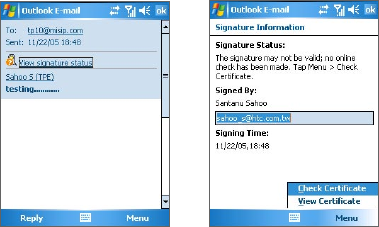
120 Exchanging Messages and Using Outlook
Verify the digital signature on a signed message you receive
1. Open the Outlook e-mail message that has been digitally signed.
2. At the top of the message, tap View Signature Status.
3. Tap Menu > Check Certificate.
To view the details of the certificate in the message, tap Menu > View
Certificate.
Note There can be several reasons why a digital signature is not valid. For example,
the sender’s certificate may have expired, it may have been revoked by the
certificate authority, or the server that verifies the certificate is unavailable.
Contact the sender to report the problem.
Manage folders
Each Messaging account has its own folder hierarchy with five default
Messaging folders: Inbox, Outbox, Deleted Items, Drafts, and Sent Items.
The messages you receive and send through the account are stored in
these folders. You can also create additional folders within each hierarchy.
The Deleted Items folder contains messages that have been deleted on the
device. The behavior of the Deleted Items and Sent Items folders depends
on the Messaging options you have chosen.
If you use an Outlook e-mail account, e-mail messages in the Inbox folder in
Outlook will be synchronized automatically with your device. You can select
to synchronize additional folders by designating them for synchronization.
Exchanging Messages and Using Outlook 121
The folders you create and the messages you move will then be mirrored
on the e-mail server. For example, if you move two messages from the
Inbox folder to a folder named Family, and you have designated Family for
synchronization, the server creates a copy of the Family folder and copies
the messages to that folder. You can then read the messages while you are
away from your PC.
If you use a text message account, messages are stored in the Inbox folder.
If you use a POP3 account and you move e-mail messages to a folder you
created, the link is broken between the messages on the device and their
copies on the e-mail server. The next time you connect, the e-mail server
will detect that the messages are missing from the Inbox folder on the
device and will delete them from the e-mail server. This prevents having
duplicate copies of a message, but it also means that you will no longer
have access to messages that you move to folders created from anywhere
except the device.
If you use an IMAP4 account, the folders you create and the e-mail
messages you move are mirrored on the e-mail server. Therefore, messages
are available to you anytime you connect to your e-mail server, whether it
is from your device or PC. This synchronization of folders occurs whenever
you connect to your e-mail server, create new folders, or rename/delete
folders when connected. You can also set different download options for
each folder.
122 Exchanging Messages and Using Outlook
7.2 MMS Messages
Creating and sharing multimedia messages (MMS) with your friends and
family are easy with your device. You can attach pictures or video, and
an audio clip in an MMS. You can even use the device camera to capture
photos and video clips while composing a new MMS message, and send
them along with your message.
Notes •
Please note that MMS is a charged service. In order to use MMS
successfully, this has to be provisioned on your mobile account. Please
contact the wireless service provider to have this provisioned as part of
your calling plan.
•
Please ensure the size of the MMS is within the limits of the wireless
service provider if sending to another mobile phone user or sending to an
e-mail address.
To access MMS
1. Tap Start > Messaging.
2. Tap Menu > Go To > MMS.
Change MMS settings
When you send an MMS message, an SMS notification message will first be
sent to the recipient, while your MMS message will be temporarily stored
on an MMS server of your wireless service provider. When others send you
an MMS message, similarly, the MMS message will be stored on the MMS
server until you retrieve it. Hence, your device must be configured with
the location of the MMS server for you to be able to send and receive MMS
messages on your device.
When you purchase your device, it is already preset with your wireless
service provider’s MMS server settings. If you accidentally lost the preset
settings or you changed to another wireless service provider, follow the
steps below to configure MMS settings.
To configure MMS settings
1. Tap Start > Messaging.
2. Tap Menu > Tools > Options.
3. Tap MMS in the accounts list to configure settings. The MMS
Configuration screen appears.
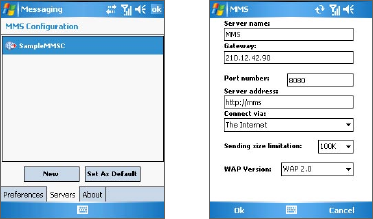
Exchanging Messages and Using Outlook 123
4. In the Preferences tab, select or clear the provided check boxes
according to your needs. You can choose to keep track of your
MMS messages, retrieve messages immediately, accept or reject
messages, and request a delivery or read receipt. You can also specify
a resolution for images you send and message delivery attempts.
5. Tap the Servers tab and check if your device is preset with MMS
server settings.
If there are no preset settings, tap New and enter the following
information, which you can get from your wireless service provider:
• Server name. A descriptive name, such as your wireless service
provider name.
• Gateway. Location of the MMS server, which is usually in the form
of an IP address.
• Port number. HTTP port number used for connecting to the MMS
server and for file transfer.
• Server address. URL address of the MMS server.
• Connect via. Select the connection that your device uses for MMS.
• Sending size limitation. Select the maximum MMS message size
allowed by your wireless service provider.
• WAP version. Select either WAP 1.2 or WAP 2.0, depending on
which one is being used by your wireless service provider.
6. Tap OK. The MMS server settings will then be added as an entry on
the MMS Configuration screen.
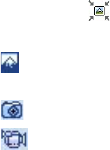
124 Exchanging Messages and Using Outlook
Note If you add several MMS service providers to the MMS Configuration screen,
you can choose one as your default MMS provider. Select the MMS provider's
name in the list then tap Set As Default.
Create and send MMS messages
After configuring the required settings, you can start to compose and send
MMS messages.
To compose an MMS message
You can compose MMS messages in a combination of various slides, where
each slide can consist of a photo, audio or video clip, and/or text.
1. On the MMS screen, tap New.
2. When you see the Choose a MMS screen, tap a preset template, or tap
Custom to open a blank MMS message.
Note If you prefer to always use a blank MMS message, select the Always choose
custom check box.
3. In To, enter the recipient’s phone number or e-mail address directly,
or tap To, Cc, or Bcc to choose a phone number or an e-mail address
from Contacts.
4. Enter a subject for your message.
5. Tap the Insert icon ( ) to select and insert a photo or video clip.
When selecting a photo or video clip, you can:
• Tap to view it first, then tap Select to use the selected photo or
video clip and insert it into the MMS message you are composing.
• Tap to take a photo and insert it into the MMS message.
• Tap to record an MMS video clip and insert it into the MMS
message.
• Tap the Exit icon to quit selection and return to the MMS message.
6. Enter text and insert audio clips by tapping the respective areas. See
“To add text to an MMS message” and “To add an audio clip to an
MMS message” for details.

Exchanging Messages and Using Outlook 125
7. To add more slides, tap or tap Menu > Slides > Insert Slide.
Repeat steps 5 and 6 to insert a photo/video, text, and audio into
each slide that you added.
While on a slide, you can:
• Tap to preview the slide.
• Tap to go to the previous slide.
• Tap to go to the next slide.
8. While composing an MMS message, you can also do the following:
• Tap Menu > Options > Background to choose a background
color from the list.
• Tap Menu > Options > Text Layout, then choose whether to
place the text above, below, to the left or right of the photo/video.
• Tap Menu > Options > Send Options to specify the sending time,
validity, priority, class, and other settings for a message.
• Tap Menu > Attachment to include a contacts card, calendar
appointment, or any file as an attachment.
9. Tap Send to send the MMS message.
Notes
You can also send an MMS message directly from the Pictures & Videos or
Camera program. Do one of the following:
• In Pictures & Videos, select a picture from My Pictures, and tap Menu >
Send. In Select an account, tap MMS.
•
Capture a photo or an MMS video clip using the camera, and tap the Send
icon ( ). In the Send File dialog box, tap Send via MMS.
To create an MMS message from a template
• While on an MMS message, tap Menu > Template > New from
Template to compose a message using a predefined template.
Note To save a message as a template, open the message and tap Menu >
Template > Save as Template.
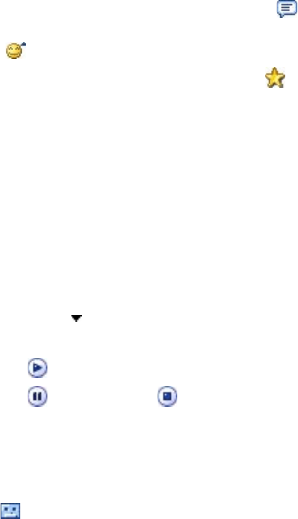
126 Exchanging Messages and Using Outlook
To add text to an MMS message
When entering text into an MMS message, you can do the following:
• Tap inside the text box and enter your own text.
• Choose from common words or phrases. Tap to add a text string
from the My Text list.
• Tap to add an emoticon.
• You can easily include a Web page link. Tap then select a Web page
address from the Internet Favorites list on your device.
Tip To edit or delete a phrase on the My Text list, tap and hold a string, then tap
Edit or Delete from the shortcut menu. To create and add a new phrase to
the list, tap New.
To add an audio clip to an MMS message
You can add audio clips to your MMS message. However, you can add only
one audio clip per slide.
1. Tap Insert audio.
By default, My Documents will be shown. Tap My Music or another
folder that contains audio files. When navigating folders, tap the
Down arrow ( ) to return to the upper folder.
2. Select an audio file. When selected, you can:
• Tap to play the audio clip.
• Tap to pause, or tap to stop playback.
• Tap Select to insert it into your MMS message.
• Tap the Exit icon to quit selection and return to your MMS
message.
• To record a new audio clip and add it to your MMS message, tap
. The Record pop-up window then opens. Tap Record to start
recording, and Stop to end the recording. Tap Play to listen to
the recorded audio clip, then tap Done. The new audio clip is
automatically inserted into your MMS message.

Exchanging Messages and Using Outlook 127
View and reply MMS messages
To view an MMS message
• Use the playback controls , , and .
• Tap Objects to see a list of files included in the message. On the
Message Objects screen, you can do the following:
• To save a file, select it, and tap Menu > Save.
• To save the contents of a text file to the My Text list, tap Menu >
Save into “My Text”.
• To associate a photo to one of your contacts, tap Menu > Assign
to Contact.
To reply to an MMS message
• Tap Menu > Reply to reply to the sender of the message, or tap
Menu > Reply All to reply to all persons listed in To, Cc, and Bcc of the
message.
7.3 Pocket MSN
Pocket MSN delivers the features of Hotmail and MSN Messenger to your
device. With MSN Messenger you can do the following:
• Send and receive instant messages.
• See which contacts are online or offline.
• Subscribe to status updates for selected contacts so you know when
they come online.
• Block contacts from seeing your status or sending you messages.
Before you can use MSN Messenger, your device must be connected to
the Internet. For information about setting up an Internet connection, see
“Connecting to the Internet” in Chapter 6.
Note You must have either a Microsoft .NET Passport or Hotmail account to use
MSN Messenger. If you have a Hotmail.com or MSN.com e-mail address,
you already have a Passport. To get a Passport account, go to http://www.
passport.com. To get a Hotmail account, go to http://www.hotmail.com.
128 Exchanging Messages and Using Outlook
To start MSN Messenger
1. Tap Start > Programs > Pocket MSN.
2. Tap MSN Messenger.
To sign in or out
• To sign in, tap anywhere on the MSN Messenger screen. Enter the e-
mail address and password for your Passport or Hotmail account, and
tap Sign In. Signing in may take several minutes, depending on your
connection speed.
• To sign out, tap Menu > Sign Out. Your status changes to Offline.
To add or delete contacts
• To add a contact, tap Menu > Add a Contact, and follow the
instructions on the screen.
• To delete a contact, tap and hold the contact's name, and tap Delete
Contact.
To send an instant message
1. Tap the contact to whom you want to send a message.
2. Enter your message in the text entry area at the bottom of the screen,
and tap Send.
Tip To quickly add common phrases, tap Menu > My Text and select a phrase in
the list.
7.4 Calendar
Use Calendar to schedule appointments, including meetings and other
events. Your appointments for the day can be displayed on the Today
screen. If you use Outlook on your PC, you can synchronize appointments
between your device and PC. You can also set Calendar to remind you of
appointments with a sound or flashing light, for example.
You can look at your appointments in several different views (Day, Week,
Month, Year, and Agenda). To see detailed appointment information in any
view, tap the appointment.
Exchanging Messages and Using Outlook 129
To schedule an appointment
1. Tap Start > Calendar.
2. Tap Menu > New Appointment.
3. Enter a name for the appointment, and enter information, such as
start and end times.
4. To schedule an all-day event, in the All Day box, tap Yes.
5. When finished, tap OK to return to the calendar.
Notes •
All-day events do not occupy blocks of time in Calendar; instead, they
appear in banners at the top of the calendar.
• To cancel an appointment, tap the appointment and tap Menu > Delete
Appointment.
Tip To have the time entered automatically in Day view, tap the time slot for the
new appointment, and tap Menu > New Appointment.
To send a meeting request
Use Calendar to schedule meetings via e-mail with contacts who use
Outlook or Outlook Mobile.
1. Tap Start > Calendar.
2. Schedule a new appointment, or open an existing one and tap Edit.
3. Tap Attendees.
4. Tap the name of the contact you want to invite.
5. To invite each additional attendee, tap Add and tap the name.
6. Tap OK.
7. The meeting request will be sent to the attendees the next time you
synchronize your device with your PC.
Note When attendees accept your meeting request, the meeting is automatically
added to their schedules. When their response is sent back to you, your
calendar is updated as well.
130 Exchanging Messages and Using Outlook
To set a default reminder for all new appointments
You can have a reminder automatically turned on for all new appointments
you schedule.
1. Tap Start > Calendar.
2. Tap Menu > Options > Appointments tab.
3. Select the Set reminders for new items check box.
4. Set the time when you want the reminder to alert you.
5. Tap OK to return to the calendar.
7.5 Contacts
Contacts is your address book and information storage for the people and
businesses you communicate with. Store phone numbers, e-mail addresses,
home addresses, and any other information that relates to a contact, such
as a birthday or an anniversary date. You can also add a picture or assign a
ring tone to a contact.
From the contact list, you can quickly communicate with people. Tap a
contact in the list for a summary of contact information. From there, you
can call or send a message.
If you use Outlook on your PC, you can synchronize contacts between your
device and PC.
To create a contact on your device
1. Tap Start > Contacts.
2. Tap New and enter the contact information.
3. When finished, tap OK.
Tips •
If someone who is not in your list of contacts calls you, you can create a
contact from Call History by tapping and holding a phone number and
then tapping Save to Contacts from the shortcut menu.
•
To save a phone number that is contained in a message, tap the phone
number, then tap Menu > Save to Contacts.
•
In the list of contact information, you’ll see where you can add a picture
or assign a ring tone to a contact.
Exchanging Messages and Using Outlook 131
To create a contact on your SIM card
1. Tap Start > Programs > SIM Manager. This opens the SIM Manager
program.
2. Tap New and enter a contact name and phone number.
3. Tap Save to save the information on your SIM card.
To change contact information
1. Tap Start > Contacts.
2. Tap the contact.
3. Tap Menu > Edit and enter the changes.
4. When finished, tap OK.
Tip: To change contact information on your SIM card, tap Start > Programs >
SIM Manager, then tap a SIM contact and edit it. After modifying, tap Save.
To work with the contact list
There are several ways to use and customize the contact list. Here are a few
tips:
1. Tap Start > Contacts.
2. In the contact list, do any of the following:
• In Name view, you can search for a contact by entering a name
or number, or by using the alphabetical index. To switch to Name
view, tap Menu > View By > Name.
• To see a summary of information about a contact, tap the contact.
From there you can also make a call or send a message.
• To see a list of available actions for a contact, tap and hold the
contact.
• To see a list of contacts employed by a specific company, tap
Menu > View By > Company, then tap the company name.
To copy SIM contacts to your device
If you have saved contacts on your SIM card, you can copy them into
Contacts on your device.
1. Tap Start > Programs > SIM Manager.
2. Select the desired item, or select all SIM contacts by tapping Menu >
Select All.
3. Tap Menu > Save to Contacts.
132 Exchanging Messages and Using Outlook
To copy contacts to the SIM card
Only one phone number per contact name can be stored on a SIM card.
When you copy a contact that has several phone numbers to your SIM card,
SIM Manager saves each number under a separate name.
To save each number under a different contact name on the SIM card, SIM
Manager appends an indicator at the end of each name. By default, /M, /W
and /H are appended to indicate mobile, work and home phone numbers
respectively. You can edit this indicator first before you start copying
contacts to your SIM card. Indicators of the other types of phone numbers
are left empty for you to define them.
1. Tap Start > Programs > SIM Manager, then tap Menu > Tools >
Options.
2. On the Options screen, select the check boxes of the types of phone
numbers that you want to be added to the SIM card.
3. Under the Mark column, you can change the indicator that will be
appended to the SIM contact names for each phone number type. To
do so, select a phone type, tap Edit, enter your desired indicator, then
tap Save.
4. After modifying, tap OK.
5. Tap Menu > Contacts to SIM.
6. Select the check boxes of the contact’s phone numbers that you want
to copy to your SIM card, then tap Save.
To find a contact on your device
There are several ways to find a contact when your contact list is long.
1. Tap Start > Contacts.
2. If you are not in Name view, tap Menu > View By > Name.
3. Do one of the following:
• Begin entering a name or phone number in the provided text box
until the contact you want is displayed. To show all contacts again,
tap the text box and clear the text, or tap the arrow to the right of
the text box.
• Use the alphabetical index displayed at the top of the contact list.
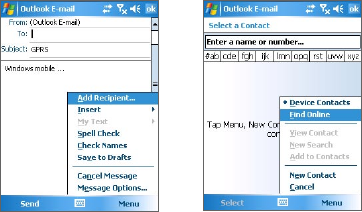
Exchanging Messages and Using Outlook 133
• Filter the list by categories. In the contact list, tap Menu > Filter,
then tap a category you’ve assigned to a contact. To show all
contacts again, select All Contacts.
To find a contact online
In addition to having contacts on your device, you can also access contact
information from your organization’s Global Address List (GAL). GAL is
the address book that contains all user, group, and distribution list e-mail
addresses of your organization, and it is stored on the Exchange Server. By
having direct online access to it from your device, it is quick and easy for
you to plan a meeting and e-mail a meeting request immediately to anyone
in your organization.
Access to the GAL is available if your organization is running Microsoft
Exchange Server 2003 SP2 and you have completed your first
synchronization with the Exchange Server.
1. Synchronize with Exchange Server if you have never done so.
2. Tap Start > Contacts > Menu > View By > Name.
3. Do any of the following:
• In Contacts, tap Menu > Find Online.
• In a new message, tap the To box. Tap Menu > Add Recipient >
Menu > Find Online.
• In a new meeting request using Calendar, tap Attendees and then
tap Menu > Find Online.
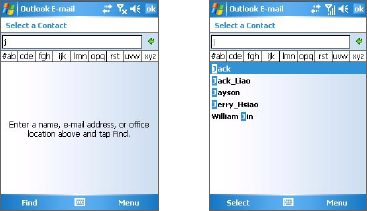
134 Exchanging Messages and Using Outlook
4. Enter the part or full contact name and tap Find. Tap Select to choose
the desired contact(s) from the list.
Notes • Your device must be set up with a data connection.
• You can search on the following information as long as that information is
included in your organization’s GAL: First name, Last name, E-mail name,
Display name, E-mail address, or Office location.
To send contact information via text messaging
1. Tap Start > Contacts, then select a contact.
2. Tap Menu > Send Contact > Text Messages.
3. Select the contact information you want to send, then tap Done.
4. In the new text message, enter the mobile phone number of the
recipient, then tap Send.
Exchanging Messages and Using Outlook 135
7.6 Tasks
Use Tasks to keep track of things you need to do. A task can occur once or
repeatedly (recurring). You can set reminders for your tasks and you can
organize them using categories.
Your tasks are displayed in a task list. Overdue tasks are displayed in red.
To create a task
1. Tap Start > Programs > Tasks.
2. Tap Menu > New Task, enter a subject for the task, and fill in
information, such as start and due dates, priority, and so on.
3. When finished, tap OK.
Tip You can easily create a short, to-do type task. Simply tap the Tap here to add
a new task box, enter a subject, and tap the Enter button on the on-screen
keyboard. If the task entry box is not available, tap Menu > Options and
select the Show Tasks entry bar check box.
To change the priority of a task
Before you can sort tasks by priority, you need to specify a priority level for
each task.
1. Tap Start > Programs > Tasks.
2. Tap the task you want to change the priority for.
3. Tap Edit, and in the Priority box, tap a priority level.
4. Tap OK to return to the task list.
Note All new tasks are assigned a Normal priority by default.
To set a default reminder for all new tasks
You can have a reminder automatically turned on for all new tasks you
create.
1. Tap Start > Programs > Tasks.
2. Tap Menu > Options.
3. Select the Set reminders for new items check box.
4. Tap OK to return to the task list.
Note The new tasks must have due dates set in order for the reminder to take
effect.
136 Exchanging Messages and Using Outlook
To show start and due dates in the task list
1. Tap Start > Programs > Tasks.
2. Tap Menu > Options.
3. Select the Show start and due dates check box.
4. Tap OK.
To locate a task
When your list of tasks is long, you can display a subset of the tasks or sort
the list to quickly find a specific task.
1. Tap Start > Programs > Tasks.
2. In the task list, do one of the following:
• Sort the list. Tap Menu > Sort By, and tap a sort option.
• Filter the list by category. Tap Menu > Filter, and tap the category
you want displayed.
Tip To filter your tasks further, tap Menu > Filter > Active Tasks or Completed
Tasks.
7.7 Notes
Notes helps you to quickly capture thoughts, questions, reminders, to-do
lists, and meeting notes. You can create handwritten and typed notes,
record voice notes, convert handwritten notes to text for easy readability,
and send notes to others.
Enter information in Notes
There are several ways to enter information in a note. You can enter typed
text by using the on-screen keyboard or handwriting recognition software.
You can use the stylus to write or draw directly on the screen.
To set the default input mode for Notes
If you frequently add drawings to your notes, you may find it helpful to set
Writing as the default input mode. If you prefer typed text, select Typing.
1. Tap Start > Programs > Notes.
2. In the note list, tap Menu > Options.
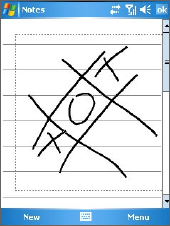
Exchanging Messages and Using Outlook 137
3. In the Default mode box, tap one of the following:
• Writing if you want to draw or enter handwritten text in a note.
• Typing if you want to create a typed note.
4. Tap OK.
To create a note
1. Tap Start > Programs > Notes. In the note list, tap New.
2. Tap the Input Selector arrow next to the Input Method icon on the
menu bar, tap the input method you want, and enter your text.
3. If the Input Selector arrow is not displayed, tap the Input Method
icon.
4. When finished, tap OK to return to the note list.
Notes •
To select handwritten text, tap and hold next to the writing. As soon as
dots appear, and before they form a complete circle, quickly drag across
the writing.
• If a letter crosses three ruled lines, it is treated as a drawing rather than
text.
To draw in a note
1. Tap Start > Programs > Notes.
2. In the note list, tap New.
3. To draw on the screen, use the stylus
like a pen.
4. A selection box appears around your
drawing.
5. When finished, tap OK to return to the
note list.
Note To select a drawing (for example, to copy or delete it), tap and hold the
drawing briefly. When you lift the stylus, the drawing is selected.

138 Exchanging Messages and Using Outlook
Record a voice note
You can create a stand-alone recording (voice note) or you can add a
recording to a note.
To create a voice note
1. Tap Start > Programs > Notes.
2. Do one of the following:
• To create a stand-alone recording, record from the note list.
• To add a recording to a note, create or open a note.
3. On the Recording toolbar, tap the Record icon ( ) to begin
recording. (If you do not see the Recording toolbar, tap Menu > View
Recording Toolbar.)
4. Hold your device’s microphone near your mouth or other source of
sound.
5. Tap the Stop icon ( ) when finished recording.
Notes •
If you are adding a recording to a note, tap OK to return to the note list
when finished.
• If you are recording in an open note, an icon will appear in the note.
• If you are creating a stand-alone recording, the recording will appear in
the note list.
Tip To quickly create a recording, press and hold the VOICE COMMAND button,
then you can begin to record after a beep sound. Release the button when
you are finished.
To change recording formats
1. Tap Start > Settings > Personal tab > Input.
2. Tap the Options tab, and select the desired format you want in the
Voice recording format list.
3. Tap OK.
Note
You can also change recording formats from within Notes. In the note list, tap
Menu > Options > Global Input Options link (at the bottom of the page),
then tap the Options tab.
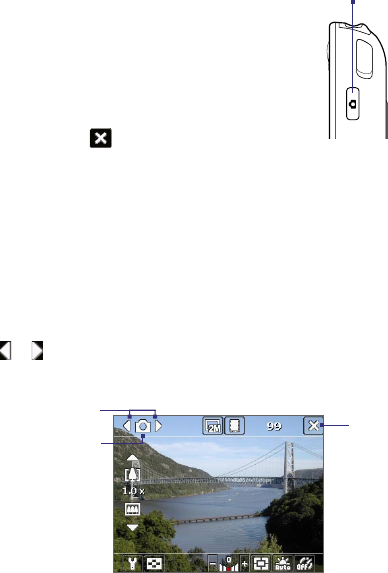
140 Experiencing Multimedia
8.1 Using Camera
Taking photos and recording video clips along with audio are easy with
your device’s built-in camera.
To open the Camera screen
• Press the CAMERA button on your device; or
• Tap Start > Programs > Camera; or
•
Tap Start > Programs > Pictures & Videos
> Camera icon.
To exit the Camera
• Tap the Exit icon ( ) on the Camera screen.
CAMERA button
Capture modes
The camera on your device allows you to capture pictures and video clips
by using various built-in modes with flexibility. The Camera is set to the
Photo capture mode by default. The upper left corner of the screen displays
the active capture mode. To switch to other capture modes, do any of the
following:
• Tap or on the Camera screen.
• Press NAVIGATION left or right.
Current capture mode.
Exit icon
Select the capture mode.

Experiencing Multimedia 141
The available capture modes of the camera are as follows:
• Photo: Captures standard still images.
• Video: Captures video clips, with or without accompanying audio.
• MMS Video: Captures video clips suitable for sending via MMS.
• Contacts Picture: Captures a still image and gives you the option to
immediately assign it as a Photo ID for a contact.
• Picture Theme: Captures still images and places them within frames.
• Sports: Captures a sequence of still images (3, 5, 7, or 10)
automatically.
• Burst: Captures a sequence of still images (maximum 30) as long
as the CAMERA button on the device or the ENTER button on the
NAVIGATION Control is kept pressed.
File formats supported
Using the above capture modes, the camera in your device captures files in
the following formats:
Capture type Format
Still image JPEG
Video MPEG-4 (.mp4), Motion-JPEG (.avi), H.263 (.3gp)
MMS Video H.263 baseline (.3gp), MPEG-4 (.mp4)
Sports / Burst
JPEG
Camera controls
Use the following device buttons and on-screen controls to take photos or
video clips and to modify settings.
The CAMERA and ENTER buttons
Press the CAMERA button on the device to open the Camera screen. If
already on the Camera screen, you can use either the CAMERA button or the
ENTER button as the shutter release.
• Press the CAMERA button or the ENTER button to take a photo or
contacts picture.
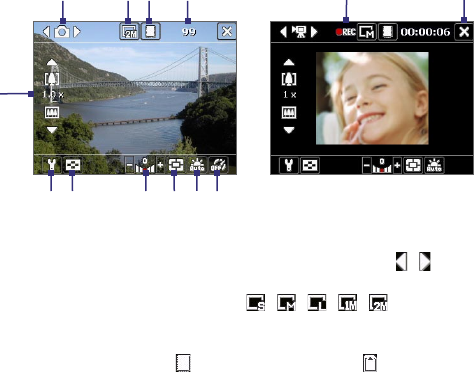
142 Experiencing Multimedia
• Press the CAMERA button or the ENTER button to start recording
video; press it again to stop recording.
• Press the CAMERA button or the ENTER button each time when taking
photos for a picture theme.
• To take consecutive shots in Sports mode, press the CAMERA button
or the ENTER button shortly, then move your device to follow the
movement of your subject.
• Press and hold the CAMERA button or the ENTER button when taking
consecutive shots in Burst mode.
The NAVIGATION Control
• Press NAVIGATION up or down to increase or decrease the zoom level.
• Press NAVIGATION left or right to go to the previous or next
sequential capture mode.
On-screen controls and indicators
5
12
6 7 8 9 10 11
1 2 3 4 13
Photo mode
Video mode
1 Mode Switching control. Tapping the left/right arrow ( / ) on the
screen allows you to switch the capture mode.
2 Resolution. The resolution icon ( / / / / ) indicates the
current resolution. Tap to toggle among the different resolutions.
3 Storage. Tap to toggle between saving captured photos or video clips
on the Main Memory ( ) or on the Storage Card ( ).
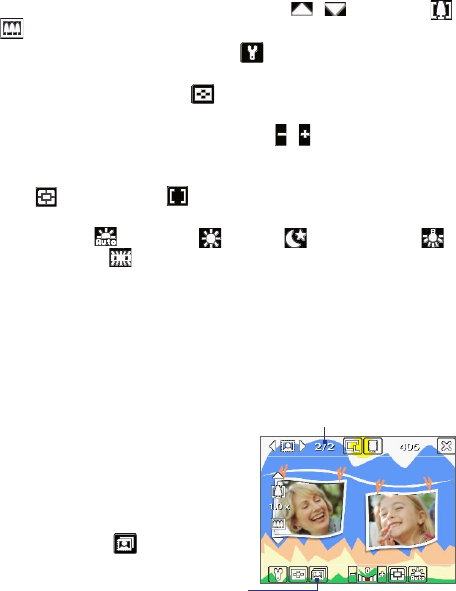
Experiencing Multimedia 143
4 Remaining information indicator. In Photo, Contacts Picture, Picture
Theme, Sports, and Burst modes, this shows the remaining, available
shots of pictures based on current settings. In Video and MMS Video
modes, this shows the remaining duration that can be recorded. While
recording video, this shows the recorded duration.
5 Zoom control. Tapping the up/down arrow ( / ) or tapping
/ on the screen allows you to zoom in or zoom out.
6 Camera Settings. Tap the Tool icon ( ) to open the Camera
Settings screen.
7 Viewer. Tap the Viewer icon ( ) to open the Pictures & Videos
screen.
8 Brightness. Tapping the minus/plus icon ( / ) decreases or
increases the brightness level.
9 Metering Mode. Tap to toggle the metering mode between Center
Area ( ) and Average ( ).
10 White Balance. Tap to toggle among the different white balance
settings: Auto ( ), Daylight ( ), Night ( ), Incandescent ( ),
and Fluorescent ( ).
11 Self-timer. Tap to set the Self-timer to 2 seconds, 10 seconds, or off
when in the Photo or Contacts Picture mode. When you press the
ENTER button or the CAMERA button to capture a still image, it starts
to count down, and then captures a still image after the assigned time
(2 seconds or 10 seconds).
12 Recording indicator. This shows a red, blinking indicator while video
recording is in progress.
13 Exit. Tap to exit the Camera program.
14
Progress indicator. In Picture
Theme, Sports, and Burst modes,
this shows the total number of
consecutive shots.
15
Template Selector. In Picture
Theme mode, tap to toggle
among the different templates.
Picture Theme mode
14
15

144 Experiencing Multimedia
Still image capture modes
While using Still Image capture modes, such as Photo, Contacts Picture,
Picture Theme, Sports, and Burst, you can capture still image(s) by
pressing the CAMERA button on the device or the ENTER button on the
NAVIGATION Control. Still images will be saved in JPEG format.
While capturing an image in the Picture Theme capture mode, you can
select a preset template. To view and select from different templates, tap
on the Camera screen. Depending on the chosen template, one or more
photos may need to be taken for the template.
Video capture mode
While using the Video capture mode, you can press the CAMERA button or
the ENTER button to start recording a video clip (with audio if desired). To
stop recording, press the CAMERA button or the ENTER button again. Your
device displays the first frame of the captured video clip by default on the
Review screen.
Before you capture a video clip, you can specify the desired length of
recording in terms of time or file size on the Camera Settings screen.
Video clips can be saved in MPEG-4 (.mp4), H.263 (.3gp), or Motion-JPEG
(.avi) format.
MMS Video capture mode
The MMS Video capture mode makes it convenient for you to capture a
video file and then send it via MMS. Press the ENTER button or the CAMERA
button to start recording a video clip (with audio if desired). To stop
recording, press the ENTER button or the CAMERA button again.
The recording length of MMS video is fixed. Recording automatically
stops when the preset length is reached. However, you can manually stop
recording the video anytime. The time indicator at the upper right side of
the Camera screen indicates the time limit.
You can specify the capture format to be either H.263 or MPEG-4 on the
Camera Settings screen; however, the ideal format for MMS is H.263 (3GPP).
After you capture the video file, tap on the Review screen to send the
file through MMS.
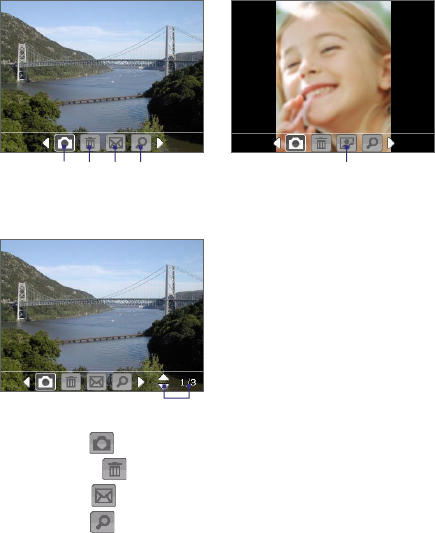
Experiencing Multimedia 145
The Review screen
After taking a still image or recording a video clip, you can view the image
or video clip on the Review screen. In addition, you can tap the icons at the
bottom of the Review screen to delete a captured image or video, send it
via e-mail or MMS, and more.
Review screen icons
5
Contacts Picture modePhoto, Video, MMS Video
and Picture Theme modes
1 2 3 4
Sports and Burst modes 6
1 Back. Tap to go back to the Camera screen.
2 Delete. Tap to remove the captured image or video.
3 Send. Tap to send via e-mail or MMS.
4 View. Tap to view the image in the Pictures & Videos program, or
play the captured video in Windows Media Player Mobile.

146 Experiencing Multimedia
5 Assign to Contacts. Tap to associate the photo to a selected
contact.
6 Browse. After you have taken photos in Sports or Burst mode,
the total number of consecutive shots is shown in the lower right
corner of the Review screen. Tap the up/down arrow ( ) or press
NAVIGATION up/down to browse through the sequence of photos.
To change the display duration of the Review screen
1. Tap to open the Camera Settings screen.
2. On the Camera Settings screen, tap . The Advanced menu then
appears.
3. Tap Review Duration, then tap the desired time length for displaying
captures on the Review screen.
Zooming
While capturing a still image or a video clip by using the camera, you can
zoom in to make the object in focus move closer, and you can zoom out to
make the object move farther away. In all capture modes, use NAVIGATION
on your device, or tap the triangular Up arrow above the Zoom Ratio
indicator, to zoom in your subject. When the zooming limit is reached, you
will hear a beep. To zoom out, press NAVIGATION down, or tap the Down
arrow. The camera zoom range for a picture or a video clip depends on the
capture mode and capture size.
Zoom range
The camera zoom range for a picture or a video clip depends on the capture
mode and capture size. The following table is a summary.
Capture mode Capture size setting Zoom range
Photo
2M (1600 x 1200) No zooming available
1M (1280 x 960) 1.0x to 2.0x
Large (640 x 480) 1.0x to 2.0x
Medium (320 x 240) 1.0x to 4.0x
Small (160 x 120) 1.0x to 10.0x

Experiencing Multimedia 147
Capture mode Capture size setting Zoom range
Video Medium (176 x 144) 1x and 2x
Small (128 x 96) 1x and 2x
MMS Video Medium (176 x 144) 1x and 2x
Small (128 x 96) 1x and 2x
Contacts
Picture
Large (480 x 640) 1.0x to 2.0x
Medium (240 x 320) 1.0x to 4.0x
Small (120 x 160) 1.0x to 4.0x
Picture Theme Determined by the current
template
Depends on the size of the
template currently loaded
Sports
Large (640 x 480) 1x and 2x
Medium (320 x 240) 1x, 2x and 4x
Small (160 x 120) 1x, 2x, 4x and 8x
Burst
Large (640 x 480) 1x and 2x
Medium (320 x 240) 1x, 2x and 4x
Small (160 x 120) 1x, 2x, 4x and 8x
Note The capture sizes available for certain capture formats also vary from
one capture mode to another. The zoom range has been calculated
based on the following ratio:
• 1.0x = normal size (no zooming)
• 2.0x = double enlargement
• 4.0x = four times enlargement
• 8.0x = eight times enlargement
• 10.0x = ten times enlargement
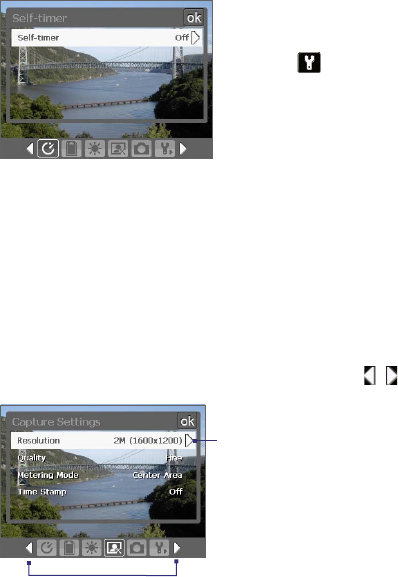
148 Experiencing Multimedia
The Camera Settings screen
Camera Settings screen in Photo mode
While capturing a still image or video clip
using any capture modes, tap the Tool
icon ( ) to access the Camera Settings
screen. The Camera Settings screen
allows you to configure the capture
settings.
When you tap the icons at the bottom of the Camera Settings screen,
different menus will appear. Some menus and options may be available
only in certain capture modes.
To navigate the Camera Settings screen
You can either tap on-screen or press the NAVIGATION Control buttons to
navigate the Camera Settings screen.
1
2
1Tap an icon to directly display the
desired menu. You can also tap the
left/right arrow ( / ) to navigate the
icon bar at the bottom until you reach
the desired menu.
Alternatively, when using the Navigation
Control, press NAVIGATION up/down
to highlight the icon bar at the bottom
of the screen. Then, press NAVIGATION
left/right to navigate to the icon of the
desired menu. Once the desired menu is
displayed, press NAVIGATION up/down
to highlight the menu option.
2Tap an option on the menu to open a
submenu of available settings.
Alternatively, press NAVIGATION
up/down to select an option, then press
NAVIGATION right to open its submenu.
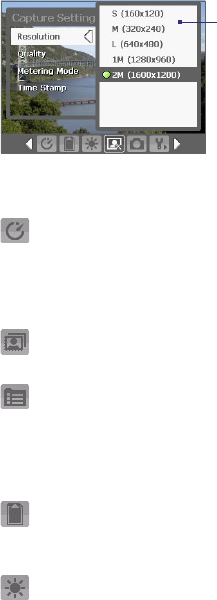
Experiencing Multimedia 149
33Tap to select a setting and close
the submenu.
Alternatively, press NAVIGATION
up/down to select a setting, then
press NAVIGATION left to close
the submenu.
For more information about the different menus and settings, see the
succeeding sections.
Self-timer menu
• Self-timer. Select the Self-timer option for capturing images: Off,
2 seconds, or 10 seconds. Selecting 2 seconds or 10 seconds
delays the capturing by the specified time after you press the
CAMERA button or the ENTER button.
Template menu
• Template. Select a template (in Picture Theme mode only).
Sports/Burst Settings menu
• Capture Speed. This determines the interval between shots. Fast
captures consecutive shots at the shortest interval.
• Snapshots. Select the number of consecutive shots to capture (in
Sports mode only).
Storage menu
• Storage. Select where you want to save your files. You can either
save the files to the main memory or to a storage card.
Ambience menu
• White Balance. Select a white balance setting type, such as
Fluorescent, Night, etc. to suit your lighting environment.
• Effect. Choose a special effect, such as Grayscale, Sepia, etc., to
apply to your photos or video clips.
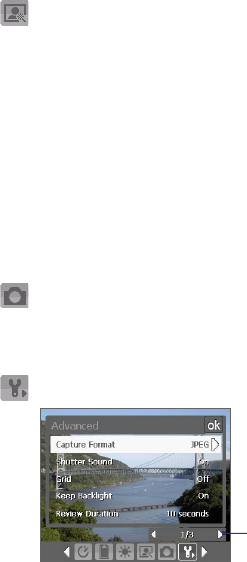
150 Experiencing Multimedia
Capture Settings menu
• Resolution. Select the desired image or video size.
• Quality. Select the JPEG image quality level for all captured still
images. You can choose from Basic, Normal, Fine, and Super
Fine.
• Metering Mode. Select a metering mode to allow the camera to
measure the amount of light in the center and around the image
and calculate the best-fit exposure value before capturing. Choose
either Center Area to measure light using the center area of the
image or Average to measure light using the area all around the
image.
• Time Stamp (Photo, Sports and Burst modes). Choose whether or
not to include the shooting date and time on captured photos.
Capture Mode menu
• Mode. Switch between different capture modes, such as Photo,
Video, Contacts Picture, and more. For more information about
these modes, see “Capture modes” earlier in this chapter.
Advanced menu
Tap the left/right icon in this bar to switch
between the menu pages in the Advanced
menu.
Alternatively, when using the NAVIGATION
Control buttons, press NAVIGATION
up/down to highlight this bar. Then, press
NAVIGATION left/right to switch between
the menu pages.
• Capture Format. Select the desired file format.
• Shutter Sound. Choose whether or not you want the camera to make
a shutter sound when you press the ENTER button or the CAMERA
button to take photos or record video clips.
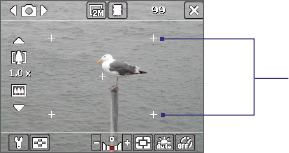
Experiencing Multimedia 151
• Grid (Photo mode only). Choose whether or not to show a grid on
the Camera screen. Showing a grid helps you frame and center your
subject more easily and accurately.
Grid
• Keep Backlight. Choose whether to turn the backlight on or off while
using the camera. This overrides your device backlight settings while
you are using the camera.
• Review Duration. Set a time length for displaying the captured
image/video on the Review screen before automatically saving it and
returning to the live Camera screen. Select No Limit if you do not
want to impose a time limit. Select No Review to immediately return
to the live Camera screen after capturing.
• Flicker Adjustment. When taking indoor shots, flicker on the camera
screen may be caused by inconsistencies between the vertical scan
rate of the camera display and the flicker frequency of fluorescent
lighting. To reduce flicker, you can change the flicker adjustment
setting to Auto or to the proper frequency (50Hz or 60Hz) of the
country where your device is being used.
• Record with Audio. Select On to record audio with the captured
video clips. This is selected by default. If you select Off and then
capture a video clip, it will have no audio.
• Prefix. Specify how to name captured images and video clips. When
Default is selected, the file name of each new captured file is set to
“IMAGE” or “VIDEO” followed by a sequential number, for example:
IMAGE_001.jpg. You may also choose to name files using either the
current Date or Date & Time as the prefix.
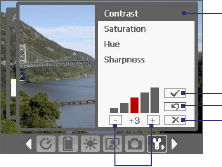
152 Experiencing Multimedia
• Counter. By default, the newly captured image or video files are
named with a prefix and some sequential numbers, such as 001, 002,
and so on. To reset the numbering to “001” for your captured files, tap
Reset.
• Recording Limit. Specify the maximum time or file size for recording.
• Template Folder (in Picture Theme mode only). By default, templates
are stored in the \My Documents\Templates folder on the device’s
Main Memory. If you transferred some templates to a storage card
(via File Explorer), set this option to Main + Card to specify that
templates are located in both the main memory and the storage card.
• Adjust. This option allows you to adjust the camera display
properties, such as Contrast, Saturation, Hue, and Sharpness.
2
3
4
1
5
1In the submenu, tap one of the properties to adjust.
Alternatively, press NAVIGATION up/down to select a property.
2To increase/decrease the value, tap the plus/minus icon or press
NAVIGATION left/right. The live Camera screen on the background
immediately displays the effect of changes.
3Tap to save the settings and close the submenu.
4Tap to reset all properties to their default.
5Tap to close the submenu without applying and saving the changes.

Experiencing Multimedia 153
8.2 Using Pictures & Videos
The Pictures & Videos program collects, organizes, and sorts images and
video clips in the following formats on your device.
File Type File Extensions
Image *.bmp, *.jpg, *.gif
GIF animation *.gif
Video *.avi, *.wmv, *.mp4, *.3gp
You can view the pictures as a slide show, beam them, send them via e-mail,
edit them, or set them as the background on the Today screen.
To copy pictures, GIF animation files, and video clips to your device
You can copy pictures, GIF animation files, and video files from your PC and
view them on your device.
• Copy the pictures, GIF animation files, and video files from your PC or
a storage card to the My Pictures folder on your device. (You can also
copy video files to the My Videos folder.)
For more information about copying files from your PC to your device, see
ActiveSync Help on your PC.
Note You can also copy pictures, GIF animation files, and video files from your PC
to your device using a storage card. Insert the storage card into the storage
card slot on your device, then copy the files from your PC to the folder you
created on the storage card.
To view pictures
1. Tap Start > Programs > Pictures & Videos. The images in the My
Pictures folder appear as thumbnails by default.
2. Select a picture and tap View. If you cannot find a picture in the
default My Pictures folder, go to another folder by tapping the Down
arrow ( ).
To play GIF animation files
1. Tap Start > Programs > Pictures & Videos.
2. Select a GIF animation file (marked with a icon)and tap View. The
GIF Animation program then opens and plays the animation.
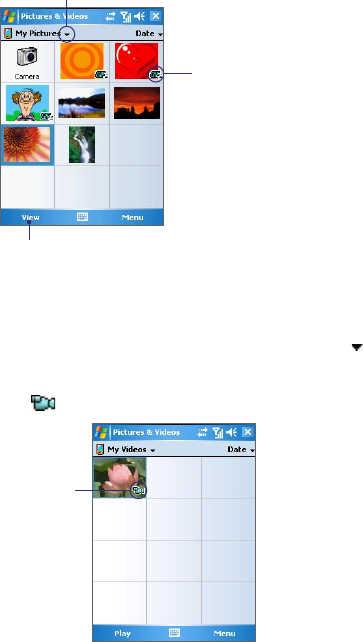
154 Experiencing Multimedia
The down arrow
Tap to view the selected image.
GIF animation icon
To play videos with audio
1. Tap Start > Programs > Pictures & Videos. By default, the contents
of the My Pictures folder will be shown.
2. To find the video clips that you captured, tap the down arrow ( )
next to the My Pictures folder and tap My Documents > My Videos.
Video clips are displayed as thumbnails by default, which appear with
a media icon ( ).
The media icon
3. Tap to select a video and play it in Windows Media Player Mobile.
Experiencing Multimedia 155
To view slide shows
You can view your pictures as a slide show on your device. Pictures are
shown in full-screen view with 5-second intervals between slides.
1. Tap Start > Programs > Pictures & Videos.
2. Tap Menu > Play Slide Show.
Note You can specify how pictures are scaled to optimize their display in a slide
show. Tap Menu > Options, then tap Portrait pictures or Landscape
pictures on the Slide Show tab.
Tap anywhere on the screen to display the Slide Show toolbar, which you
can use to stop or pause the slide show, rotate the view, and more.
To sort pictures and video clips
If you store a large number of pictures or video clips on your device, you
may find it helpful to sort them to quickly find a specific picture or clip. You
can sort by name, date, and size.
1. Tap Start > Programs > Pictures & Videos.
2. Tap the sort list (labeled Date by default), and select the item you
want to sort by (Name, Date, or Size).
To delete a picture or video clip
Do any of the following to remove a picture or a video clip:
• Select a picture or video clip on the Pictures & Videos screen, and tap
Menu > Delete.
• Tap and hold the thumbnail of the picture you want to delete, then
tap Delete.
Tap Yes to confirm the deletion.
To edit a picture
You can rotate, crop, and adjust the brightness and color contrast of your
pictures.
1. Tap Start > Programs > Pictures & Videos.
2. Tap the picture you want to edit.
3. Tap Menu > Edit, and do any of the following:
• To rotate a picture 90 degrees clockwise, tap Rotate.
156 Experiencing Multimedia
• To crop a picture, tap Menu > Crop. Next, tap and drag to select
the area to crop. Tap inside the box to crop, or tap outside the box
to cancel cropping.
• To adjust the brightness and contrast levels of a picture, tap Menu
> Auto Correct.
Note To undo an edit, tap Menu > Undo. To cancel all unsaved edits you made to
the picture, tap Revert to Saved.
To set a picture as the Today screen background
You can use a picture as the background on the Today screen.
1. Tap Start > Programs > Pictures & Videos.
2. Select the picture you want to set as the background.
3. Tap Menu > Set as Today Background.
4. In Transparency level, select a higher percentage for a more
transparent picture, or a lower percentage for a more opaque picture.
5. Tap OK.
To send pictures and video clips via e-mail
You can send pictures and video clips to other devices via e-mail.
1. First, set up Messaging to send and receive messages.
2. From the program, select the item you want to send.
3. Tap Menu > Send, and select one account (such as Outlook
E-mail or MMS) to send the attached item.
4. A new message is created with the item attached.
5. Enter the recipient name and subject, and tap Send. The message will
be sent the next time you synchronize your device.
Note Pictures and video clips are saved automatically before they are sent.
To assign pictures to contacts
You can assign a picture to a contact so that you can easily identify the
contact at any point of time.
1. Tap Start > Programs > Pictures & Videos.
2. Select the picture you want to assign to a contact.

Experiencing Multimedia 157
3. Tap Menu > Save to Contact.
4. Tap the contact, or navigate and tap Select to choose the contact
from your Contacts list.
To customize more image settings
1. Tap Start > Programs > Pictures & Videos.
2. Select the picture for which you want to configure further settings.
3. Tap Menu > Options. The Options screen appears, allowing you to:
• Resize a picture so that it can be sent faster through e-mail.
• Set the direction of rotation for the Rotate function.
• Configure the view settings during slide shows and activate
screensaver options.
8.3 Using Windows Media Player Mobile
You can use Microsoft Windows Media Player 10 Mobile for Pocket PC to
play digital audio and video files that are stored on your device or on a
network, such as on a Web site.
Using Windows Media Player Mobile, you can play both audio and video
files. These are the following file formats that are supported by this version
of Windows Media Player Mobile.
Video File Formats Supported File Extensions
• Windows Media Video
• MPEG4 Simple Profile
• H.263
• Motion JPEG
• 3GPP2
.wmv, .asf
.mp4
.3gp
.avi
.3g2
Audio File Formats Supported Video File Formats Supported
• Windows Media Audio
• MP3
• MIDI
• AMR Narrow Band
• AMR Wide Band
• AAC
• 3GPP2
.wma
.mp3
.mid, .midi, .rmi
.amr
.awb
.m4a
.gcp
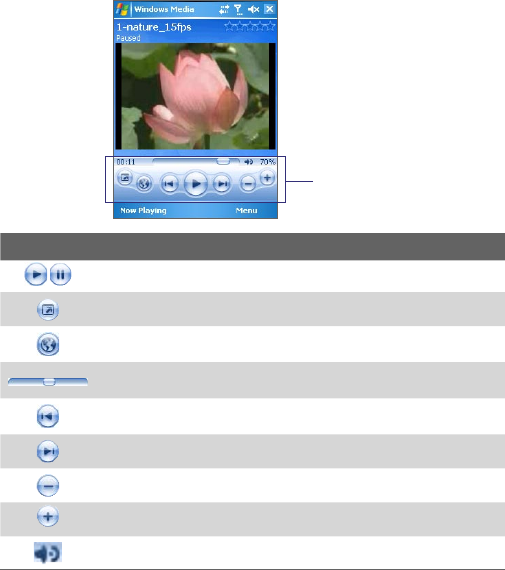
158 Experiencing Multimedia
About the controls
The following are available controls on the Windows Media Player Mobile.
Controls on Windows
Media Player Mobile
This control Does this
Play/Pause a file.
Display the video in full screen.
Display a Web site where you can find music and videos to play.
Adjust the playback progress of a selected file.
Skip to the beginning of the current file or to the previous file.
Skip to the next file.
Decrease the volume level.
Increase the volume level.
Turn the sound on or off.
Experiencing Multimedia 159
About the screens and menus
Windows Media Player Mobile has three primary screens:
• Playback screen. The default screen that displays the playback
controls (such as Play, Pause, Next, Previous, and Volume) and the
video window. You can change the appearance of this screen by
choosing a different skin.
• Now Playing screen. The screen that displays the Now Playing
playlist. This special playlist indicates the current file being played and
any files that are “queued up” to play next.
• Library screen. The screen that lets you quickly find your audio files,
video files, and playlists. It contains categories, such as My Music, My
Videos, My TV, and My Playlists.
At the bottom of each screen, you can open a Menu. The commands on
this menu vary, depending upon which screen you are viewing. For more
information about the commands in these menus, see Help on your device.
About licenses and protected files
Some content (such as digital media files downloaded from the Internet,
CD tracks, and videos) have associated licenses that protect them from
being unlawfully distributed or shared. Licenses are created and managed
by using digital rights management (DRM), which is the technology for
securing content and managing its access rights. Some licenses may
prevent you from playing files that have been copied to your device. Files
that have licenses associated with them are called “protected files.”
If you want to copy a protected file from your PC to your device, use the
desktop Player to synchronize the file to your device (instead of dragging
the file from a folder on your PC to a folder on your device, for example).
This will ensure that the license is copied along with the protected file. For
more information about synchronizing files to your device and other mobile
devices, see desktop Player Help.
Note You can view the protection status for a file by checking its file properties
(tapping Menu > Properties).
160 Experiencing Multimedia
Copy media files to your device
Use the latest version of the desktop Player (Windows Media Player 10 or
later) to synchronize digital media files to your device (instead of dragging a
file from a folder on your PC to a folder on your device, for example). Using
the desktop Player ensures that licenses are copied with protected files.
Always synchronize the files to a storage card that is inserted into your
device. Do not synchronize to a storage card that is inserted into a storage
card reader. In addition, do not synchronize to the internal storage location
(RAM) in your device.
To synchronize content to your device automatically
1. Power off your device. Insert a 32MB or larger storage card into your
device, and turn the power back on.
2. On your PC, start Windows Media Player.
3. Connect your device to your PC.
4. If you have not set up synchronization between your device and PC,
the Device Setup Wizard opens on your PC.
5. In the wizard, click Automatic, select the Customize the playlists
that will be synchronized check box, and then select the playlists
that you want to synchronize.
6. Click Finish.
7. The files begin synchronizing to your device. The next time you
connect your device to your PC while the desktop version of Windows
Media Player is running, synchronization will start automatically.
To synchronize and copy content manually to your device
1. If you have not set up synchronization between your device and
PC, follow steps 1 to 6 in “To synchronize content to your device
automatically”, except that you should click Manual synchronization.
2. To choose files to synchronize and copy to your device, do the
following:
• Click the Library tab.
• In the rightmost pane, click the drop-down list and select Sync
List.
• In the Playlist which is the leftmost pane, select a desired playlist.
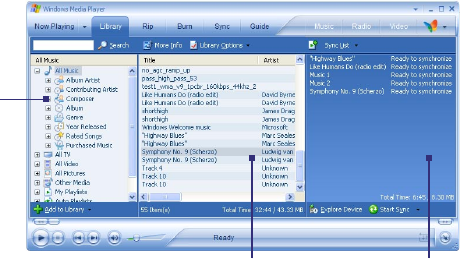
Experiencing Multimedia 161
• In the File List which is the middle pane, multi-select desired files
then drag them to the Sync List.
• Click the Start Sync button found at the bottom of the Sync List.
Playlist
File List Sync List
Note Audio files copy faster if the desktop Player is configured to automatically set
the quality level for audio files copied to your device. For more information,
see desktop Player Help on the PC.
Play media
To play items on your device
Use the library on Windows Media Player Mobile to find and play songs,
videos, and playlists that are stored on your device or removable storage
card.
1. If you are not on the Library screen, tap Menu > Library.
2. On the Library screen, tap the Library arrow (near the top of the
screen), then tap the media storage that you want use, for example,
Storage Card.
3. In most cases, Windows Media Player Mobile automatically updates
the library. However, you can manually update the library to ensure
162 Experiencing Multimedia
that it contains new files that you recently copied to your device or
storage card. Tap Menu > Update Library to manually update the
library list.
4. Select a category (for example, My Music or My Playlists).
5. Tap and hold the item that you want to play (such as a song, album, or
artist name), then tap Play.
Note To play a file that is stored on your device but is not in a library, on the Library
screen, tap Menu > Open File. Tap and hold the item that you want to play
(such as a file or a folder), then tap Play.
To play an item on a network
Use the Open URL command to play a song or video that is stored on the
Internet or on a network server.
1. If you are not on the Library screen, tap Menu > Library.
2. Tap Menu > Open URL.
3. Do one of the following:
• In the URL box, enter a network address.
• In the History box, tap a URL that you have previously used.
Note To play an item on a network, you must be connected to a network. For more
information about creating a remote connection between your device and a
network, see Connections Help on your device.
Use playlists
A playlist is a list of digital media files that play in a specified order. By using
playlists, you can group audio and video files together for convenient
playback.
In the desktop Player, you can create a playlist of media files and
synchronize the desktop Player with your device. For more information
about synchronizing media, see “Copy media files to your device” earlier in
this chapter.
In Windows Media Player Mobile on your device, your playlists are available
in the Library under the My Playlists category. There is also a temporary
playlist, called Now Playing, which lists the currently playing file, as well
as any files that have been queued up to play next. You can create a new

Experiencing Multimedia 163
playlist on your device by saving the current Now Playing playlist and by
giving it a new name.
To save a new playlist
1. If you are not on the Library screen, tap Menu > Library.
2. Tap to select a category (for example, My Music or My Playlists).
3. Select a media file that you want, then tap Menu > Queue Up. This
adds the file to the Now Playing list.
Repeat this step until you have added all desired media files to the
Now Playing list.
Note You cannot select multiple files simultaneously.
4. After adding the media files, tap Menu > Now Playing.
5. On the Now Playing screen, tap Menu > Save Playlist.
6. Enter the playlist name then tap Done.
7. To play back the playlist you created, tap My Playlists in the Library,
select your playlist, then tap Play.
Troubleshooting
If you encounter a problem while using the Windows Media Player Mobile, a
number of resources are available to help you troubleshoot the issue.
For more information, see the Troubleshooting Windows Media Player
Mobile page at the Microsoft Web site (http://www.microsoft.com/
windows/windowsmedia/player/windowsmobile/troubleshooting.aspx).
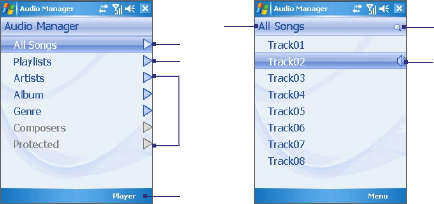
164 Experiencing Multimedia
8.4 Using Audio Manager
Audio Manager is a music browser and player in one. It gives you access
to all the music files on your device, and allows you to easily browse for the
music that you want to play by organizing music into categories, such as
title, artist, album, etc. You can also create playlists of your favorite songs
and use the integrated Music Player to play them back.
To launch Audio Manager
• Tap Start > Programs > Audio Manager.
Notes • Audio Manager searches for all music files stored on your device and
storage card that have the following audio formats: MP3, WMA, AAC, and
AAC+.
•
Audio Manager will search for music files in the following locations:
On the device: \My Document (including all subfolders)
\Music (including all subfolders; when there are music files
synchronized between the device and PC)
On the storage card: \Storage Card (including all subfolders)
•
Music files are categorized under Artists, Album, Genre, etc. if such
metadata are found in the files.
Library
On the Audio Manager’s Library screen, an arrow that appears in an item
indicates that there is a submenu available. Tap the item name to open the
submenu. Alternatively, you can use the NAVIGATION Control to select the
item name first then press the ENTER button to open the submenu.
Library: All Songs screen
1
2
3
4
56
7
Library: Main screen
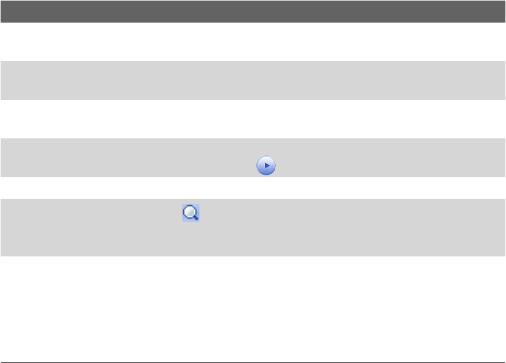
Experiencing Multimedia 165
No. Description
1Opens the All Songs submenu where you can browse music files by file
name or song title.
2Opens the Playlists submenu where you can create playlists and play them
back.
3Opens a submenu where you can browse music files by the selected
category.
4Switches to the Music Player screen. Music Player does not automatically
start playback. You need to tap the icon.
5Shows the current submenu name. Tap to return to the upper-level menu.
6Shows a Search icon ( ) when the music database in Audio Manager is
being updated. This occurs when music files have been added, renamed, or
removed on your device or storage card.
7Shows the song titles or file names of music files when you are in the All
Songs submenu. Tap or use the NAVIGATION Control to select a music file to
play it in the Music Player.
Shows more submenus when you are in one of the category screens,
such as Artists, Album, etc. Tap or use the NAVIGATION Control to open a
submenu.
When you tap a category on the Library’s Main screen, you will see more
submenus which may have deeper levels of menus. For example, when you
tap Artists, another level of submenus will be listed showing artist names.
When you tap an artist name, more submenus showing album names will
be displayed. Just keep opening the submenus until you reach the level
where song titles can be selected for playback.
Music files that are protected by Digital Rights Management (DRM) will be
listed under the Protected category. A lock icon shown before song titles
indicates that the music files are protected. Select a file then tap Info if you
want to view file information. A cross-marked lock icon shown before song
titles indicates that the rights for the music files have expired, and you will
not be able to play them. Tap Delete if you want to delete these files.
Note Audio Manager keeps track of the last submenu that you accessed. When
you exit Audio Manager and open it again, it will display the last submenu
that you were in. Keep tapping the submenu name at the top of the screen
until you reach the Library’s Main screen.
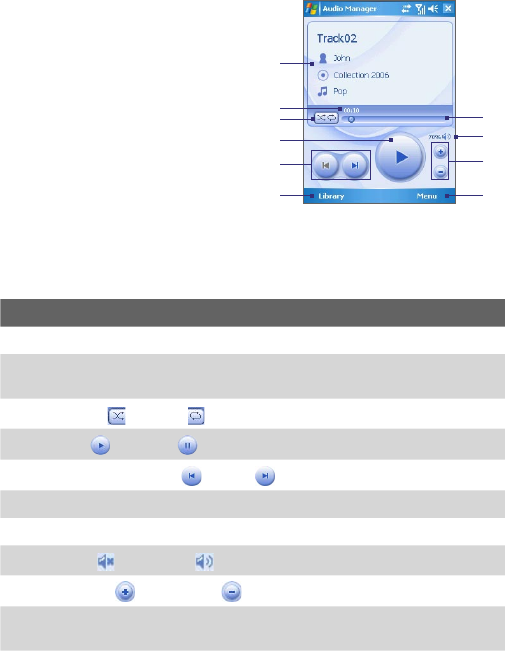
166 Experiencing Multimedia
Music Player
Music Player is integrated within
Audio Manager, and it lets you play
back music files. After selecting a
song in the Library, Music Player
opens and automatically plays it. Use
the available buttons to control the
playback.
1
3
4
5
6
7
8
9
10
2
Note If the last screen you were in was the Music Player when you closed Audio
Manager, next time you launch Audio Manager, it will open Music Player
directly. To switch back to the Library, tap Library.
No. Description
1Shows information about the playing song.
2Shows the playback time. Tap Menu > Time Display to choose the display
format for the playback time (Elapsed time or Remaining time).
3Shuffles ( ) / Loops ( ) songs during playback.
4Plays ( ) / Pauses ( ) the song.
5Goes to the previous ( ) / next ( ) song.
6Returns to the Library screen.
7Drag the slider to move forward or backward in a song.
8Mutes ( ) / Unmutes ( ) the song.
9Increases ( ) / Decreases ( ) the volume.
10 Opens a menu where you can choose to add the current song to a playlist,
set the song as ring tone, and more.
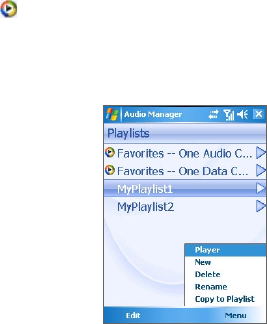
Experiencing Multimedia 167
Playlists
A playlist is a list of music files that play in a sequential order. The Playlists
screen shows the current playlists that are found on your device and
storage card.
There are two types of playlists that will be shown on the Playlists screen:
• Windows Media Player playlists.
These are playlists that are in Windows Media Player Mobile’s
Library (which is synchronized with Windows Media Player on your
computer), and they are indicated by the Windows Media Player icon
( ). They can be played in Audio Manager’s Music Player but cannot
be edited.
• Custom playlists.
These are playlists that are created in Audio Manager and can be
edited.
Notes • Audio Manager will search for playlists in the following locations:
On the device: \Playlists and \Application Data\HTC\AudioManager\
playlists.
On the storage card: \Storage Card\Playlists.
•
If a Windows Media Player playlist contains a combination of music, video
and image files, Audio Manager accesses the music files only and filters
out the other media types.
168 Experiencing Multimedia
To create a playlist
1. On the Library’s Main screen, tap Playlists.
2. On the Playlists screen, tap Menu > New.
3. Enter a Playlist name and tap OK.
4. On the Playlists screen, tap the playlist you have just created and tap
Edit.
5. Tap Menu > Add.
6. Tap the check boxes to select the songs you want to add to the
playlist, then tap OK. Tap Menu to open a list of selection methods.
7. Tap OK twice.
To play a playlist
1. On the Playlists screen, tap to select a playlist.
2. Tap the first song in the selected playlist. Music Player automatically
opens and starts playing the first song. After each song, the next one
in the playlist will be played.
Note The content of playlists is not automatically updated when music files have
been deleted from the device memory or storage card. Music Player will
display a notification message when you play back a playlist and music files
in that playlist cannot be found.
To edit a playlist
1. On the Playlists screen, select a playlist you want to edit.
2. Tap Edit.
3. Tap Menu to open a list of editing options. You can choose to add
more songs, copy or delete songs, and more.
4. After you have finished editing the playlist, tap OK twice.
5. To return to the Playlists screen, tap the playlist name that’s shown at
the top of the screen.
To add a playlist to another playlist
1. On the Playlists screen, use the NAVIGATION Control to scroll to the
playlist that you want to add to another playlist.
2. Tap Menu > Copy to Playlist.
3. Tap the playlist where to copy it to, then tap OK. Tap New Playlist if
you want to add the playlist to a new playlist.
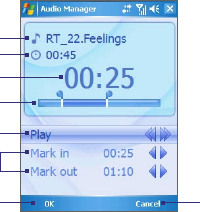
Experiencing Multimedia 169
Set music as ring tone
Audio Manager allows you to select your favorite music and set it as a ring
tone for your device.
1. Use the NAVIGATION Control to select a song in the Library, or tap a
song to play it in Music Player.
2. Tap Menu > Set as Ring Tone.
3. If the selected song is in MP3 format, you can trim it first to make it
shorter. Tap Trim to open the MP3 Trimmer and trim the song. For
more information about trimming, see “MP3 Trimmer”.
4. Tap Set as Default Ring Tone.
5. A confirmation message is then displayed. Tap OK.
Tip If you only want to save the song to the ring tone folder for future use, tap
Save to Ring Tone Folder. Later on, you can tap Start > Settings > Personal
tab > Phone to set it as your ring tone.
MP3 Trimmer
Before setting an MP3 file as a ring tone for your device, you can edit the
song first to shorten the duration and make the file size smaller. Use the
available controls on the MP3 Trimmer to cut the song shorter.
1
3
5
7
2
8
6
4
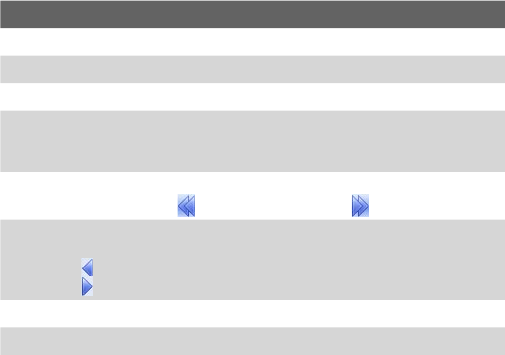
170 Experiencing Multimedia
No. Description
1Title. Shows the ring tone name for the song.
2Duration. Shows the length of the song after trimming.
3Time. Shows the playback time when the song is played.
4Trimmer. Allows you to mark the part of the song that will be used for the
ring tone. Drag the left handle to mark the start time (mark-in point), then
drag the right handle to mark the end time (mark-out point).
5Play/Stop. Tap to toggle between playing and stopping playback. While
playing, tap and hold to rewind, or tap and hold to fast forward.
6Mark in/Mark out. Allows precise marking of the start and end times of the
song that will be used for the ring tone.
• Tap to step backward one second and mark it; or
• Tap to step forward one second and mark it.
7OK. Tap to confirm trimming the ring tone.
8Cancel. Tap to exit MP3 Trimmer without trimming the ring tone.
172 Using Other Applications
9.1 Word Mobile
Word Mobile is a streamlined version of Microsoft Word. Word documents
created on your PC can be opened and edited on your device. You can also
create and edit documents and templates in Word Mobile and save them as
*.doc, *.rtf, *.txt, and *.dot files.
You can have only one document open at a time. When you open a second
document, the first one is saved and closed automatically.
To create a Word file
1. In Word Mobile, tap New. You will see either a blank document or
template, depending on what you have selected as the default
template.
2. Enter text as desired.
3. Tap Menu, then choose whether to set the font, paragraph alignment
and indentation, insert the date, do a spelling check, and more.
4. When finished, tap OK to save and close the file.
When you close a newly created document, it is automatically named
after the first several words in the document and placed in the Word
Mobile document list. You can easily rename the document with a more
meaningful name and move it to another folder or a storage card.
Note Word Mobile does not fully support some features of Microsoft Word, such
as revision marks and password protection. Some data and formatting may
be lost when you save the document on your device. To see a complete list of
features that are not supported in Word Mobile, see Help on your device.
Using Other Applications 173
9.2 Excel Mobile
Excel Mobile makes it easy for you to open and edit Excel workbooks and
templates created on your PC. You can also create new workbooks and
templates on your device.
To create an Excel file
1. In Excel Mobile, tap New. You’ll see either a blank worksheet or
template, depending on what you’ve selected as the default template.
2. Tap a cell to select it. Using the on-screen keyboard, enter your data
then tap the Enter key.
3. Tap Menu, then choose whether to insert cells, charts, symbols or
functions, format rows and columns, and more.
4. When finished, tap OK to save and close the file.
Tips • Work in full-screen mode to see as much of your workbook as possible.
• Tap View > Zoom and select a percentage so that you can easily read the
worksheet.
Note Excel Mobile does not fully support some features, such as formulas and
cell comments. Some data and formatting may be lost when you save the
workbook on your device. To see a complete list of features that are not
supported in Word Excel, see Help on your device.

174 Using Other Applications
9.3 Viewing Slide Shows with PowerPoint Mobile
With PowerPoint Mobile, you can open and view slide show presentations
created on your PC. Slide shows in *.ppt and *.pps format created using
PowerPoint '97 and later can be viewed in PowerPoint Mobile.
Many presentation elements built into the slide shows, such as slide
transitions and animations will play back on the device. If the presentation
is set up as a timed slide show, one slide will advance to the next
automatically. Links to URLs are also supported.
Features not supported in PowerPoint Mobile include:
• Notes. Notes written for slides will not be visible.
• Rearranging or editing slides. PowerPoint Mobile is a viewer only.
• Some file formats. Files created in *.ppt format earlier than
PowerPoint '97 and HTML files in *.htm and *.mht formats are not
supported.
To start a slide show presentation
1. Tap Start > Programs > PowerPoint Mobile.
2. In the presentation list, tap the slide show you want to view.
3. Tap the current slide to advance to the next slide.
4. To navigate between slides, tap > Next or Previous, or tap Go to
Slide and tap the slide you want to view.
If the presentation is set up as a timed slide show, slides will advance
automatically.
Notes • If you have zoomed in to see a slide in more detail, you cannot navigate to
another slide until you zoom out.
•
Tapping Next or Previous may play an animation on a slide rather than
navigate to another slide.
To stop a slide show
• In a PowerPoint Mobile presentation, tap > End Show.
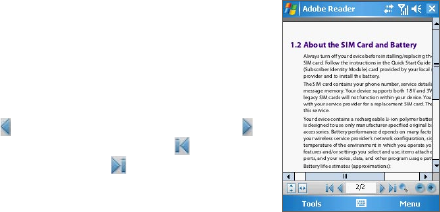
Using Other Applications 175
9.4 Using Adobe Reader LE
Adobe Reader LE is an application for viewing PDF (Portable Document
Format) documents on your device. It supports a subset of the features
found in the PC versions of Adobe Reader.
To open a PDF file on your device
Do one of the following:
• Tap Start > Programs > Adobe Reader LE. Browse the folders on
your device or storage card and find the desired PDF file. Tap the file
to open it.
• Open File Explorer and find the desired PDF file, then double-tap the
file to open it.
To navigate through a PDF document
When you are viewing a PDF document, you can do any of the following:
• Use the vertical and horizontal scroll bars
(including the Up, Down, Right and Left
arrow keys on the bars) to move to the
desired direction of the page.
• Press NAVIGATION up/down/right/left to
move to the desired direction of the page.
• Tap to move to the previous page; tap
to move to the next page. Tap to jump
to the first page; tap to jump to the last
page.
• Tap Tools > Go To to select the desired
page to view.
To adjust the display size
Tap Tools > Zoom, then select one of the following options:
• Select In/Out to enlarge/reduce the display size; or
• Select To % to specify a zoom ratio using a slider (from 8% to 1000%);
or
• Select Fit Screen to display the entire page in the window, or select
Fit Width to make the page width fit in the width of the window.

176 Using Other Applications
Tips Alternatively, you can also tap the following toolbar buttons at the bottom of
the screen:
• Tap to Fit Screen; tap to Fit Width.
•
Tap to zoom in; tap to zoom out.
To rotate the view
• Tap Tools > View > Rotate Right to rotate the document view
clockwise in 90 degree increments.
• Tap Tools > View > Rotate Left to rotate the document view
counterclockwise in 90 degree increments.
To change the page layout
• Tap Tools > View > Single Page to display one page at a time in the
document pane.
• Tap Tools > View > Continuous to display the pages in a continuous
vertical column.
To search for text in the document
1. Tap Tools > Find > Text or tap on the toolbar.
2. Type in the text to be searched, then tap Find.
3. The matched text in the document will be highlighted.
4. To search for the next occurrence of the text, tap Tools > Find > Next.
To exit Adobe Reader LE
• Tap Menu > Exit.
Tips • Adobe Reader LE displays a bookmark pane for the PDF files that contain
bookmarks. Tap the bookmarks to go to a specific section/page within the
file.
• Adobe Reader LE supports password-protected PDF files with up to 128-
bit encryption. When you open a password-protected PDF file, you will be
prompted to enter the password before the file can be opened.
Using Other Applications 177
9.5 Using MIDlet Manager
MIDlets are Java applications that can run on mobile devices. Your device
supports Java 2 Micro Edition, J2ME. The MIDlet Manager allows you to
download Java applications, such as games and tools that are specifically
designed for mobile devices. Although some Java applications and games
have already been installed on your device, the Java MIDlet Manager gives
you the flexibility of installing and managing additional J2ME applications
from the Internet.
To install MIDlets from the Internet
1. Locate the MIDlet/MIDlet suite while connected to the Internet.
2. Select the MIDlet/MIDlet suite to download.
3. Confirm to start downloading.
4. Run the file(s) to install.
To install MIDlets from a PC
You can install the MIDlets/MIDlet suites on your device from a PC using
the USB sync cable or Bluetooth. MIDlets copied to your device are
automatically saved in the My Documents folder. However, you can copy
the MIDlet file(s) from a PC to any of the following temporary folders on
your device from where MIDlet Manager can install them.
• Device memory: ..\My Device\My Documents\My MIDlets
• Storage card: ..\My Device\Storage Card
Note If the My MIDlets folder does not exist in My Documents, you can create
one with the same folder name. However, a folder named Storage Card
automatically appears after you insert a storage card into your device.
To install a MIDlet/MIDlet suite
1. Tap Start > Programs > MIDlet Manager > Menu > Install > Local.
2. From the list, tap the MIDlet/MIDlet suite that you want to install.
3. Confirm to complete the installation.
Note To remove a MIDlet file from the temporary folder, tap and hold the file then
tap Delete from the shortcut menu.
178 Using Other Applications
To run MIDlets on your device
1. Tap Start > Programs > MIDlet Manager.
2. Tap a MIDlet to run.
To view the MIDlets currently running
• Tap the down arrow on the top left of the MIDlet Manager screen,
then tap Running.
Note To view the most recently used MIDlets, tap Show > Recent.
To stop running a MIDlet
1. Tap the down arrow on the top left of the MIDlet Manager screen,
then tap Running.
2. Tap and hold a MIDlet on the Running MIDlets screen, and tap Stop.
Note
To stop all MIDlets currently running on your device, tap Menu > Stop All.
Manage MIDlets/MIDlet suites
You can organize the MIDlets into groups and define custom groups. You
can also change the default settings for a MIDlet.
To associate a MIDlet/MIDlet suite to a group
If you installed several MIDlets/MIDlet suites to your device, you can
categorize them into groups.
1. Tap and hold on a MIDlet/MIDlet suite, then tap Group.
2. Choose a preset group, or tap New if you want to create a custom
group, then tap OK.
After you have assigned MIDlets/MIDlet suites to respective groups, the
group names will appear in the Show menu and you can display them by
group.
To select a sorting order
1. Tap the down arrow on the top right of the MIDlet Manager screen to
open the Sort By menu.
2. Choose to sort by Name or by Size.
Using Other Applications 179
To change the display name of a MIDlet
1. Tap and hold a MIDlet, and tap Rename.
2. Enter a new name for the MIDlet, then tap OK.
Note You cannot change the name of a MIDlet suite.
To uninstall a MIDlet/MIDlet suite
Before you uninstall a MIDlet/MIDlet suite, make sure that it is not running.
1. Tap and hold the MIDlet/MIDlet suite, and tap Uninstall.
2. Tap OK to confirm.
Note You cannot uninstall a single MIDlet from a MIDlet suite; you can uninstall
only the complete MIDlet suite.
To check storage space
• Tap Menu > System Info on the MIDlet Manager screen to see how
much device storage space is used by MIDlets.
To select a type of connection
• Tap Menu > Choose Network Type on the MIDlet Manager screen,
and select the type of connection that you will use for downloading
MIDlets to your device.
To configure MIDlet security
You can adjust security settings for each MIDlet/MIDlet suite.
1. Tap and hold a MIDlet.
2. Tap Security from the shortcut menu.
Note that some features may not be available for all MIDlets/MIDlet suites.
The following are the security options that you can set for a running MIDlet/
MIDlet suite.

180 Using Other Applications
Security Option Description
Net Access Determine whether a MIDlet/MIDlet suite can access the
Internet.
Local Connectivity Enable a MIDlet/MIDlet suite to access services, such as
Bluetooth.
App Auto Run Enable a MIDlet/MIDlet suite to run at specified times, or
any time.
Messaging Determine whether a MIDlet/MIDlet suite can send and/or
receive SMS messages.
Multimedia
Recording Enable a MIDlet/MIDlet suite to record sounds and images.
Note For a list of error messages that you may receive while managing and using
MIDlets/MIDlet suites on your device, see Help on your device.
9.6 Using ZIP
This feature allows you to save memory and increase the storage capacity
of your device by compressing files in the conventional ZIP format. You can
view and extract archive files received from various sources. You can also
create new *.zip files on your device.
Start ZIP and Open .zip files
You can use ZIP to either archive files or open an existing archive file on
your device. Each time you start ZIP on your device, it searches for files
that have the .zip file extension, and displays these files on the Archive List
screen.
To start ZIP on your device
• Tap Start > Programs > ZIP.
To open a ZIP file and extract files
1. Open a file using any of the following:
• Select a file and tap File > Open Archive.
• Tap and hold a file and tap Open Archive.
• Double-tap a file.
Using Other Applications 181
Note You cannot select multiple ZIP files.
2. The files contained in the zip file are then displayed. Select files by
doing one of the following:
• Tap to select a file.
• To select several files, tap Action and make sure Multi-Select
Mode is selected. Select files by tapping each file. (Tap a selected
file to deselect it).
• To select all files, tap Action > Select All.
3. Tap Action > Extract.
4. Choose a folder in which files will be extracted to, then tap Extract.
To create a zip archive
1. Tap File > New Archive.
2. On the Save As screen, enter a zip file name and choose a folder in
which to save the zip file. You can also choose whether the zip file will
be saved on the device’s main memory or a storage card.
3. Tap Save.
4. Tap Action > Add.
5. Double-tap the folder that contains the files you want to archive.
6. Select files by doing one of the following:
• Tap to select a file.
• To select several files, tap and hold on the screen, then select
Multi-Select Mode. Select files by tapping each file. (Tap a
selected file to deselect it).
• To select all files, tap and hold on the screen, then tap Select All.
7. Tap Add.
8. Tap File > Close Archive.
9. After closing the zip file, you can tap File > Find Archive to search for
all zip files and display them on the Archive List screen.
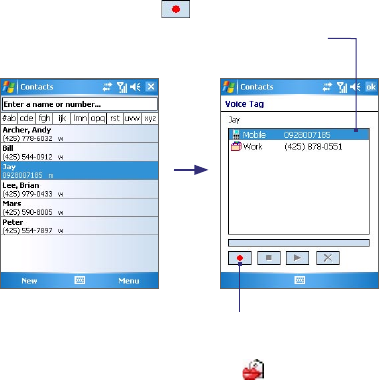
182 Using Other Applications
9.7 Using Voice Speed Dial
You can record voice tags so that you can dial a phone number or launch
programs simply by speaking a word.
Create a voice tag for a phone number
1. Tap Start > Contacts to open the Contacts list.
2. Do one of the following:
• Tap and hold the desired contact, then tap Add Voice Tag.
• Select the desired contact, then tap Menu > Add Voice Tag.
• Tap the desired contact to open the contact’s detailed screen, then
tap Menu > Add Voice Tag.
3. Select the phone number that you want to create a voice tag, then
tap the Record button ( ).
Select the desired
phone number.
Tap the Record button to
start recording.
4. When completed, a Voice Tag icon ( ) will be displayed on the
right of the item.

Using Other Applications 183
5. When you create a voice tag for the item, you can do one of the
following:
• Tap the Record button ( ) to rebuild the voice tag.
• Tap the Play button ( ) to play the voice tag.
• Tap the Delete button ( ) to delete the voice tag.
Tip To ensure voice recognition accuracy, please record your voice in a quiet
place.
Create a voice tag for a program
1. Tap Start > Settings > Personal tab > Voice Speed Dial.
2. The Application tab displays a list of all installed programs on your
device. The procedure for creating a voice tag for a program is the
same as the procedure for creating a voice tag for a phone number.
3. After you have created a voice tag for a program, you can then launch
the program by saying the recorded voice tag after pressing the
VOICE COMMAND button.
Make a call or launch programs using a voice tag
1. Press the VOICE COMMAND button.
2. After a “beep” sound, say the recorded voice tag that you have
assigned to the phone number you want to call or the program you
want to launch. The system will repeat the voice tag and then dial out
or launch the program automatically.
Note If the system cannot recognize your voice tag, please speak clearly and
reduce the surrounding noise, then try again.
To view and test the voice tags you have created
1. Tap Start > Settings > Personal tab > Voice Speed Dial.
2. The Voice Tag tab displays a list that contains all the voice tags you
have created. Select an item in the list, and you can do one of the
following:
• Tap the Record button ( ) to rebuild the voice tag.
• Tap the Play button ( ) to play the voice tag.
• Tap the Delete button ( ) to delete the voice tag.
184 Using Other Applications
186 Appendix
A.1 Regulatory Notices
Agency identification numbers
For regulatory identification purposes, your product (Pocket PC Phone) is
assigned a model number of GENE100. The Battery Pack has been assigned
a model number of GENE160 and WIZA16.
To ensure continued reliable and safe operation of your device, use only the
accessories listed in this document.
Note This product is intended to be used with a certified class 2 limited power
source, rated 5 volts DC, maximum 1A power supply unit.
European Union Notice
Products with CE marking comply with the R&TTE Directive (99/5/EC), the
EMC Directive (89/336/EEC) and the Low Voltage Directive (73/23/EEC)
issued by the Commission of the European Community.
Compliance with these directives implies conformity to the following
European Norms:
• EN 60950-1 (IEC 60950-1)
Safety of InformationTechnology Equipment.
• ETSI EN 300 328
Electromagnetic compatibility and Radio spectrum Matters (ERM);
Wideband Transmission systems; data transmission equipment
operating in the 2.4 GHz ISM band and using spread spectrum
modulation techniques.
• ETSI EN 301 511
Global System for Mobile communications (GSM); Harmonized
standard for mobile stations in the GSM 900 and DCS 1800 bands
covering essential requirements under article 3.2 of the R&TTE
directive (1999/5/EC).
• ETSI EN 301 489-1
Electromagnetic compatibility and Radio spectrum Matters (ERM);
ElectroMagnetic Compatibility (EMC) standard for radio equipment
and services; Part 1: Common technical requirements.
• ETSI EN 301 489-7
Electromagnetic compatibility and Radio spectrum Matters (ERM);
Appendix 187
ElectroMagnetic Compatibility (EMC) for radio equipment and
services; Part 7: Specific conditions for mobile and portable radio
and ancillary equipment of digital cellular radio telecommunications
systems (GSM and DCS).
• ETSI EN 301 489-17
Electromagnetic compatibility and Radio spectrum Matters (ERM);
ElectroMagnetic Compatibility (EMC) standard for radio equipment
and services; Part 17: Specific conditions for 2.4 GHz wideband
transmission systems.
• EN 50360 - 2001
Product standard to demonstrate the compliance of mobile
phones with the basic restrictions related to human exposure to
electromagnetic fields (300 MHz - 3 GHz).
Federal Communications Commission Notice
This device complies with part 15 of the FCC Rules. Operation is subject
to the following two conditions: (1) This device may not cause harmful
interference, and (2) this device must accept any interference received,
including interference that may cause undesired operation.
This equipment has been tested and found to comply with the limits for a
Class B digital device, pursuant to Part 15 of the FCC Rules. These limits are
designed to provide reasonable protection against harmful interference in
a residential installation. This equipment generates, uses, and can radiate
radio frequency energy and, if not installed and used in accordance with
the instructions, may cause harmful interference to radio communications.
However, there is no guarantee that interference will not occur in a
particular installation. If this equipment does cause harmful interference to
radio or TV reception, which can be determined by turning the equipment
on and off, the user is encouraged to try to correct the interference by one
or more of the following measures:
• Reorient or relocate the receiving antenna.
• Increase the separation between the equipment and receiver.
• Connect the equipment into an outlet on a circuit different from that
to which the receiver is connected.
• Consult the dealer or an experienced radio or television technician for
help.
188 Appendix
Modifications
The FCC requires the user to be notified that any changes or modifications
made to the device that are not expressly approved by High Tech Computer
Corporation may void the user’s authority to operate the equipment.
Important safety information
Retain and follow all product safety and operating instructions. Observe all
warnings on the product and in the operating instructions.
To reduce the risk of bodily injury, electric shock, fire, and damage to the
equipment, observe the following precautions.
Safety precautions for RF exposure
Use only original manufacturer-approved accessories, or accessories that do
not contain any metal.
Use of non-original manufacturer-approved accessories may violate your
local RF exposure guidelines and should be avoided.
Heed service markings
Except as explained elsewhere in the Operating or Service documentation,
do not service any product yourself. Service needed on components inside
these compartments should be done by an authorized service technician or
provider.
Damage requiring service
Unplug the product from the electrical outlet and refer servicing to an
authorized service technician or provider under the following conditions:
• Liquid has been spilled or an object has fallen into the product.
• The product has been exposed to rain or water.
• The product has been dropped or damaged.
• There are noticeable signs of overheating.
• The product does not operate normally when you follow the
operating instructions.
Avoid hot areas
The product should be placed away from heat sources, such as radiators,
heat registers, stoves, or other products (including amplifiers) that produce
heat.
Appendix 189
Avoid wet areas
Never use the product in a wet location.
Avoid pushing objects into product
Never push objects of any kind into cabinet slots or other openings in the
product. Slots and openings are provided for ventilation. These openings
must not be blocked or covered.
Mounting accessories
Do not use the product on an unstable table, cart, stand, tripod, or bracket.
Any mounting of the product should follow the manufacturer’s instructions,
and should use a mounting accessory recommended by the manufacturer.
Do not place the product with an unstable base.
Use product with approved equipment
This product should be used only with personal computers and options
identified as suitable for use with your equipment.
Adjust the volume
Turn down the volume before using headphones or other audio devices.
Cleaning
Unplug the product from the wall outlet before cleaning. Do not use liquid
cleaners or aerosol cleaners. Use a slightly damp cloth for cleaning, but
NEVER use water to clean an LCD screen.
Safety precautions for power supply unit
Use the correct external power source
A product should be operated only from the type of power source indicated
on the electrical ratings label. If you are not sure of the type of power source
required, consult your authorized service provider or local power company.
For a product that operates from battery power or other sources, refer to
the operating instructions that are included with the product. Handle
battery packs carefully: This product contains a Lithium-Ion battery.
There is a risk of fire and burns if the battery pack is handled improperly. Do
not attempt to open or service the battery pack. Do not disassemble, crush,
puncture, short external contacts or circuits, dispose of in fire or water, or
expose a battery pack to temperatures higher than
140° F (60° C).
190 Appendix
Exposure to radio frequency (RF) signals
Your wireless phone is a radio transmitter and receiver. It is designed and
manufactured not to exceed the emission limits for exposure to radio
frequency (RF) energy. These limits are part of comprehensive guidelines
and establish permitted levels of RF energy for the general population. The
guidelines are based on the safety standards previously set by international
standards bodies:
• American National Standards Institute (ANSI) IEEE. C95.1-1992
• National Council on Radiation Protection and Measurement (NCRP).
Report 86. 1986
• International Commission on Non-Ionizing Radiation Protection
(ICNIRP) 1996
• Ministry of Health (Canada), Safety Code 6. The standards include a
substantial safety margin designed to assure the safety of all persons,
regardless of age and health.
The exposure standard for wireless mobile phones employs a unit of
measurement known as the Specific Absorption Rate, or SAR.
The standard incorporates a substantial margin of safety to give additional
protection for the public and to account for any variations in usage.
Normal conditions only ensure the radiative performance and safety of the
interference. As with other mobile radio transmitting equipment, users are
advised that for satisfactory operation of the equipment and for the safety of
personnel, it is recommended that no part of the human body be allowed to
come too close to the antenna during operation of the equipment.
Tests for SAR are conducted using standard operating positions specified by
the FCC with the phone transmitting at its highest certified power level in
all tested frequency bands. Although the SAR is determined at the highest
certified power level, the actual SAR level of the phone while operation can
be well below the maximum value. This is because the phone is designed
to operate at multiple power levels so as to use only the power required to
reach the network. In general, the closer you are to a wireless base station
antenna, the lower the power output. Before a phone model is available
for sale to the public, it must be tested and certified to the FCC that it does
not exceed the limit established by the government-adopted requirement
for safe exposure. The tests are performed in positions and locations (for
example, at the ear and worn on the body) as required by the FCC for

Appendix 191
each model. (Bodyworn measurements may differ among phone models,
depending upon available accessories and FCC requirements). For body
worn operation, to maintain compliance with FCC RF exposure guidelines,
use only original manufacturer approved accessories. When carrying the
phone while it is on, use the specific original manufacturer supplied or
approved carrying case, holster, or other body-worn accessory.
SAR Information
• CE: 0.393 mW/g @10g (Head)
1.32 mW/g @10g (Body)
• FCC: 0.448 mW/g @1g (Head)
1.39 mW/g @1g (Body)
Telecommunications & Internet Association (TIA) safety
information
Pacemakers
The Health Industry Manufacturers Association recommends that a
minimum separation of six inches be maintained between a handheld
wireless phone and a pacemaker to avoid potential interference with the
pacemaker. These recommendations are consistent with the independent
research by and recommendations of Wireless Technology Research.
Persons with pacemakers:
• Should ALWAYS keep the phone more than six inches from their
pacemaker when the phone is turned ON.
• Should not carry the phone in a breast pocket.
• Should use the ear opposite the pacemaker to minimize the potential
for interference. If you have any reason to suspect that interference is
taking place, turn the phone OFF immediately.
Hearing Aids
Some digital wireless phones may interfere with some hearing aids. In the
event of such interference, you may want to consult your service provider,
or call the customer service line to discuss alternatives.

192 Appendix
Other Medical Devices
If you use any other personal medical device, consult the manufacturer
of your device to determine if they are adequately shielded from external
RF energy. Your physician may be able to assist you in obtaining this
information.
Turn the phone OFF in health care facilities when any regulations posted in
these areas instruct you to do so. Hospitals or health care facilities may be
using equipment that could be sensitive to external RF energy.
Other tips and cautions
• Avoid using your phone near metal structures (for example, the steel
frame of a building).
• Avoid using your phone near strong electromagnetic sources, such as
microwave ovens, sound speakers, TV and radio.
• Avoid using your phone after a dramatic change in temperature.
Safety Precautions
SAFETY IN AIRCRAFT: This product can cause interference to an aircraft’s
navigation system and network. In most countries it is against the law to
use this product on board an airplane.
ENVIRONMENTAL SAFETY: Do not use this product in gas stations, fuel
stores, chemical plants and locations containing explosives.
ROAD SAFETY: Vehicle drivers in motion are not permitted to use
handheld telephony services, except in emergency. In some countries,
using hands-free devices as an alternative is allowed.
MEDICAL EQUIPMENT SAFETY: This product may cause medical
equipment malfunction. In most hospitals or medical centers use of this
product is forbidden.

Appendix 193
WEEE Notice
The Directive on Waste Electrical and Electronic Equipment (WEEE), which
entered into force as European law on 13th February 2003, resulted in a
major change in the treatment of electrical equipment at end-of-life.
The purpose of this Directive is, as a first priority, the prevention of WEEE,
and in addition, to promote the reuse, recycling and other forms of recovery
of such wastes so as to reduce disposal.
The WEEE logo (shown at the left) on the product or on its box
indicates that this product must not be disposed of or dumped
with your other household waste. You are liable to dispose of all
your electronic or electrical waste equipment by relocating over
to the specified collection point for recycling of such hazardous
waste. Isolated collection and proper recovery of your electronic
and electrical waste equipment at the time of disposal will
allow us to help conserving natural resources. Moreover, proper
recycling of the electronic and electrical waste equipment will
ensure safety of human health and environment. For more
information about electronic and electrical waste equipment
disposal, recovery, and collection points, please contact your
local city center, household waste disposal service, shop from
where you purchased the equipment, or manufacturer of the
equipment.
RoHS Compliance
This product is in compliance with Directive 2002/95/EC of the European
Parliament and of the Council of 27 January 2003, on the restriction of the
use of certain hazardous substances in electrical and electronic equipment
(RoHS) and its amendments.
194 Appendix
A.2 PC Requirement to Run ActiveSync 4.x
To connect your device to the PC, you must have Microsoft® ActiveSync®
program installed on your PC. ActiveSync 4.x is included in the Getting
Started Disc, which is compatible with the following operating systems
and applications:
• Microsoft® Windows® 2000 Service Pack 4
• Microsoft® Windows Server® 2003 Service Pack 1
• Microsoft® Windows Server® 2003 IA64 Edition Service Pack 1
• Microsoft® Windows Server® 2003 x64 Edition Service Pack 1
• Microsoft® Windows® XP Professional Service Packs 1 and 2
• Microsoft® Windows® XP Home Service Packs 1 and 2
• Microsoft® Windows® XP Tablet PC Edition 2005
• Microsoft® Windows® XP Media Center Edition 2005
• Microsoft® Windows® XP Professional x64 Edition
• Microsoft® Outlook® 98, Microsoft® Outlook® 2000 and Microsoft®
Outlook® XP, and Microsoft® Outlook® 2003 messaging and
collaboration clients
• Microsoft® Office 97, excluding Outlook
• Microsoft® Office 2000
• Microsoft® Office XP
• Microsoft® Office 2003
• Microsoft® Internet Explorer® 4.01 or later (required)
• Microsoft® Systems Management Server 2.0

Appendix 195
A.3 Specifications
System Information
Processor TI's OMAPTM 850, 201 MHz
Memory - ROM : 128 MB
- RAM : 64 MB SDRAM
(Figures are the total ROM and RAM memory available
for use and storage. Since the memory is shared by the
Operating System, applications, and data, the actual
available memory is less than what is written).
Operating System Windows Mobile® Version 5.0 Pocket PC Phone Edition
Power
Battery Rechargeable Lithium-ion battery, 1250 mAh
Charging Time Up to 3 hours
Battery Life
(estimates)
Standby time: Up to 150 - 200 hours
Talk time (Screen off): Up to 3.5 - 5 hours
Media playback time: Up to 8 hours (WMV);
Up to 12 hours (WMA)
AC Adapter Voltage range/frequency: 100 - 240V AC, 50/60 Hz
DC output: 5V and 1A
Display
LCD Type 2.8” transflective TFT-LCD with backlight LEDs, touch-
sensitive screen
Resolution 240 x 320 with 65,536 colors
Alignment Portrait and Landscape
GSM / GPRS / EDGE Module
Functionality Quad-band (850, 900, 1800, and 1900)
Internal Antenna Yes
Physical
Dimensions 109 mm (L) x 58 mm (W) x 17.65 mm (T)
Weight 126 g (with battery)
Expansion Slots
Card Slot SD™ card

196 Appendix
Camera Module
Type 2 Megapixel color CMOS camera
Resolution Photo: 1600x1200 (UXGA), 1280x960 (SXGA), 640x480
(VGA), 320x240 (QVGA), 160x120 (QQVGA)
Video: 176x144 (QCIF), 128x96
Digital Zoom Up to 10X
Connections
I/O Port HTC ExtUSBTM : an 11-pin mini-USB and audio jack in one
(ExtUSB is a proprietary connection interface that is
trademarked by HTC).
Car Antenna
Connector
Yes
Wireless
Connections
Bluetooth 2.0
Controls and Lights
Buttons • 5-way NAVIGATION Control
• Two program buttons : Voice Speed Dial/Voice Record
and Camera
• Two phone functions : TALK and END
• START button
• OK button
• Two SOFT KEYs
• POWER button
• RESET button
LEDs The left (bi-color) LED shows Green and Amber lights for
GSM/GPRS/EDGE standby, message, and network status as
well as for notification and battery charging status.
The right LED shows a blinking Blue light for Bluetooth
system notification of powered-up and ready to transmit
Bluetooth signal.
Audio
Audio Controller AGC
Microphone/
Speaker
Built-in/Dual, Hands-free
Headphone AMR/AAC/WAV/WMA/MP3 codec
Index
198 Index
A
About licenses and protected media
159
ActiveSync
- Comm Manager 92
- copy files 78
- install and set up 54
- overview 28
- synchronize 58
Add and remove programs 76
Add attachment to message 117
Adobe Reader LE 175
- adjust display size 175
- change page layout 176
- exit 176
- navigate through document 175
- overview 28
- rotate the view 176
- search for text in the document
176
Alarm 71
Answer/end a call 47
Appointment search 40
Assign pictures to contacts 156
Assign programs or shortcuts to
hardware buttons 71
Attachments 117
Audio Manager 164
- Library 164
- MP3 Trimmer 169
- Music Player 166
- Playlists 167
- Set music as ring tone 169
B
Backlight 73
Battery
- battery information 21
- charge battery 22
- check battery power 22
- save battery power 72
Beam
- via Bluetooth 96
Block Recognizer 38
Bluetooth
- Bluetooth Explorer 28, 98
- Bluetooth file sharing 98
- Bluetooth modem 101
- Bluetooth shared folder 98
- hands-free headset 95
- modes 93
- overview 93
- partnership (pairing) 94
- SIM Access Profile (SAP) 52
- stereo headset 95
- synchronize 62
- turn on and off 92
- visible 93, 94
Bluetooth Explorer 28
Burst capture mode 141
C
Calculator 28
Calendar 29, 128
Calendar search 40
Calibration 24
Camera
- capture modes 140, 141
- controls 141
Index 199
- file formats 141
- icons 141
- overview 29
- settings 148
- specifications 196
Change
- device name 70
- screen text size 72
Clock & Alarms 32, 70
Close program 78
Comm Manager 33, 92
Compose messages 115
Conference call 50
Connect device to Internet
- set up dial-up connection to ISP 88
- set up GPRS connection 86
- start a connection 88
Connect to private network 88
Contacts 29, 130
Contacts Picture capture mode 141
Contacts search 40
Cookies 91
Copy
- contacts to SIM card 132
- files between device and PC 78
- files to storage card 78
- media files from PC to device 160
- pictures and video clips from PC to
device 153
- SIM contacts to device 131
Customize
- Start menu 69
- Today screen 68
D
Date 70
Delete pictures and videos 155
Dial-up to ISP 88
Digitally sign messages 65, 119
Digital Rights Management (DRM) 159
Digital signature
- verify 120
Dimensions and weight 195
Direct Push 61, 92
Disconnect data services 92
Download Agent 29
Download messages 118
Draw 137
E
E-mail
- IMAP4 113
- Outlook 112
- POP3 113
- search 40
- security 64
- settings (POP3/IMAP4) 114
- setup wizard 112
Edit picture 155
Emergency call 51
Encrypt messages 65, 119
Excel Mobile 29, 173
Exchange Server
- schedule synchronization 60
- synchronize 60
Exclude e-mail address when replying
to all 116
200 Index
F
Favorites (Internet Explorer) 89
File Explorer 29
Find
- device information 72
- operating system version number
72
Find contact
- online 133
- on device 132
Forward message 116
G
Games 29
GIF animation 153
GPRS 86
GPRS Monitor 30, 103
H
Hard reset 82
Help 29
Help search 40
Home page (Internet Explorer) 89
I
IMAP4 113
Input methods
- Block Recognizer 38
- Keyboard 37
- Letter Recognizer 37
- Transcriber 38
Input Panel 36
Install and set up ActiveSync 54
International call 51
Internet Explorer Mobile 29, 89
Internet security settings 91
Internet Sharing 102
K
Keypad tone 74
L
Letter Recognizer 37
Library screen (Windows Media Player
Mobile) 159
M
Mail search 40
Make call
- from Call History 45
- from Contacts 45
- from Phone program 44
- from SIM Manager 46
- from Speed Dial 45
Media synchronization settings 63
Memory 77, 195
Message folders 120
Messaging
- IMAP4 113
- MMS 122
- Outlook e-mail 112
- overview 29
- POP3 113
- SMS 115
MIDlet Manager
- configure MIDlet security 179
- install MIDlets from Internet 177
- install MIDlets from PC 177
Index 201
- manage MIDlets/MIDlet suites 178
- overview 29, 177
- uninstall MIDlets/MIDlet suites 179
MMS 122
- add audio clip 126
- add emoticon 126
- add photo/video 124
- add text 126
- add Web page address from
Favorites 126
- create and send 124
- MMS settings 122
- reply message 127
- view message 127
MMS Video capture mode 141, 144
MSN Messenger 127
Mute 51
N
Notes 29, 40, 136
Notes search 40
Now Playing screen (Windows Media
Player Mobile) 159
O
On-screen keyboard 37
Open PDF file 175
Outlook e-mail 112
Owner information 81
P
Password 80
Personal and system settings 71
Phone 29, 42, 44
Phone network settings 75
Phone services 74
Phone settings 74
Pictures & Videos
- assign pictures to contacts 156
- delete 155
- edit picture 155
- file formats 153
- overview 29
- play GIF animation 153
- play videos 154
- sort 155
- view pictures 153
- view slideshows 155
Picture Theme capture mode 141
PIN 42, 80
Playback screen (Windows Media
Player Mobile) 159
Playlists 162
Play GIF animation 153
Play media 161
Play videos 154
Pocket MSN 30, 127
POP3 113
PowerPoint Mobile 30, 174
Programs
- ActiveSync 28
- Adobe Reader LE 28
- Audio Manager 28
- Bluetooth Explorer 28
- Calculator 28
- Calendar 29, 128
- Camera 29, 140
- Comm Manager 33, 92
- Contacts 29, 130
- Download Agent 29
- Excel Mobile 29, 173
- File Explorer 29
202 Index
- Games 29
- GPRS Monitor 30
- Help 29
- Internet Explorer Mobile 29, 89
- Internet Sharing 102
- Messaging 29, 112
- MIDlet Manager 29, 177
- Notes 29, 136
- Phone 29, 44
- Pictures & Videos 29, 153
- Pocket MSN 30, 127
- PowerPoint Mobile 30, 174
- SAPSettings 30
- Search 30, 40
- SIM Manager 30, 46, 131
- Spb GPRS Monitor 103
- STK (SIM Tool Kit) Service 30
- Tasks 30, 135
- Terminal Services Client 30, 108
- Voice Speed Dial 30, 182
- Windows Media Player Mobile 30,
157
- Word Mobile 30, 172
- ZIP 30, 180
Put call on hold 50
R
Receive call 47
Receive messages 115
Record voice note 138
Regional options 70
Regulatory notices 186
Reply message 116
Reply MMS 127
Reset
- hard reset 82
- soft reset 82
Review screen (Camera) 145
Ringer 92
Ring tone 74
Ring type 74
S
Save picture from Web page 91
Search 30, 40
Secure/Multipurpose Internet Mail
Extension (S/MIME) 64
Security settings (Internet Explorer) 91
Send messages 115
Send pictures and videos via e-mail
156
Settings (Connections tab)
- Beam 33
- Bluetooth 33
- Comm Manager 33
- Connections 33
- CSD Line Type 33
- GPRS Setting 33
- Network Card 33
- SMS Service 33
- USB to PC 33
Settings (Personal tab)
- Buttons 31
- Input 31
- Lock 31
- Menus 31
- MSN Options 31
- Owner Information 31
- Phone 31
- Sounds & Notifications 31
- Today 31
- Voice Speed Dial 31
Index 203
Settings (System tab)
- About 31
- Backlight 31
- Certificates 32
- Clear Storage 32
- Clock & Alarms 32
- Device Information 32
- Error Reporting 32
- Key Lock 32
- Memory 32
- Microphone AGC 32
- Power 32
- Regional Settings 32
- Remove Programs 32
- Screen 32
- Task Manager 32
Set picture as Today screen
background 156
SIM card 21
SIM Manager
- copy contacts to SIM card 132
- copy SIM contacts to device 131
- create SIM contact 131
- make call 46
- overview 30
Smart Dialing 47
SMS 115
Soft reset 82
Sounds & Notifications 72
Spb GPRS Monitor 30, 103
Speakerphone 50
Specifications 195
Speed Dial 45
Sports capture mode 141
Start menu 69
Still image capture modes 144
STK (SIM Tool Kit) Service 30
Storage card
- check available space 77
- copy files 79
- synchronize 63
Swap/switch calls 50
Synchronize
- ActiveSync 58
- change information types 59
- music and video 63
- Outlook information with computer
58
- Outlook information with Exchange
Server 60
- schedule synchronization with
Exchange Server 60
- via Bluetooth 62
- Windows Media Player 63
- Windows Media Player Mobile 160
Sync Setup Wizard 54
System information 195
T
Tasks 30, 135
Tasks search 40
Task Manager 73
Temporary Internet files (Internet
Explorer)
- delete 91
Terminal Services Client 108
Text size
- screen 72
- Web pages 90
Time 70
Today screen 25, 68
Transcriber 38
Troubleshoot Windows Media Player
Mobile 163
Turn device on and off 23
Turn phone function on and off 43, 92
U
USB modem 102
V
Verify digital signature 120
Vibrate 43, 92
Video capture mode 144
View
- MMS 127
- photo slideshows 155
- pictures 153
Voice call 44
Voice note 138
Voice Speed Dial
- create
- voice tag for phone number 182
- voice tag for program 183
- make call or launch program 183
- overview 30, 182
Voice tag
- create
- for phone number 182
- for program 183
- make call or launch program 183
Volume 43
W
Web pages
- layout 90
- text size 90
Windows Media Player Mobile
- file formats 157
- menus 159
- overview 30
- playlists 162
- troubleshoot 163
Word Mobile 30, 172
Z
ZIP
- create archive 181
- open zip file and extract files 180
- overview 30, 180
Zoom (Camera) 146








